ORIGINAL traveller





Spring - Summer 2023



It’s a cold, bright, January morning in 2003. After months of planning and research trips, Original Travel is officially open for business. Two friends and I have left, respectively, the City, the Army and Fleet Street, and are sitting side by side in a small spare bedroom converted into a rudimentary office. 2,000 copies of our (soon to be award-winning) first brochure have been sent out. The website is live. And we wait.
At 9.15am the phone rings for the first time and we exchange nervous glances. I reach for the phone... ‘Good morning, Original Travel, this is Tom speaking.... oh, hi Mum. Yes, thank you. OK, speak later. Bye.’ I put the phone down. ‘Mum says good luck.' 20 years and hundreds of thousands of phone calls later (many with my mother, still an avid traveller and the person who most nurtured my wanderlust) Original Travel has, like its clients, come a long way.
In this issue of Original Traveller we celebrate the destinations and experiences that have proven perennially popular since 2003, and others we believe will be the next generation of travel classics. Read about Swedish Lapland, the snowclad setting for the first ever Original Travel client trip, dog-sledding and chasing the Northern Lights. And Lisbon, a city break destination par excellence. Meanwhile, Colombia is our new crush, and a celebration of the fact that destinations can, and do, rise from the ashes. Elsewhere, Tokyo is the delicious distillation of all things Japan (arguably our all-time favourite destination); Jordan has been the quintessential Big Short Break destination from day one –a real pocket rocket of a place; and the US of A has proved a winner for families and couples alike for two decades now.
These represent just a small sample of the countries we have sent clients to; all places where they can experience our glorious planet at its finest. Along the way our clients are ably assisted by our global network of Concierges and colleagues in every Original Travel destination. They, together with the amazing team here in London and at our parent company in Paris, make a formidable global partnership, and one waiting to help you plan your next adventures to perfection.
All that remains is to say thank you to all the clients who have explored the world with us in the last two decades. It’s been quite a journey. We raise a toast to you all.
TOM BARBER, CO-FOUNDER OF ORIGINAL TRAVEL
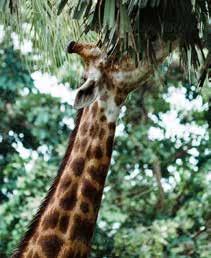




Rose van Cutsem is a freelance travel writer for The Sunday Times and Conde Nast Traveller and loves nothing more than catching waves and eating clams in Portugal.





Tamara Hinson is a freelance travel writer with a soft spot for Asia, snowboarding, diving and off-the-beaten-path destinations like North Korea and Togo.
ALIX PARDO photographer & photo editorSTEPHANIE
DRAXtravel writer & entrepreneur
Stephanie Drax is a freelance travel writer for the likes of House & Garden and the FT, and founded bioactive supplement brand Leapfrog Remedies.
FRAN KELLETT travel writer & agency founder

Freelance journalist Lucy Dunn lives in Hertfordshire with her family and hyperactive dog, Spud, and is terrible at maths.

Alix Pardo is a travel photographer, photo editor for Voyageurs du Monde and surfer. She lives in the French Basque Country.
Francisca Kellett is a travel writer and founder of Mundi & Co, a strategic and creative content agency for luxury, sustainable brands.
Richard Mellor realised he preferred writing about exotic places to PRing them to journalists, and crossed the floor. He now writes for The Times and others.
LIZZIE SHIPLEY travel writerLizzie Shipley hikes, bikes, freedives, trail runs, snowboards (badly) and writes in British Columbia, Canada.
Stanley Stewart is the award-winning author of three highly acclaimed travel books and several hundred articles on his adventures across five continents.

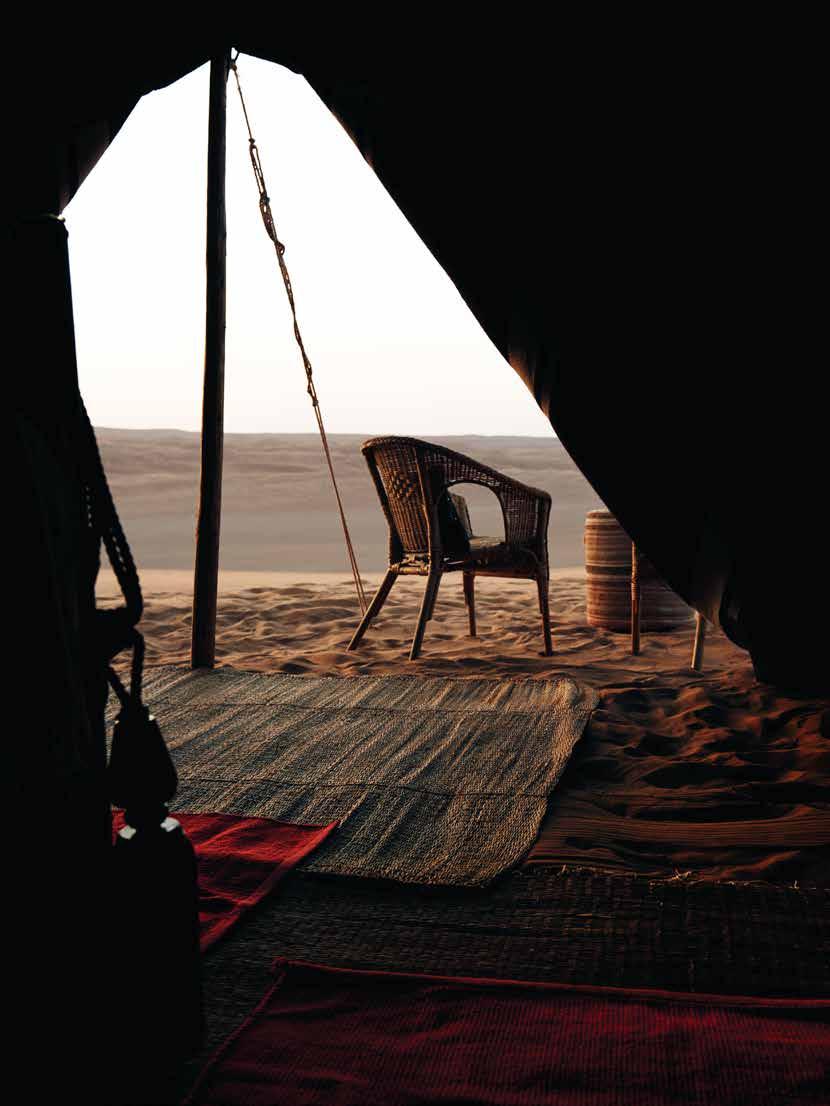
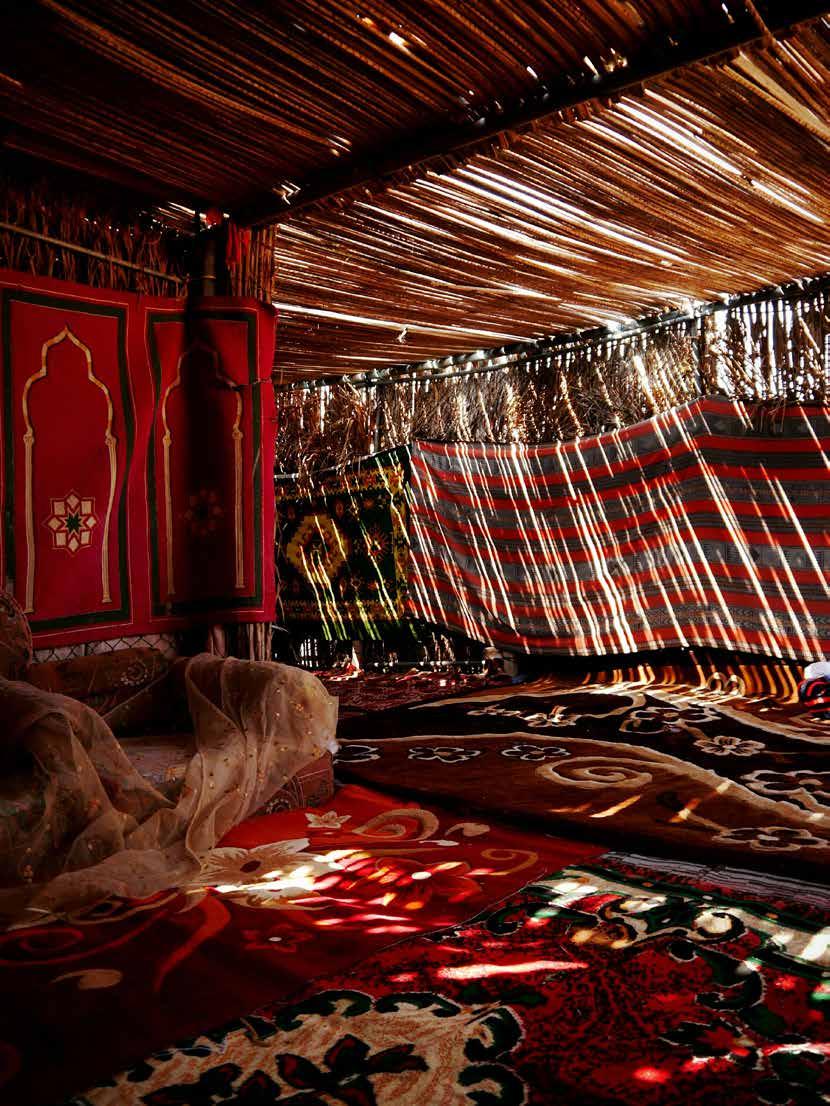


Tapas crawl like a local; take el treno in Italy; sign a ‘destination pledge’; stock up on the latest travel gear; dive into the finest scuba sites; go big in Ho Chi Minh; check out chimps in Tanzania; roam in Rome; cook Mexican like Tommi Miers and meet the world’s best safari moviemakers.

‘Sometimes I find myself wishing for winter so I can cosy up in my lopapeysa (pronounced ‘lo-pa-PEY-sa'). I bought it at the end of a magical trip to Iceland a few years ago after seeing many of the locals wearing them. These sweaters are made exclusively from the unspun wool of Iceland’s abundant flocks of sheep, who have braved the island’s harsh conditions for over a millennium and as a result developed two distinct layers of wool. These make lopapeysur (the plural) both water resistant and warm, as the unspun wool allows more air flow through the fibres, which in turn creates better insulation. Despite their traditional look, with patterns styled around local flowers or snowflakes, lopapeysur only really came to prominence in the 40s after Iceland’s independence from Denmark, becoming a symbol of the country’s identity. Nowadays it’s important to buy a genuine version because there are a lot of fakes around. The best place to pick one up is from the Handknitting Association of Iceland, which started life as a collective of female knitters in 1977 and now has a lovely shop on Skólavörðustígur street in downtown Reykjavík.’
 Kate Little, Europe Team www.originaltravel.co.uk
Kate Little, Europe Team www.originaltravel.co.uk
With pandemic related restrictions hopefully a thing of the past, it's full steam ahead for the travel industry. On the radar are new flight routes, hotel brands and even entirely new ways of travelling. Enjoy the new golden age of travel...
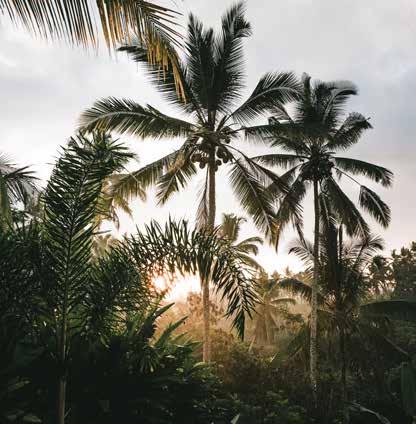
There’s a new eco champion on the block: Six Senses Svart. Set to be the world’s first ‘net energy-positive' hotel, the cutting-edge resort is off-grid, carbon neutral and coming to a fjord near you in 2024. The striking design, inspired by the fiskehjell (an A-shaped wooden structure for drying fish) and the rorbu (a coastal fisherman’s cabin), will be constructed on poles above the waters of the Holandsfjorden fjord in northern Norway. Guests can expect zero-waste dining, ice-climbing, night-fishing and sightings of the elusive Northern Lights.
Guyana is the ultimate destination for an offbeat adventure and it’s about to get a whole lot easier to visit. From March 2023, British Airways will offer twice-weekly flights from London Gatwick to Guyana (and also Aruba), bringing the number of Caribbean destinations served by the airline to 17. Land in the charming capital city of Georgetown before venturing into the wild interior for jungle treks, community lodge stays and the world’s tallest single-drop waterfall. Bonus: Guyana is English speaking, so you’ll feel at home in no time.

A legend has been reborn in Italy. Almost 140 years after Belgian businessman Georges Nagelmackers launched the first Orient Express routes across Europe, the company has unveiled six revamped La Dolce Vita trains inspired by the golden age of Italian design. Staying true to the name - ‘the sweet life’ - the trains will feature sumptuous interiors, fine dining and elegant afternoon teas as guests travel in style through Italy’s heartland with a stopover in the Eternal City of Rome, where the first Orient Express Hotel is set to open in 2024.
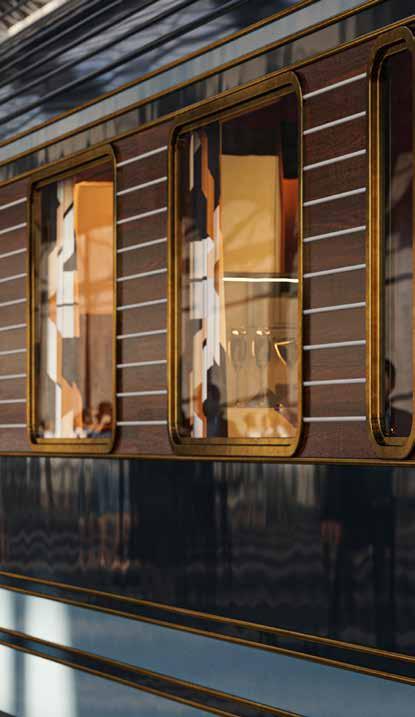
Qantas has announced it will begin operating non-stop flights from Sydney to London and New York from 2025. The route, which was first launched in 1947 with an exhausting seven stops, will take around 20 hours, making it the longest passenger flight yet. Qantas has been working on the plan - dubbed Project Sunrise - for about five years, but implementation has been delayed by the pandemic. In a statement, chief executive Alan Joyce said, ‘It's the last frontier and the final fix for the tyranny of distance.’
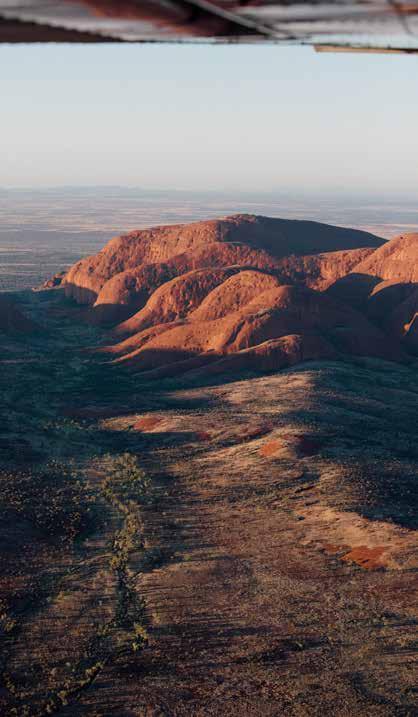

Airships were the apex of travel innovation in the 1920s and 30s and they are set to make a high-flying comeback. Paving the way for zero-emissions aviation, the cutting-edge vessels will have the capability to fly for days and land in some of the most remote and unexplored corners of the globe from the Namib desert to the North Pole. Unlike traditional planes, the airships won’t require infrastructure to take off and land and will be fitted with large and comfortable cabins, fine dining areas and panoramic windows, transforming the way we fly. Watch this air space.
Give your road trips a stylish and sustainable makeover with the new Volkswagen ID Buzz. Drawing inspiration from the classic two-tone kombi campervans of yesteryear, the fully electric vans offer a reimagined retro design alongside all the bells and whistles including a ten-inch infotainment display, reversing camera and heated seats. And with a range of more than 250 miles and 30-minute charge time, the vans aren’t just stylish, they’re practical too. Now all you need is a roof rack full of surfboards.
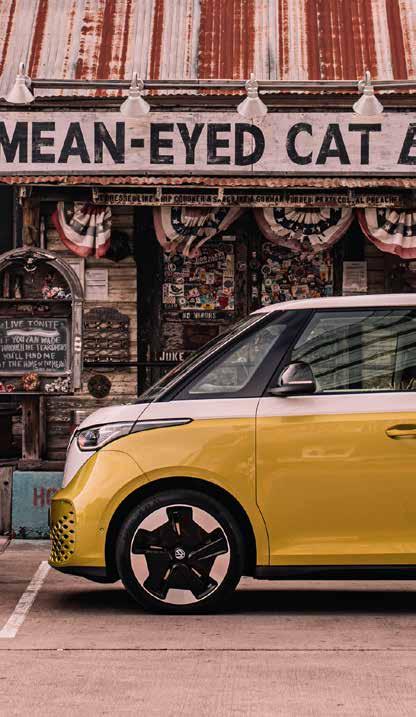
‘Connectedness’ is the buzz word for Aman’s new sister hotel brand, Janu. Launching in 2023 with a hotel in the slick new Toranomon-Azabudai district in Tokyo (part designed by Brit starchitect Thomas Heatherwick), and with others to come in Montenegro and Saudi Arabia, the luxury hotel brand is striving to kickstart human interaction following the pandemic. CEO Vlad Doronin’s vision is to create a brand which combines wellness and relaxation with excitement, buzz, and a ‘scene.’ Think Aman with a trendy twist.

The Four Seasons Explorer is on the move. Next summer, the luxurious liveaboard is relocating from the Maldives to Palau, an archipelago famous for its dramatic volcanic islands, stunning topography and world-class diving. With just ten State Rooms, this is boutique sailing at its finest. By day, see some of the 1,500 or so fish species on diving and snorkelling adventures then cruise into the evening with a crisp glass of wine in hand and views over the crystal-clear turquoise waters. Heaven.

<
The Original Travel team have their fingers firmly on the pulse of travel. Find out what’s hot, and what’s not.
<
While we love an adventure as much as the next person, there’s a lot to love about ‘Dolce Far Niente’, the Italian concept of finding pleasure in doing very little and just living in the moment.


Golden Age Travel > Luxury trains are trending, steamships are cruising and seaplanes are soaring again in a centennial celebration of the 1920s, that most elegant era of travel. Pity airports didn’t get the memo.



The island nation of Palau has become the first country to insist that visitors sign a passport pledge to act in an ecologically and culturally responsible way during their stay. Expect more nations to follow.

Thanks to a slew of new gastronomic theme parks. Exhibit A: the new Cité Internationale de la Gastronomie et du Vin in France’s Dijon. The name’s a bit of a mouthful, but the actual mouthfuls on offer are sensational.

< Wordle
It’s time to ditch the cult five-letter word challenge and switch to Worldle instead. Like the original you get six goes, but this time you’re guessing a country based on its silhouette. Also like the original, it’s completely addictive.

A new party sub, or ‘Under Water Entertainment Platform’, is launching next year with room for 120 revellers and crew on board. Rule One of partygoing? You need an escape route, and this fails spectacularly on that front.
The new Shinkansen bullet train network extension to Nagasaki makes visiting Kyushu, the southernmost of Japan’s main islands, even easier. Expect castles, volcanoes, hot springs and island national parks covered in primeval rainforest.
Jet Lag >
Leapfrog’s Snooze tablets are designed as an all-natural sleep aid but turns out they work wonders in combatting jet lag too. Take one before your flight, one during, and one on arrival and you’ll hit the ground running.

<


Long Flights
Boom Supersonic’s Overture planes, the heirs to Concorde, will be able to fly anywhere in the world in six hours, travelling at 1,300 mph and 60,000ft, and using sustainable aviation fuel. The downside? Flights won’t start until 2029.

Type I Fun >
Fun? Too obvious. It’s all about
Type II Fun now, where the actual act might not feel like fun (eg: climbing a mountain) but the aftermath is pure exhilaration and sense of achievement.
Rubondo Island is a small green speck in Tanzania’s huge Lake Victoria. Just 16 miles long and six miles wide, this trackless wilderness has been set aside as a refuge for species including elephants, giraffes, hippos, sitatunga antelopes and – most significantly – chimpanzees. With just one small camp, the human presence is minimal: a handful of park wardens, researchers and camp staff, plus a trickle of travellers who come to see these simian stars in their adopted island home. Brought over in the 1960s by Professor Bernhard Grzimek as part of a passion project to relocate endangered West African chimpanzees, there are now over 60 habituated chimps. Accompanied by a tracker and ranger, you can trek deep into the equatorial rainforest that covers most of the island, following GPS coordinates provided by a guide who has gone ahead to locate the troop. Then sit back and observe these incredible creatures as they go about their daily routine – eating, interacting and occasionally charging through the treetops to show off their strength and agility. This is a rare opportunity to encounter our closest living relatives up close, and experience nature as it should be – wild, untamed and entirely unpredictable.
This section is inspired by the podcast Better Known, where each week host Ivan Wise asks a guest to name six things that currently fly beneath the radar but that should be firmly on it. We think Better Known should be, well, better known, so tune in at betterknown.co.uk.

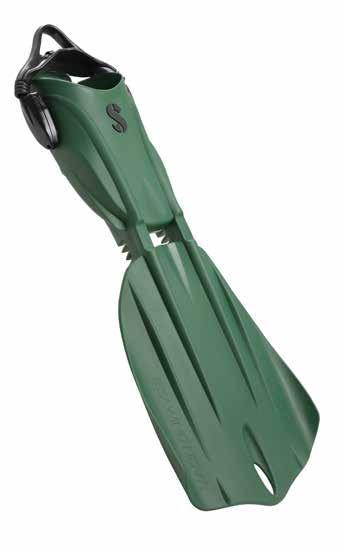

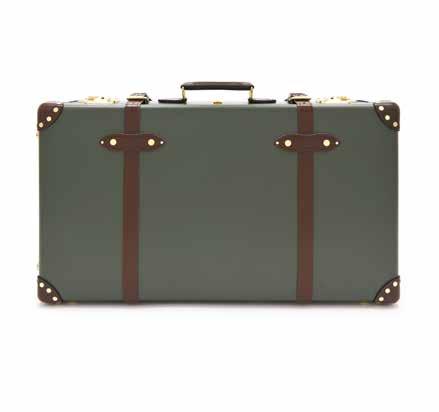



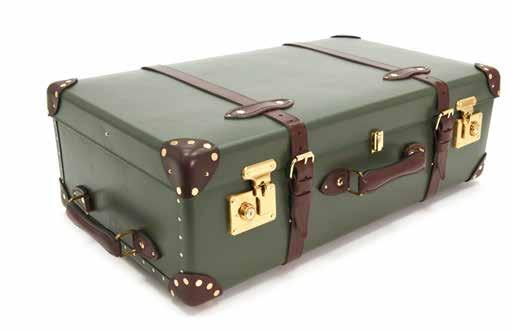


Globetrotting requires great gear. These are the (mainly Brit) brands that will make your fellow travellers green with envy.
The Brits behind Frescobal Carioca sell the Brazilian beachlife dream with their signature Trancoso Beach Bats, made by local marceneiros (artisans) and with a tree planted for ever set sold, frescobalcarioca.com, £180. (1)
Cossie + Co’s Ashley swimsuit is, they say, best suited to someone who ‘has read everything by Hemingway’ and ‘enjoys frozen strawberry daiquiris’. Fit the profile? cossieandco.com, £140. (2)
Seawing Nova Gorilla fins from Scubapro have more blade snap for more efficient paddling, with the added bonus that you feel like you’re on a covert special forces mission, scubapro.eu, £187. (3)
Ski like a downhill deity in these Sniper goggles from SunGod. You can customise the frame, strap and lenses, which, incidentally, optimise optics even in whiteout conditions, sungod.co, £95. (4)
The clue’s in the name of the Centenary Suitcase from Globe-Trotter, who’ve been making luggage to last a lifetime in England for more than a century. Since 1897 to be precise, globe-trotter.com, £1,895. (5)
You know that lovely moment when you connect your Apple AirPods and the noise cancelling kicks in? You can now experience the sound of silence using Happy Ears’ Ocean Plastic earplugs, made from plastic recovered from the sea, happyearsearplugs.com/uk, £26. (6)
Tropicfeel’s quick dry Jungle trainers are extremely lightweight and can be worn without socks, so ideal for swimming, scrambling and then packing away almost flat, tropicfeel.com, £89. (7)

Vaude have long been at the vanguard of great hiking and biking backpacks for adults, but they do a natty line in children’s daypacks too, such as the Puck 10, complete with magnifying glass, vaude.com/en-GB, £45. (8)

Recently voted best aftersun by the Beauty Bible, Saltee’s Tan Enhance Formula helps maintain that healthy holiday glow long after you’re back home, saltee.co.uk, £26. (9)

The Mark 1 sunglasses from SixtySix are Wayfarer-style shades made from sustainably-sourced walnut wood with a 20-tree planting pledge for every order, thesixtysix.co, £90. (10)

The Yamaha Scout Underwater Seascooter is the perfect gift for the child who has everything. Cue hours of aquatic antics, seascooteruk.com, £180. (11)

‘
Everybody loves a life hack - those clever little workarounds that make the day-to-day definitively better. The same applies to travel, so stop by here each issue for one of the team’s crafty travel hacks.
While we will always recommend the finest Spanish bars for tasty tapas (or pintxos, the Basque equivalent), there is another way to deduce the locals’ favourite haunts.

On a tapas crawl in Seville or San Sebastian, look out for the bars whose floors are most strewn with small paper napkins (and cocktail sticks, and olive pits). These bars are standing room only affairs and your tapas (to order, just point at what you like the look of) will be served on one of these small paper squares. When the locals are finished they chuck them on the floor and move on, so you can tell which establishments have been busiest. Oh, and don’t forget about ‘Spanish time’.
Tapas bars will be busiest from 8.30pm onwards, while dinner might not even start until 11.00pm.
’
Our clued-up local Concierges are the ultimate insiders. Who better to plan the perfect day?

7.30 am
Take an early morning Vespa tour around HCMC’s leafy parks to see the locals practicing tai chi before the morning mayhem ensues. Feel free to join in.
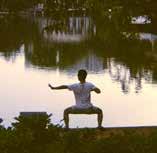
3.00 pm
It’s time for some pampering, and there’s nowhere better than at Apothiquaire Spa, a calm sanctuary in a lovely French colonial-era townhouse.

5.00 pm
From massage therapy to retail therapy at Saigon Kitsch, the perfect place to pick up souvenirs and presents from t-shirts to Vietnam War era propaganda posters.

The national dish, pho, a delicious broth of spices, herbs, chilli, soy shoots, lime and beef slices, is actually eaten for breakfast. There’s none better than at shabby but charming Pho Quynh

Ambre fell for Vietnam over bun cha (meatballs) in Hanoi, where she now lives fulltime when not exploring the country for us.

7.00 pm
Take a boat along the Saigon River to the Deck, owned by a Brit expat, for a sundowner Deck Martini, with Havana 3Y rum, Aperol, passion fruit, lime and pineapple.
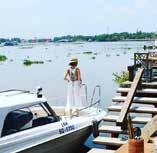
10.00 am
Wander around District 5 (Cho Lon) exploring this intimate Chinese neighbourhood of local markets and hidden alleys –a real contrast with wider HCMC.
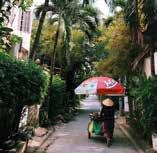
1.00 pm
Quan Bui specialises in contemporary Vietnamese cooking. Order the delicious sauteed chicken with local honey, washed down with a cold Te Te craft beer.
9.00 pm



Cuc Gach Quan is set in twin colonial villas with vintage furniture, an open kitchen and some of the best food in the city. Don’t miss the soft-shell crab with garlic, and the fine French wine list.

The well-travelled marine biologists and dive masters in our Original Diving team have chosen their favourite dive sites from around the world. Come on in, the water’s lovely.

Cape Kri, Raja Ampat, Indonesia (1) With an astonishing 374 species of fish recorded on just one dive, this is like diving in the largest aquarium in the world, minus the plexiglass and faux coral.
Bradford, Kimbe Bay, Papua New Guinea (2)
A coral lover’s paradise, this seascape boasts some of the healthiest reefs on the planet, supporting shoals of jacks, tuna, reef sharks, cuttlefish and a colossal school of barracuda.
Nudi Falls, Sulawesi, Indonesia (3) Small is beautiful in the Lembeh Strait, as are the names of the macro (dive speak for tiny) marvels you’ll see. Spot wonderpus photogenicus, harlequin shrimps and nudibranchs galore.
The Blue Corner, Ngemelis Island, Palau (4)
The careening currents here propel divers over coral terraces frenzied with life. Pelagic (deep water) predators cruise by and, on new and full moons, red snapper and bumphead parrotfish put on spawning spectacles.
Tiputa Pass, Rangiroa, French Polynesia (5) An incoming tide funnels a vast marine migration of dolphins, mantas, reef fish and up to 1,500 grey and hammerhead sharks through this narrow gap in the reef.
Fujikawa Maru, Chuuk Lagoon, Micronesia (6) Encrusted with coral, this WWII Japanese transporter ship is the wreck diver’s Everest. Disassembled ‘Zero’ fighters, torpedo shells and gas masks fill the expansive hold.
Darwin’s Arch, Galapagos (7)
This ultra-remote site, accessible only by liveaboard, is an unspoiled macrocosm harbouring sea lions, hammerheads, mantas, whale sharks, dolphins and even the occasional orca.
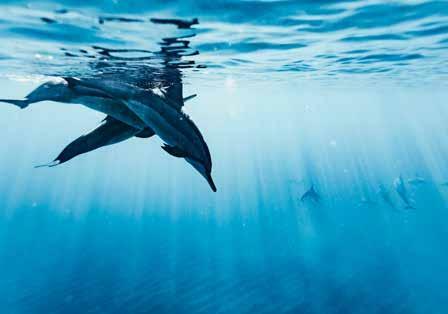
Great White Wall, Fiji (8) Carpeted in coral so white it glows, this is an easy drift dive along the Rainbow Reef, known for its vibrant gorgonians (a type of soft coral), swim throughs and copious fish.
Monad Shoal, Malapascua, Philippines (9)
This underwater seamount delivers once-in-a-lifetime encounters with pelagic thresher sharks ascending from the depths. Stick around to glimpse mobula rays, hammerheads and mantas.
The Wall, Astove, Seychelles (10)
The Wall’s dramatic vertical drop descends from waist deep water to over 1,000 meters in depth, where inquisitive pelagics and macro wonders collide on a reef coated in corals and bulbous sponges.

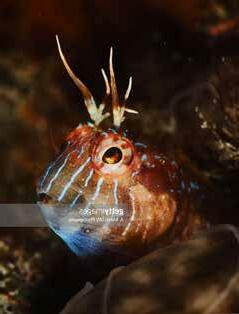



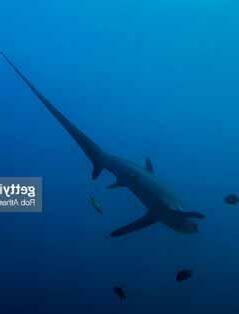
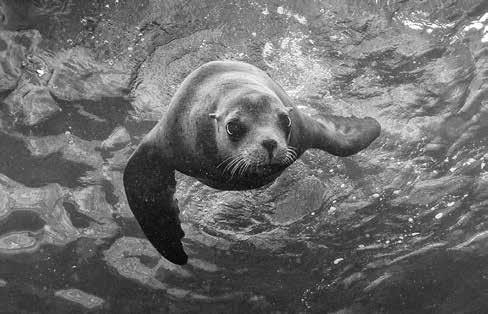

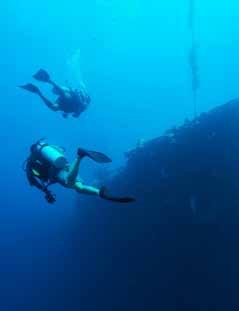



To be responsible for one game-changing travel concept is impressive; to be the creative force behind two is downright remarkable, and yet that’s what the husband-and-wife team of Sonu and Eva Shivdasani can rightly lay claim to. The visionaries behind the Soneva (Sonu and Eva, get it?) brand, with its extraordinary properties in the Maldives and Thailand, kickstarted the concept of barefoot luxury. The ‘No News, No Shoes’ policy at their heavenly first outpost, Soneva Fushi in the Maldives, saw new arrivals at the island idyll asked to hand over phones and footwear. As you can imagine, there was – and still sometimes is – pushback from high-flying types surgically attached to their devices, but everybody eventually succumbs to laidback island life and enjoys a much-needed digital detox, while a week without shoes is a surprisingly soothing experience. The other innovation feather Sonu and Eva sport in their caps is a genuine commitment to sustainability. Where other hotels can occasionally be guilty of ‘greenwashing’, from the very beginning the Soneva properties (and those of the burgeoning Six Senses hotel group, once part of the Shivdasani empire) walked the eco-walk better than anyone. No plastic water bottles, a large percentage of restaurant produce from their own gardens, a foundation supporting local communities, coral reef protection programmes - all things that Soneva committed to way before it became fashionable. We say hats (and shoes) off to Sonu and Eva.


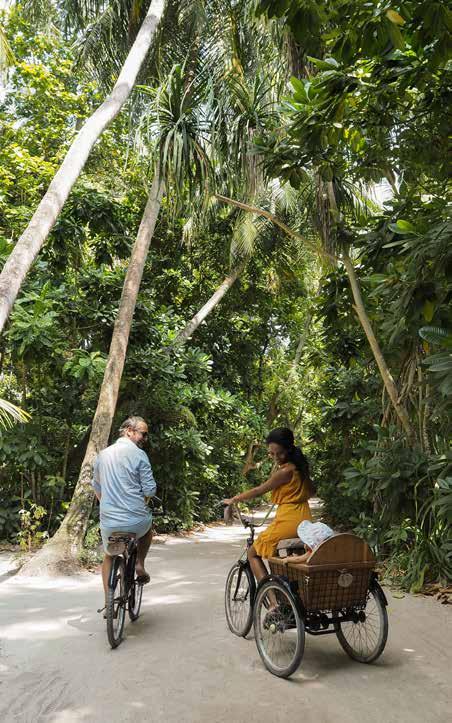
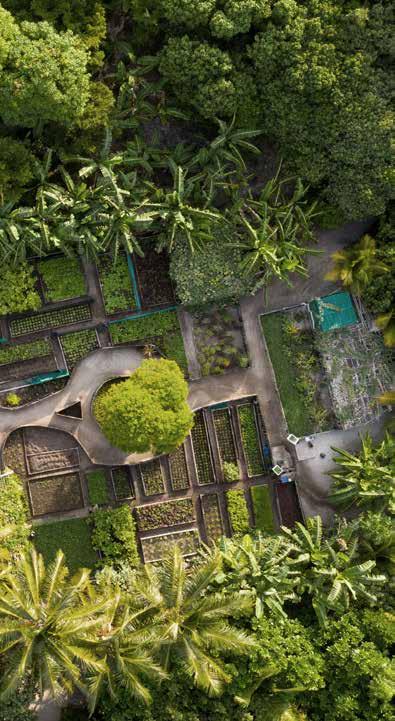
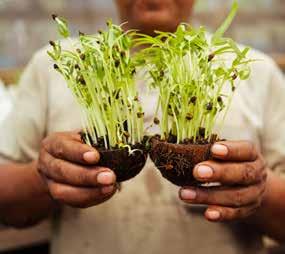
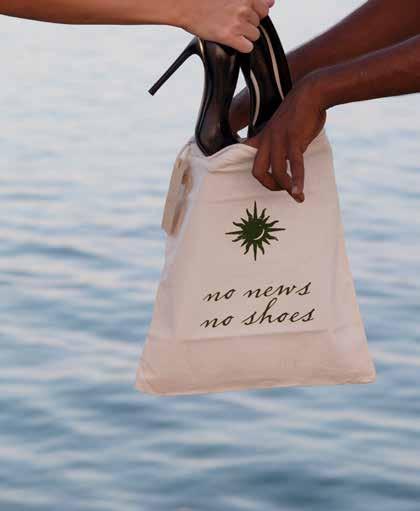
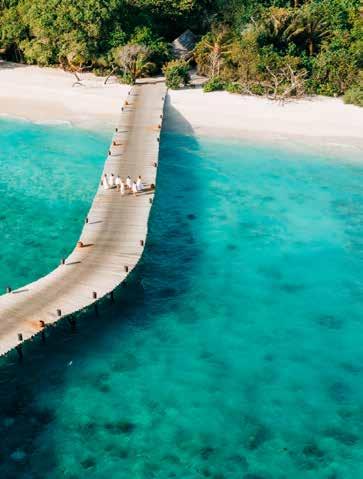
The Pantheon is one of Rome’s most iconic buildings. Built between 25 and 27 BC, it is one of the few buildings from the ancient capital that has remained entirely intact, surviving earthquake, flood, fire and the attentions of marauding barbarians. The Pantheon boasts the world’s largest unreinforced concrete dome (yes, the Romans really did concrete), at the centre of which is a cut-out ‘oculus’ that beams light, and occasional rain, into the cavernous interior. This was also the first temple constructed as somewhere for the ‘common people’, paving the way for all subsequent places of worship. With its vertigo-inducing dome and gleaming marble floor, it is a truly staggering space; one that prompted Michelangelo to wonder whether the Pantheon was, in fact, not the work of men, but angels.
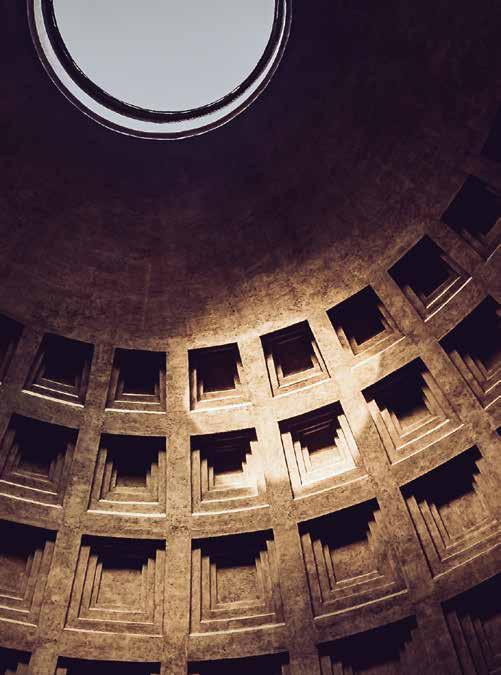
Contact one of our Italy specialists: + 44 (0) 20 7801 1750

Mexican-style grilled corn on the cob with chipotle butter, feta and fresh lime
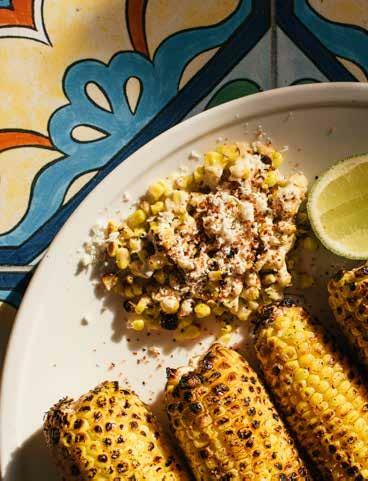
Traditional cuisine can be a window into a nation’s soul, and nowhere more so than in Mexico, one of a handful of countries granted UNESCO Intangible Cultural Heritage of Humanity status for its cuisine. No-one has done more to raise the profile of Mexican cuisine in the UK than Tommi Miers, Masterchef winner, founder of the Wahaca chain of Mexican eateries and author of multiple cookbooks. ‘I first visited Mexico aged 18,’ she says, ‘and immediately fell for the country and its food. Oaxaca is Mexico’s flagship foodie destination, and the place I return to time after time for recipe inspiration. I have particularly fond memories of the grilled corn sold by hawkers around the zocalo (main square).

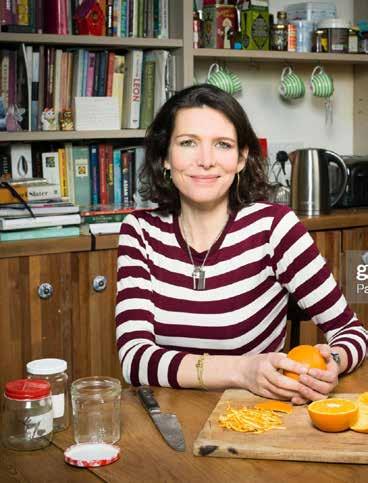
‘When the corn hits the markets in the UK, we are right in barbeque season and there is no better way to cook it. In my new cookbook Meat Free Mexican, I also delve into several of my favourite Mexican chillies so I invariably also make chipotle butter to smother all over the hot, blistered corn, with wedges of lime and crumbles of feta to serve on the side. You can also shave the blackened, sweet corn kernels into a pretty bowl and serve it like a salad, or eat it street food style on the cob. Both will be wildly popular and easy to produce for a party, something Mexicans enjoy more than most.’
4 corn on the cobs 4 tbsp extra virgin olive oil (if using griddle pan) 1 lime
2 tbsp chipotle chilli flakes 100g butter 50g feta cheese
Peel back the sleeves of the corn and remove the strands clinging to the husks. Cover the husks with the sleeves again and soak in cold water for 15-20 minutes, or overnight.
Heat the barbecue, if using. When the barbecue is hot, put the cobs, still in their sleeves, straight onto the barbecue grills and turn them for 10-15 minutes until the husks blacken and become like tissue paper. Alternatively, brush them with oil and cook them on a griddle pan, using the peeled-back leaves as handles, or bake them, peeled and oiled, in an oven preheated to 200°C (220°C non-fan) for 15-20 minutes.
Meanwhile, mash chipotle flakes (or paste) with 100g butter and smear all over the corn once it has cooked. Then crumble over some feta and squeeze over a lime. The fieriness of the chillies with the sweetness of the corn is a perfect combination.



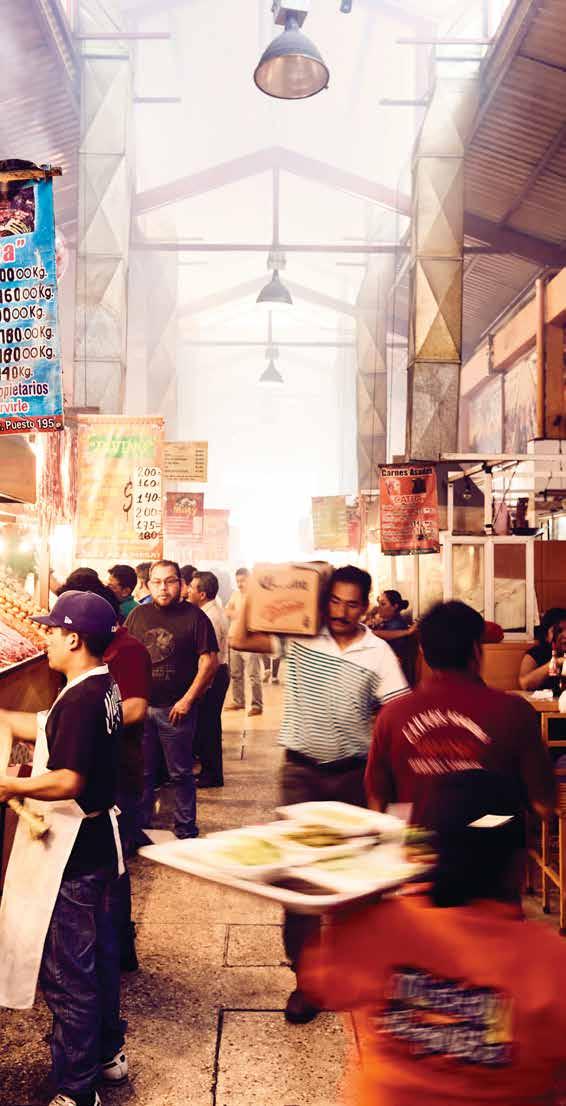

On a cruise between Luxor and Aswan aboard Steam Ship Sudan, or our elegant dahabieh (shallow-bottomed houseboat) Flaneuse du Nil, you can visit many of ancient Egypt’s finest archaeological sites, but it’s often the moments between temple visits that are the most memorable. Settle in on the top deck, mint tea (or something stronger) in hand, and watch the riverbanks slip by. Children bring oxen down to the water’s edge to drink; pied kingfishers dart across the water; fishermen cast their nets from small boats; triangular sailed felucca boats glide past; it is an unhurried glimpse of a lifestyle virtually unchanged in centuries.
Contact one of our Egypt specialists: + 44 (0) 20 7801 1750
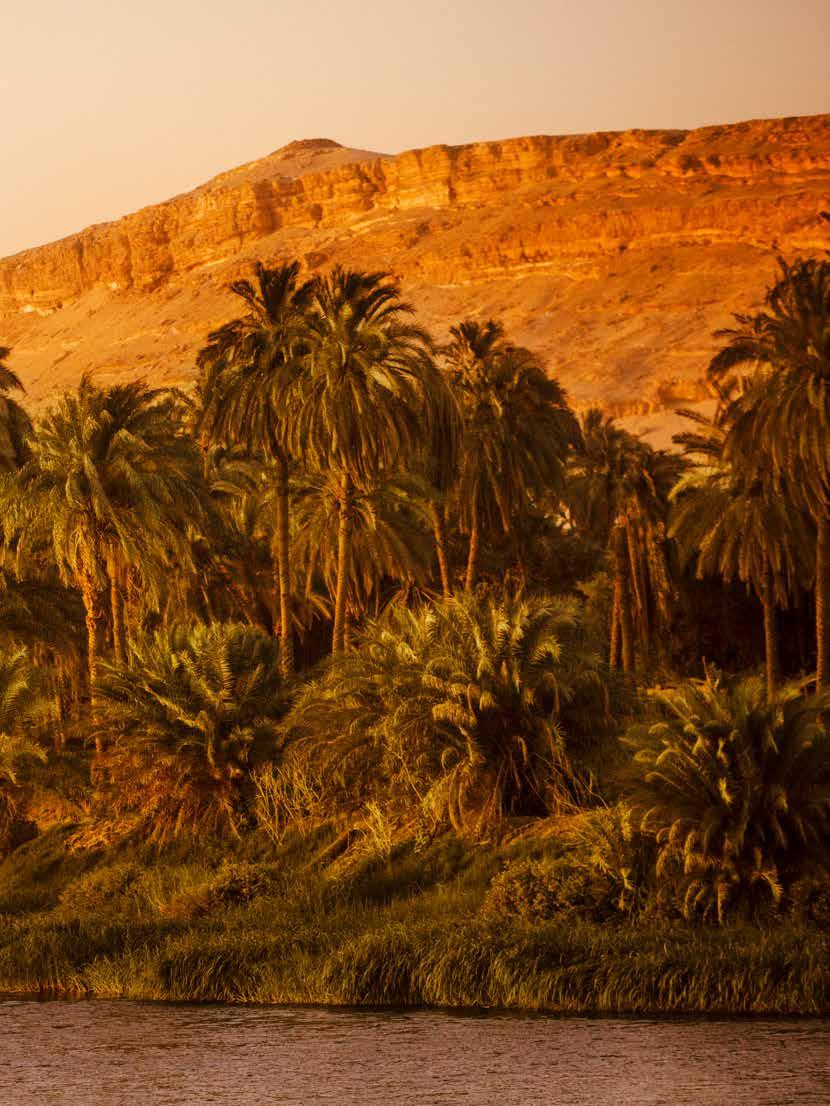

Award-winning filmmakers and conservationists Beverly and Dereck Joubert have watched life and death play out on the open plains of Africa since the 1980s, highlighting predators and their plight. In 2006, they also launched an iconic collection of safari properties across Botswana, Kenya and Zimbabwe that are among our favourites in all Africa.
INTERVIEW BY STEPHANIE DRAXHow did you meet and become filmmaking partners & conservation activists?

Beverly: We met aged 16 and realised we were soul mates, both wanting to live a life exploring and living in the wilderness.
Dereck: We’re conservationists at heart. As soon as we finished university, we went off into the bush and fell in love with each other and the continent we live in. To understand Africa, you need to understand the wild. To understand the wild, you need to understand the top predators. We quickly fell into bad company and started studying lions, leopards and cheetahs.
B: We weren’t expert photographers, but we had passion. We filmed for two solid years in Botswana, through a major drought. We lived what the animals were living, all of us desperate for water. It was extreme, but we were capturing interactions between animals that would never normally interact - footage so unique it got our focus. We called this first documentary Stolen River and National Geographic bought it. We’ve now made 35 films for them.
Which of your films has been the most challenging or rewarding to shoot?
B: We were nocturnal for our next film, Eternal Enemies, which was seven years in the making. We saw nightly battles for territories between lions and hyenas, capturing moments never seen before. Two predators were at war with each other, and we showed it was, in fact, an
evenly-matched fight. It was both adrenaline-fuelled and exhausting; by the end we’d picked up parasites and couldn’t even remember our birthdays!
D: We did become obsessive, but we decided early on that if we were going to do this together, we would make sacrifices like, for example, not having a family. In 1990, Eternal Enemies changed our lives, and people say it changed natural history filmmaking forever. Up until that point everybody believed that lions would make a kill and hyenas would eat the scraps, and that lions and hyenas only competed against their own species, but we discovered a different story; this amazing cross-species interaction. Other filmmakers work more quickly (the modern equivalent would be a six-week shoot) but you sometimes need the luxury of time to understand the animals’ language.
B: If we, in our main mission, want to be effective in protecting top predators and wild places, we have to move people intellectually and emotionally with our films. It has to be genuine. We have to live in the dirt with them for the film to stand out as being authentic.
Eternal Enemies won an Emmy, one of nine that you’ve amassed. How do you feel about your raft of accolades?
D: We won the Explorer’s Club medal recently, one of the most relevant that we’ve received, but for some time I was anti awards. For most of our lives, we lived in a one-bedroom tent in the middle of the Okavango Delta with a kitchen tent nearby, and that’s it. When we got to six Emmys, I bundled them up in a corner and tried to
weld them together to make a new statue, not realising they’re made of tin. All the wings fell off these poor flying women, and I ruined them all! Our biggest awards have been when there’s success in conservation. The former President of Botswana banned lion and leopard hunting after seeing our films. When you’re trying to guide a country to better environmental methods and you see success, that is a truly great award.
You’ve had a few self-confessed ‘NDEs’ (Near Death Experiences). What happened?
D: Five years ago, we were walking at night together in Kenya when a wounded and disorientated buffalo came at us. It hit me with his shoulder, and I flew backwards, and as I was down, he impaled Beverly and ran off with her.
B: The horn went in underneath my armpit, through my chest, smashed my collarbone, went through my neck –lacerating my throat – and then came out of my cheek (where I now have 41 screws and five plates). I broke 27 bones, but I was fortunate it missed my spine.
D: I did a flying karate kick to his side with both feet, and that opened up a wound he had, so he flicked Beverly off. She died twice at the camp, but thankfully I managed to revive her, then she flatlined in the plane to Johannesburg and again in the hospital.
B: The first thing we did after the accident was ask Africa to invite us back. What we went through was phenomenal, and so we embrace life even more. We’ve been more determined to be effective and we understand mortality better because it’s now very personal.
D: In many ways it was a metaphor for where the planet is: it’s bashed up, and we’ve got to treat it like a patient in intensive care.
How has Africa changed through your lens over the years?
B: When we started working, Africa’s wildlife didn’t have the same pressure on it. The nefarious acts of laying snares and the bush meat trade have escalated at an alarming rate, especially since lockdown.
D: Project Ranger was our emergency intervention when the pandemic started because rangers – and their eyes and boots on the ground – were no longer in the field. Through our charity Great Plains Foundation, we raised $1.6 million to distribute among 250 rangers in nine countries to make sure they were financially topped up and their families were fed. When the furloughed rangers came back, they were immediately able to stop elephant poaching. They are our front-line conservationists.
B: More people are using Africa for economic gain, like oil drilling at the source of the Okavango River, deforesting areas, killing animals to pay for terrorism and the market for pangolin scales or rhino horn. These last remaining wildernesses and their migrations are under intense threat.
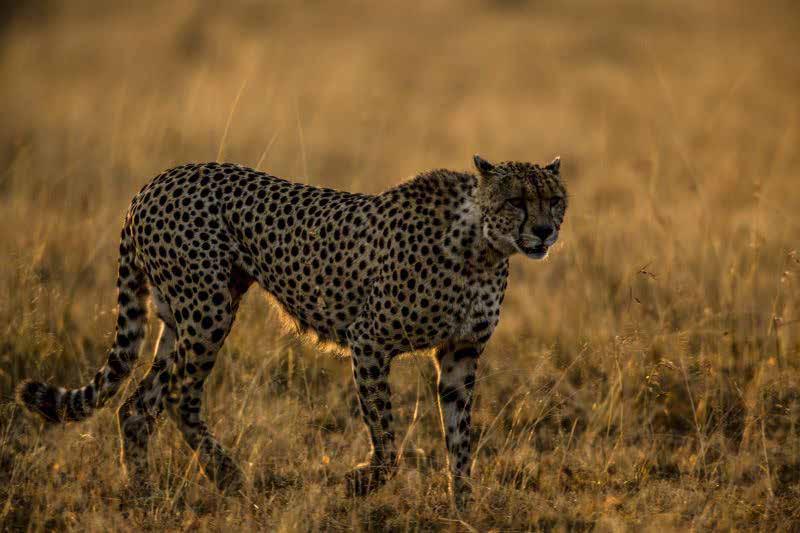
D: There is tremendous hope, as we know what the three main issues are. Ignorance – because if people don’t know it’s wrong, they’ll continue to do it. Necessity – we
all have to lift people up around us, to distribute wealth and make sure there are fewer poor people. Greed – if you don’t need to, and yet you still go out and kill a rhino or Cecil the lion, social media and world watchdogs will name and shame you. We know the issues, so the solutions are not that difficult.
How did you make the leap from filmmaking to hospitality?
D: We have used film to talk about conservation and then 15 years ago we started the ‘Big Cats Initiative’ to save big cats. We’ve saved 4,500 lions so far, with projects across 29 countries. We realised we needed to save the landscape the cats live in, so we bought up leases and to pay for them we asked friends to stay. As explorers, we’ve had the opportunity to visit extraordinary places, and that’s where we’ve put our 13 safari camps. The philosophy is to make the money to manage our 1.5 million acres, entice good people to stay, and encourage people to copy us. We believe in the ‘copy left’ philosophy as opposed to copyright. There are 44 million acres of land in Africa for potential conservation tourism and we can’t get to it all, so we’re happy to share our business model and show people how to make money from it. We personally plough everything back into three areas –conservation, communities and growing that footprint.
B: We’ve never taken a dividend. Great Plains was created to protect pristine areas, stop hunting and work side by side with communities, offering education, a profession or a stakeholder position. The whole premise of our conservation tourism is about making life better for communities and assisting them in protecting wild lands.
What do you think about community-focused tourism?
D: I don’t think you improve communities by turning them into Disneyland characters and popping in and having them dance for you. If you want to improve the lives of communities, you bring them in on a shareholding or stakeholding basis. The reason we buy land and don’t lease it is because when you buy land you end the conversation, when you lease it, your destinies are tied.
D: We’ve just embarked on a project that will move the needle in Zimbabwe. A big conservancy wanted to get rid of an overpopulation of animals - overpopulated due to drought – so our Rewild Zambezi project is relocating 3,000 animals into our private Sapi Reserve, part of a 1.6-million-acre biosphere.
B: It’s like a Noah’s Ark venture that includes 400 elephants, as well as lions, buffalo, impala, and more. Animals are keeping wildernesses alive for us, and the more we can do – through Great Plains or our films – to help change government policies and protect wildlife, the better. If this works, we’ll have the science on how to do it, and the story will have a ripple effect across the world.
Contact one of our Safari specialists: + 44 (0) 20 7801 1750
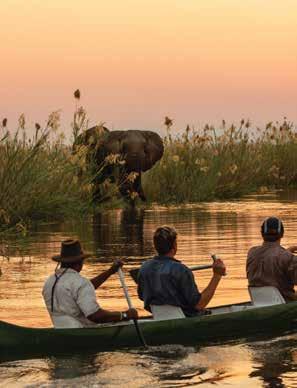
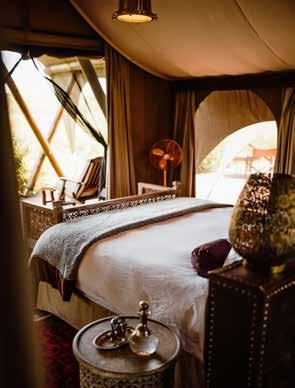
Your local hero, your fixer, your eyes and ears, your far-flung friend, your informed insider, your right-hand man, your wing woman; your Concierge is on hand 24/7 to help, advise, reserve, modify and generally anticipate your every need while you’re in their beloved destination. They also love a challenge, so go ahead: put them to the test. Want the address of the best bar in town, far off the tourist trail? Or a suggestion for a truly original souvenir to remember the trip by? Ask away. Nothing’s too much trouble, or too trivial for them to handle. They can, and will, take an already stellar trip to even greater heights. Before you even set off on your adventure, your dedicated Concierge will have been sent all of your trip details and your likes and dislikes. When you arrive, they’ll be in touch to remind you that they’re on hand to help (via phone, WhatsApp etc) with everything from last-minute changes, to tips and tricks on where to go and what to see and do. Thanks to their in-depth knowledge and passion for their destination, and taking your individual profile into account, your Concierge will be able to help with any requests. They can find you the best babysitter in the area, choose a guide best suited to your specific interests and, if needed, change a flight, find a room and iron out any kind of issue while you focus on having as fun and fascinating a trip as possible. Original Travel is the only travel company in the UK to offer such a comprehensive concierge service.



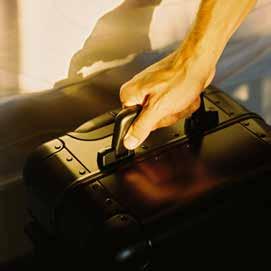
The Brayshaw family wake up in Cape Town ready to start their beach day, only to open the curtains and find that it’s raining. They call local Concierge Carol to find out what there is to do in the area with their girls (aged five and seven). Carol reserves tickets to the Cape Town Science Centre which has lots of indoor activities and interactive exhibitions for children.
As huge Bollywood fans, David and Emily are on a private guided tour of a Mumbai film set. Our Concierge Alisha surprises them with the opportunity to act as extras on a live film set. Ecstatic, the couple are dressed in traditional costume and join the cast. Alisha later sends them a memory stick with video evidence for posterity!
Returning from hiking the trails in the Doñana National Park, James and Anna realise they’ve locked the car keys in their hire car. Our Concierge Maria orders them a taxi and tells the couple to go ahead with their lunch plans nearby while she takes care of it. After a wonderful lunch, James and Anna return to the car to find a locksmith with the keys and their car unlocked.
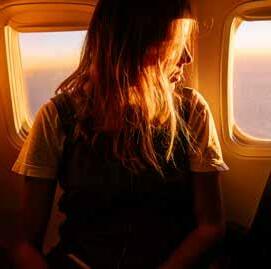
After an amazing three-week trip, two clients want to sign off in style with dinner somewhere special in Sydney. The local Concierge Denis, who has all the city’s maitre d’s on speed dial, manages to snaffle them a table at Sydney’s most happening restaurant, which normally has a three-month waiting list.

While out on their private guided tour of Ellis Island and the Statue of Liberty, the Bell family realise that they are running late for their evening tour of MoMA. They are relieved to receive a message from Concierge James to say ‘I heard you were having fun with Lady Liberty so I moved your evening plans back by an hour - no need to rush! And take lots of photos!’
Charlie and Jenny are in Java visiting Yogjakarta when the Concierge, Eloise, informs them that there is a ballet performance of the great Hindu epic - the Ramayana - that evening at the beautiful 9th century Prambanan Temple. The couple are eager to go, and Eloise sorts out a pair of VIP tickets and transfers from and back to their hotel.
We absorb 100% of the carbon footprint generated by our client and staff flights and ground transportation through our financing of large reforestation projects around the world. Our participationalongside eight European groups - in the new €100m Livelihoods Carbon Fund fights global warming by taking a highly practical approach and having a strong local social and economic impact. We believe that we were the first company in the UK travel market to be taking such a step.
What is carbon neutrality?
Each trip made by our clients and staff has a measurable impact on global warming. We can calculate precisely the amount of CO2 emissions related to our clients and team’s travels. This makes it possible to know the exact number of trees that need to be planted in order to absorb the CO2 created.
How does carbon absorption work?
Today, air transport accounts for 3% of global greenhouse gas emissions, and this is likely to rise. Even if green technology continues to advance, over the next ten years it will remain difficult to travel ‘clean’. The only concrete option is to absorb CO2 emissions, particularly through tree planting. By financing reforestation projects around the world, we contribute to the absorption of carbon dioxide. Every day, 7,400 trees are planted, which adds up to about 2.7 million trees a year.
According to the IPCC (Intergovernmental Panel on Climate Change), it will take ten years to reduce our CO2 emissions by 50% and stay below a temperature increase of 1.5° - the critical threshold of global warming. The second phase involves achieving carbon neutrality by the year 2050, a highly ambitious goal but one that is achievable if all countries and industries work together... starting today.
TONNES OF CO2 2.87 Contact one of our specialists + 44 (0) 20 7801 1750
Our Foundation, created in 2009, supports a number of humanitarian projects in developing countries in Africa, Asia and South America. The projects include long-term reforestation programmes and support for local associations focused on economic and social development.
In Indonesia In Senegal In Peru
The island of Sumatra has lost 50% of its forest in 40 years. NGO Yagasu has replanted 32 million trees, and also finances community development programmes, scientific research and the protection of mammal species.
Since 2006, the association Oceanium has worked for the protection of the environment and the restoration of the mangrove forests. In total, 104 million trees have been planted.

Our Foundation Committee meets annually to select the programmes we will support. We focus on five key areas: child protection, vocational training, economic development assistance, preservation of cultural and natural heritage and safeguarding the lifestyles of indigenous peoples.
In addition, we also look to support emergency relief efforts in the face of large natural and humanitarian disasters. We spend almost 15% of our budget each year on emergency humanitarian aid.
At Original Travel, we believe travel and tourism should be a force for good and have a positive impact on the destinations we visit. Our Foundation, created in 2009, supports a number of humanitarian projects in developing countries in Africa, Asia and South America. Since 2009, nearly £1.5 million has been invested in the support of nearly one hundred humani
tarian projects across 30 countries.
CASE STUDY N°1
In Kenya
Shining Hope For Communities (SHOFCO) was created in 2004 for the protection and education of disadvantaged children, and to help promote the economic development of local communities. In Nairobi, SHOFCO manages and helps finance two schools in Kibera and Mathare, two of the largest slums in the world, enabling 500 girls aged three to 15 to attend school and improve their lives. The association also works to transform urban slums on a large scale by supporting the provision of drinking water and a women’s entrepreneurship programme.
CASE STUDY N°2
In Bolivia

We’re working to improve the living standards of village communities in the province of Jose Manuel Pando, where 98% of the population live in poverty. We support the ‘Weave the Future’ project, which trains local farmers to turn wool into high quality local crafts and textile products that they can sell to supplement their income.
CASE STUDY N°3

In India
Due to climate change, the number of mangroves in India’s Sunderbans region is rapidly declining. Our project aims to plant more than 16 million mangrove trees to protect the local communities’ homes and farmland from flooding and to restore local biodiversity. So far, over 11,100 acres have been replanted, positively impacting 250,000 locals and counteracting 700,000 tonnes of CO2.

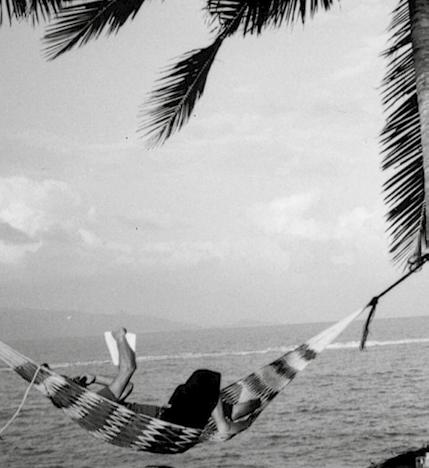






As we celebrate our 20th birthday, we look back at two decades of Original Travel.
The three Co-founders leave the City, the Army and Fleet Street respectively and Original Travel (and the Big Short Break) is born. We scoop our first award, for Best Brochure, at the prestigious Guardian & Observer Travel Awards.
We turn publishers, launching our Big Short Break coffee table book, and win the big one: Best Tour Operator at the Guardian & Observer Travel Awards in only our 5th year.

We launch Original Diving with Tim Simond, author of the best-selling Dive in Style books. We bag the Guardian & Observer Travel Awards Best Short Break Tour Operator award for a fourth straight year.
We acquire well-respected Africa, Latin America and India specialists Tim Best Travel as we start to sell more and more long-haul holidays.

Our second brochure also picks up the Best Brochure gong at the Guardian & Observer Travel Awards.
We go from strength to strength, organising hundreds of tailor-made trips – including one particularly high-profile honeymoon – to far-flung corners of the globe.
With the acquisition of Simoon Travel we further bolster our Middle Eastern expertise. There’s also a clean sweep of both Best Tour Operator and Best Short Break Tour Operator at the Guardian & Observer Awards. Our trophy cabinet is now officially groaning.





We arrange what must be the best sabbatical ever planned: a two-year epic adventure weaving together a host of the world’s most memorable experiences and building a website where the client’s friends could track his progress and arrange to join him for different legs.

We introduce a range of Original Services, including a global network of Concierges, fast-track through airport check-in & security, and access to airport lounges. All as standard on every trip. We also become the first luxury tour operator to launch a train-only portfolio, with routes across Europe.
2014

We join forces with much-loved children’s party people Sharky & George to enhance our family holiday offering with fun-filled and destination-specific children’s packs.
Two of Europe’s best tailor-made travel companies join forces as French tour operator Voyageurs du Monde takes a strategic stake In Original Travel.

Travel makes a long-awaited comeback, and travel writers, editors and readers vote us one of The Times and Sunday Times Travel Awards top ten Luxury Tour Operators, and Conde Nast Traveller’s Readers’ Choice winners as well.

In the toughest imaginable year for the travel industry, we launch our ‘Travel Less, Travel Better’ ethos, because travel should be a force for good. We also coin the concept of ‘philantourism’ –actively choosing down-on-theirluck destinations – which goes on to feature in the Financial Times' annual travel lexicon.


A raft of recognitions and awards as we are voted one of the ‘Top Tour Operators’ by 600,000 readers in Condé Nast Traveller’s Reader’s Choice Awards, and top diving experts by Travel + Leisure.
We contribute no fewer than five experts to the illustrious Conde Nast Traveler Top Travel Specialists list; more than any other UK travel company.
Break out the champagne! Original Travel celebrates reaching the grand old age of 20. A huge thank you to all our clients. We would not be here today without you.



the
Take a deeper dive into some of our favourite destinations.
44 – 55

GLIMPSES OF GABO IN COLOMBIA
Lizzie Shipley enjoys the magical reality of Colombia 56 – 65
MY WAY ON THE HIGHWAY Stanley Stewart uncovers gems in Jordan 66 – 77

HOW TO SAFARI BETTER Richard Mellor’s top tracking tips 78 – 91
SECRET TOKYO
Tamara Hinson lifts the lid on the Japanese capital 92 – 105 BRAZIL A photostory by Alix Pardo 106 – 117
Rose van Cutsem and family swap the UK for Swedish Lapland 118 – 129
WALK THIS WAY
Tom Barber talks the talk and walks the walks 130 – 145
NATIONAL PARKS & RECREATIONAL VEHICLES
Fran Kellett’s family road trip in the US of A 146 – 155 LISBON
Ella Mawson does Lisbon like a local 156 – 163
THE AZORES
Lucy Dunn dives into the Azores, family in tow 164 ENDINGS Until next time



The window seat on a plane can be a great indicator of what's to come. As we prepared to land, an impenetrable layer of dark cloud hovered above the city. I’d brought the British weather to Colombia. I tried not to dwell on the premonition by the novelist Gabriel García Márquez, Colombia’s favourite son, that ‘it rained for four years, eleven months, and two days,’ and by morning my fears were extinguished. The clouds had disappeared, the sun was out and the heat lingered in a thick haze. Window seat, nil; Cartagena, one.
One of South America’s oldest colonial cities, Caribbean Cartagena is a muddle of juxtapositions. From the fortressed Old City, today a UNESCO World Heritage Site, to the hipster Getsemani neighbourhood, Cartagena effortlessly blends tradition with modernity; while the influence of Spanish, Colombian and
Afro-Caribbean cultures creates a wholly unique reality, best summarised by García Márquez — or ‘Gabo,’ as he's known to all Colombians — himself, ‘the problem is that Caribbean reality resembles the wildest imagination.’ As the story goes, Gabo arrived in Cartagena as a penniless reporter from Bogota in the 1940s where, inspired by the seedy, vibrant undercurrents of the Caribbean coast, he cast his fantastical stories, anchored in Colombia’s reality. Gabo died nearly a decade ago, but take to the streets and you can easily picture yourself in one of his books, from the narrow lanes with flower-covered balconies that inspired Love in the Time of Cholera, to the trio of women, embellished in dresses of bright yellow, red and blue patiently fanning themselves against a crumbling mustard facade.
While Cartagena is often cited as the birthplace of Gabo’s tales, the entire country is
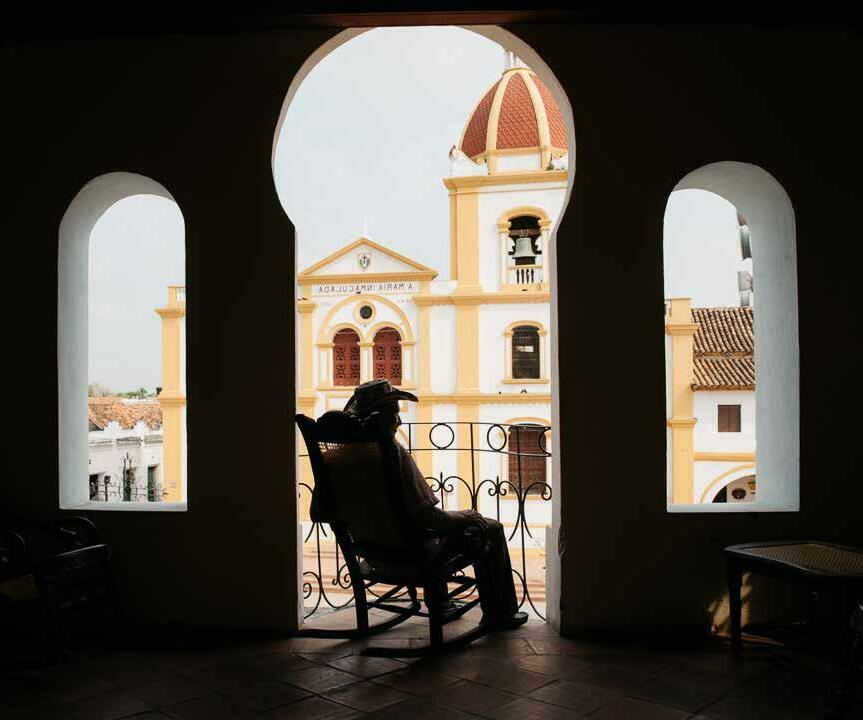
dusted in magic. Few places can compete with the geographical splendours of Colombia, ranging from towering Andean massifs to vast gaucho grasslands; Amazonian jungle to the wild Pacific Coast, stretching north to Martian deserts, tropical beaches and the cerulean Caribbean Sea. Travelling in Colombia feels like navigating all of Latin America. I was there for three months, and feel like I only scratched the surface.
From Cartagena, I flew down to Medellín. Located in a bowl in the Andes Mountains, Medellín is the type of city you could see yourself living in. I arrived in August, and the city was under siege by a vast cascade of flowers. Medellín’s annual Feria de Las Flores — or ‘Flower Festival’ — is one of Colombia’s largest regional festivals and sees the city awash with the vibrant colours of flowers, music and dancing. Parades of local flower growers march through the city with
flower displays thrice their size strapped to their backs and the atmosphere is contagious. However, I quickly learned this isn’t exclusive to the festival. A city once plagued by cartels and cocaine, Medellín has undertaken a remarkable transformation into one of the most innovative, liveable cities in the world. We hop on the metro (which puts London’s tube to shame) to explore the scope of the city, stopping by the Botero Plaza to see the bulbous bronze sculptures by Colombian artist Fernando Botero, before heading to the botanical gardens, where we stumble across a concert among wildly exotic plants and free-roaming iguanas. This all seems very Colombian. On another day, we take an urban cable car — built to connect isolated neighbourhoods and now a symbol of Medellín’s transformation — up to the Camino De La Vida, or ‘Path of Life.’ Part of the city’s greenbelt project, this 46-mile green pedestrian path winds up to the top of Sugar Loaf
Hill, providing sweeping views over the city. Communa 13 is another popular viewpoint. Once the most dangerous neighbourhood in the most dangerous city during the cartel years (which is saying something), Communa 13 is now a colourful patchwork of buildings carved into the steep Andean hills. On the way back down, we stopped for bandeja paisa, a traditional dish of meat, beans, avocado, plantain and rice.
Day rolls into evening and, depending on where you are, salsa or reguetón rhythms will start pulsating through the streets. Hailed as the ‘City of Eternal Spring’, the weather stays balmy and we stop for an al fresco beer, soon finding ourselves sharing shots of aguardiente — a liquor made from anise and sugar cane — with paisas on the next door table. Paisas — people from the northwest of Colombia — are famously friendly, and clearly forgiving given my butchering of Spanish. If
you don't already speak Spanish, learn a few phrases before you go and you will find yourself speaking, or at least laughing, like a local in no time.
A couple of hours outside the city brings us to Guatapé in Antioquia, which is easily Colombia’s most colourful pueblo (town). The town is located on the shores of Laguna Guatapé, a sprawling artificial lake harbouring the sunken village of Old Peñol. The lake was originally flooded for the development of a hydroelectric dam in the 1970s, and you can still see the church spire poking out of the water. For the best lake views, climb the 740 steps up El Peńol, a gigantic granite monolith overlooking the town, before exploring the colourful zocalos, or painted panels, that pattern every nook and cranny across the town. Guatapé is packed with local restaurants and street vendors to refuel on Colombian specialties. From hot-off-the-pan arepas

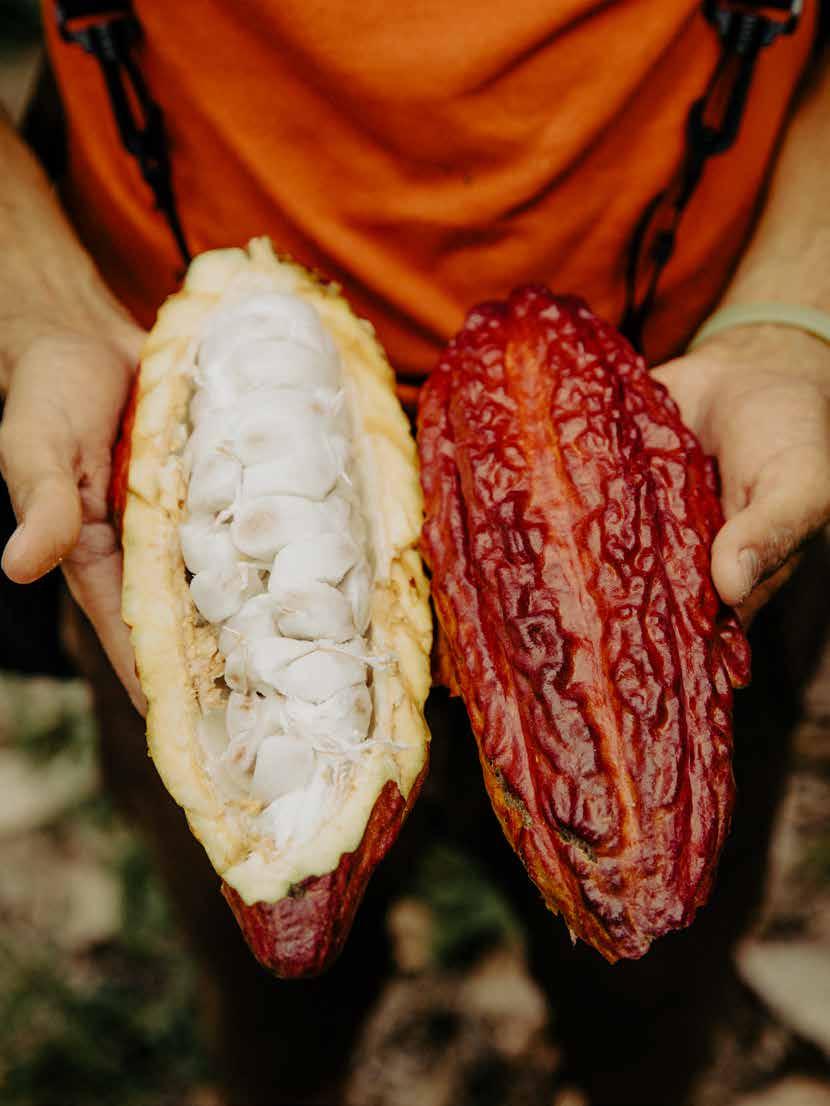
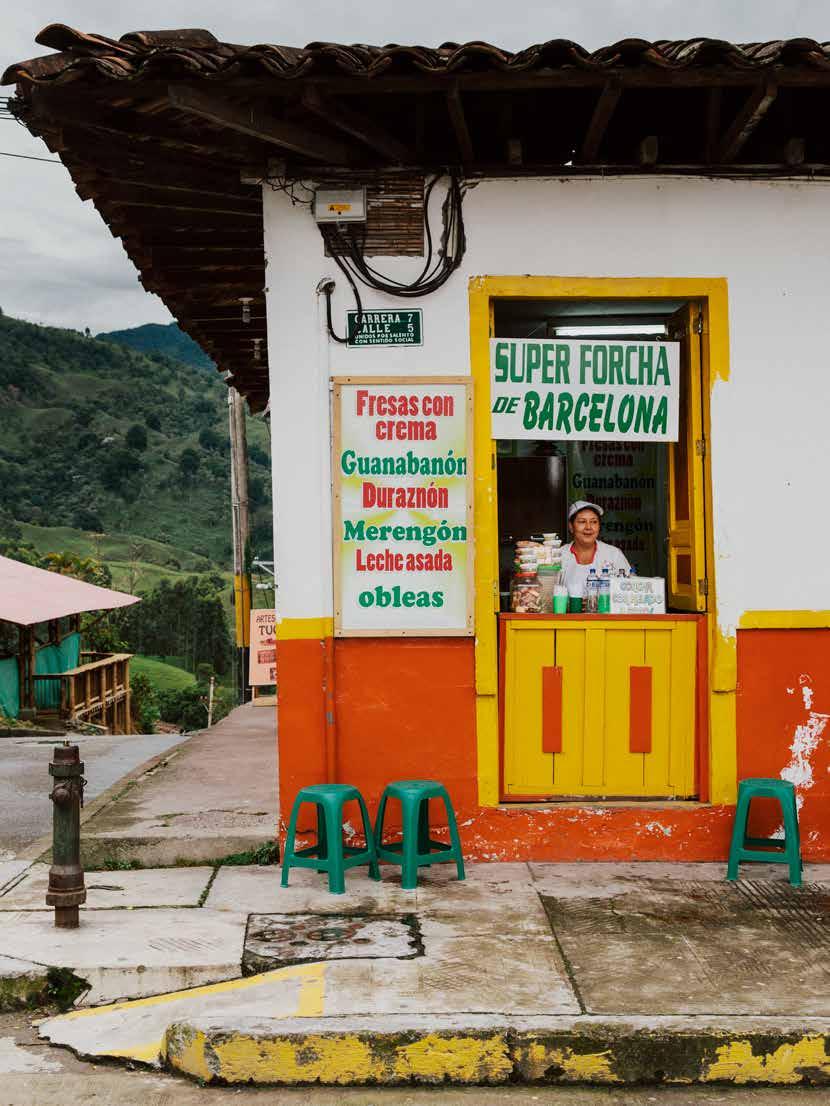
‘
— fried cornmeal pockets that have been around since pre-Columbian times — oozing out bubbling innards of melted queso fresco, to hot chocolate with a lump of cheese floating like a forlorn iceberg, be warned: in Colombia, cheese is more of a condiment than a food group.
Heading south, we found ourselves in another world entirely in Cocora Valley. Located in the lower Andes coffee region and skirting one of Colombia’s most spectacular national parks, Parque Nacional Natural Los Nevados, Cocora Valley feels like The Lost World , somewhere that prehistoric animals might still roam. To reach the valley, you need to take a 4x4 from the nearby mountain town of Salento. These are vintage WWII Jeeps that have been converted to cram as many people in and on as possible, to the point of people hanging outside of the car, which, incidentally, I thoroughly recommend. Get a lift before 7am to avoid the crowds. The six-hour hike (also possible on horseback) takes you through emerald jungle, across rickety suspension bridges, farmland and misty cloud forest until you reach the pièce de résistance: Wax Palm Valley. Home to the tallest palm trees in the world, these wax palms can reach up to 180ft in height, and the scene is entirely bizarre. The only features across the sweeping green valley, these slender, towering palms shoot skyward like toothpicks, with their small sprouting fronds disappearing in and out of the clouds. Back in Salento, you
can tour the region's coffee and chocolate farms, however, we chose to beeline north to sample the nation's famous brew.
After a quick stopover in Santa Marta, the springboard to the north, we headed to Minca. Perched on top of a mountain in the Sierra Nevada de Santa Marta, Minca is a small, sleepy village famed for its dense rainforest and coffee farms. The transfer from Santa Marta will drop you off at the base, where you can hop on the back of a motor taxi to be ferried up the winding road that connects the village. Minca is everything you would expect from Colombia’s coffee region. It is lush and verdant and spectacular. Eco-lodges are embedded in tropical rainforest, which, at night, comes alive with the sounds of frogs and crickets. It is pure magic.
As the third-largest producer of coffee in the world (behind Brazil and Vietnam), coffee is serious business in Colombia. From Minca, we take a tour of one of the coffee farms and pluck the bright red buds of the finest arabica coffee bean in the world. Back at the farm, we sample the fruits of our labour with steaming cups of freshly brewed coffee. Stick around to hike to Pozo Azul, a collection of three natural swimming pools along a river running through the jungle. At one pool you can cliff jump off a waterfall. Don’t miss watching the sunset on the world’s largest hammock, which, at the top of the mountain, overlooks Santa Marta and the Caribbean Sea.
Minca is also the access point to the multi-day Lost City Trek (otherwise known as La Ciudad Perdida ). Hidden in the northern jungle of the Sierra Nevadas, the Lost City is the sacred site of the Tayrona civilisation, which, despite pre-dating Peru’s Machu Picchu by 650 years, has managed to retain an air of anonymity. Ranging from four to six days, the trek weaves through thick, humid jungle past gushing rivers to reach the isolated ancient ruins high up in the mountain. It’s not for the faint-hearted.
After all that sweaty jungle exploration, the Caribbean calls. There are plenty of small beach towns that dot the coast leading north, each with different personalities. From Palomino, you can tube down a river flowing from the Sierra Nevadas straight to the ocean, while neighbouring Costeño Beach is popular with surfers. Further north, Tayrona National Park is famed for having the most beautiful beach in mainland Colombia. Reached via a short hike through the forest, Tayrona is postcard-perfect, with coconut palms bowing over a golden crescent beach flanked by giant granite boulders. Few bother to follow the trail inland, but it’s worth dipping out of paradise as you will find secret pueblito ruins swallowed by the forest. Tayrona is also one of the most popular beaches, so avoid going on the weekends.
If you’re looking to be a castaway, Colombia’s Caribbean islands are a slice of paradise.
Tayrona National Park has the most beautiful beach in mainland Colombia, reached via a short hike through the forest, with coconut palms bowing over a golden crescent beach, flanked by giant granite boulders.


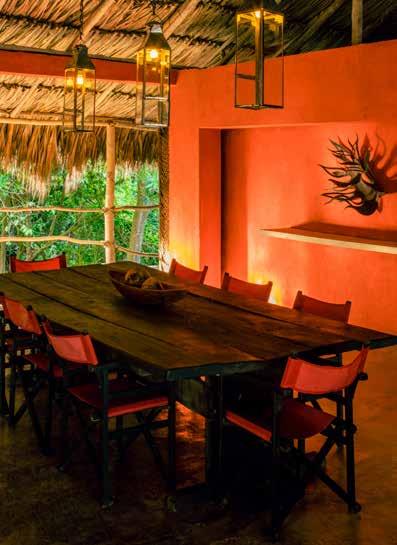
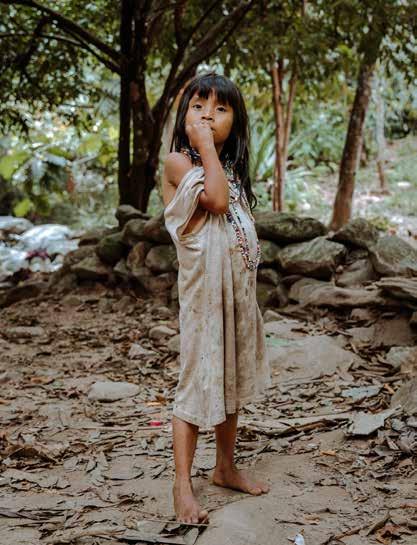
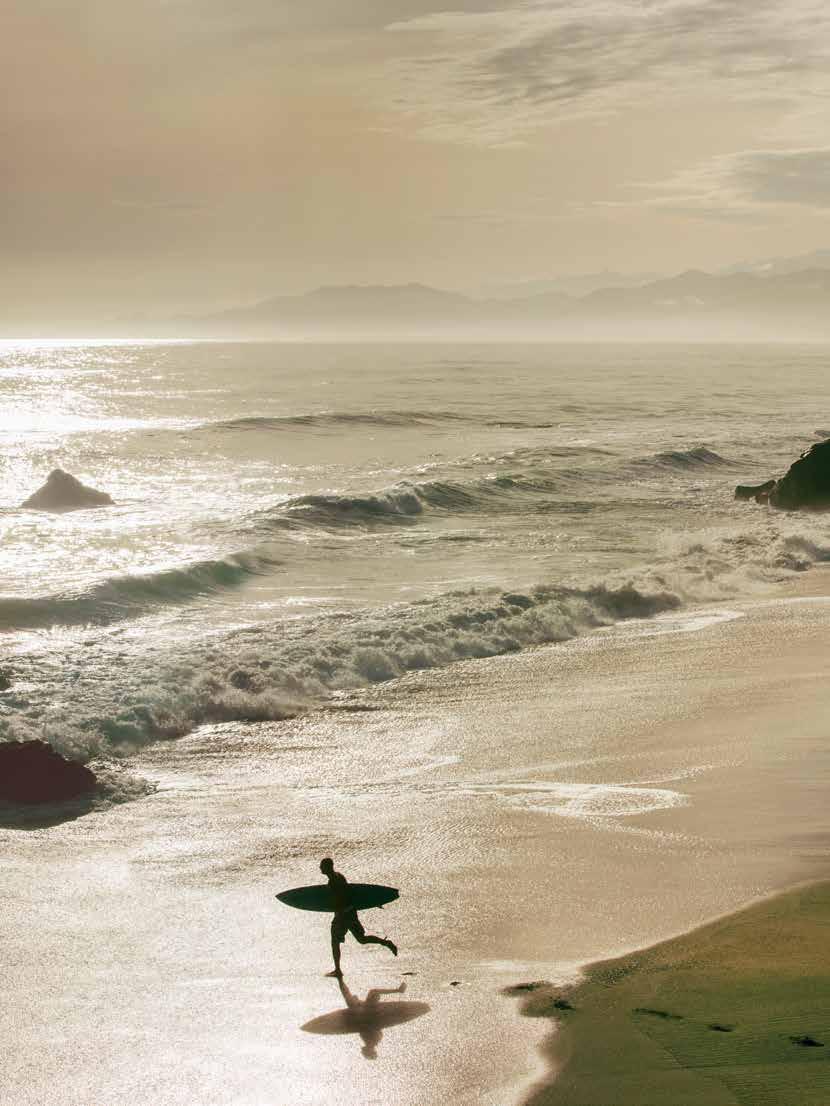
Located 460 miles northwest of Cartagena, Providencia is an eight-square-mile emerald-green speck in the ‘Sea of Seven Colours,’ produced by the third-longest barrier reef system on Earth. To reach Providencia, you need to take two flights, one from Cartagena to San Andreas — another castaway island — and on to Providencia. Make the journey and you’re rewarded with a Caribbean of yesteryear, characterised by deserted white sandy beaches, sun-peeled beach shacks and turquoise shallows that extend to untouched reefs. Whether snorkelling or diving, you’ll likely spot macro critters among pirate wrecks and corals, turtles, eagle rays and Caribbean reef sharks. If you’re strapped for time, the Rosario Islands are a worthy contender and closer to shore.
Among many of its accolades, Colombia also boasts the edge of the world. Located in the
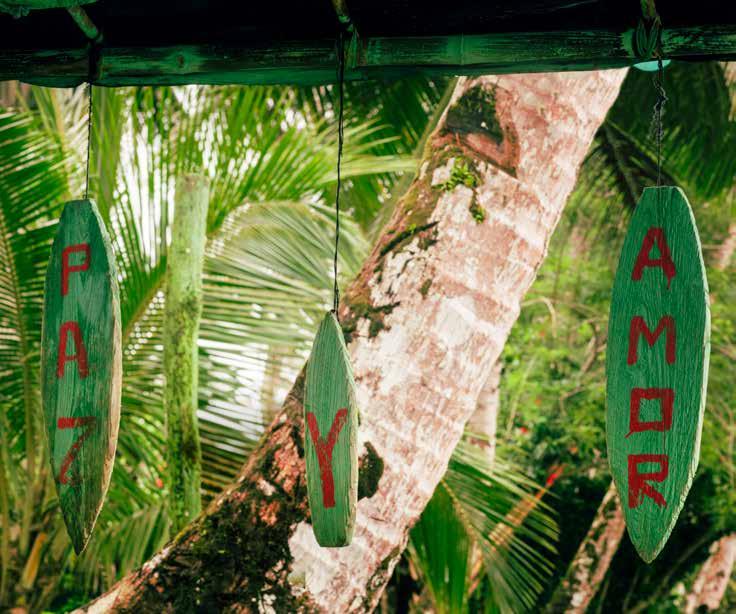
Caribbean desertlands of La Guajira, Punta Gallinas is an adventure to get to. We get an early morning 4x4 from Cabo de la Vela and watch the sunrise over the cacti-covered desert as we navigate dusty roads that eventually give way to sand dunes; it feels like being on Mars. The heat shimmers and I catch sight of a flock of bright pink flamingos scattering in the distance, wondering if it is a mirage. Punta Gallinas is the most northern point of South America and one of the few places in the world where the desert meets the ocean, and we sprint down towering dunes and dive head first into the turquoise ocean. When night comes, we sleep in hammocks under the bright hazy band of the milky way. On the way back, we see the vivid colours of kites out at sea — La Guajira is also one of the world’s best places for kitesurfing.
From Punta Galleria, it seems apt to finish at our first point in Colombia, where I stroll the cobblestone streets of Cartagena for a final time before continuing my journey to Panama. Yet my leaving is bittersweet, there is so much I have yet to explore in this country. The Amazon waterway that carried Che Guevara to Leticia from Ecuador, the ‘Liquid Rainbow’ Caño Cristales river; the rugged, remote Pacific Coast and Malpelo Island, Colombia’s answer to the Galapagos. Colombia brings an enchanted narrative to everyday life and will leave you wanting to come back for more.
•
Contact one of our Colombia specialists: +44 (0) 20 7801 1750
The capital is the perfect place to start your Colombia trip, home to Spanish colonial-era architecture, a thriving restaurant scene and striking street art you can explore on a guided bicycle tour.

Few destinations elicit more positive feedback than Colombia. The intoxicating combination of super-friendly people, gorgeous scenery, sensual cities and relative under-the-radar nature make this a Latin American gem. The difficulty? Knowing what to prioritise and what to leave out unless you’ve got a month or more to explore. That’s where our Colombia experts comes in, with their ability to tailor the perfect itinerary for your interests, time and budget.
Steffany is Colombian born and bred and on hand to make any and all last-minute plans for you when you’re in Colombia. While we will have put together a detailed itinerary, she can book boat trips around the glorious Rosario Islands; tubing along Dondiego River; a guided walking tour of the Cocora Valley or the chance to sample the finest brews in the Coffee Triangle.
Fast Facts
• Size: 440,831 square miles


• Capital: Bogota
• Population: 52,800,000 (Aug ‘22)
• Density: 119 people/square mile
• Pick a Number: 35%. The amount of Colombia in Amazonia, a region that forms part of the wider Amazon rainforest.
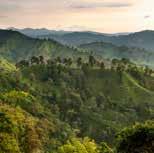
• When to Go: December to April is the best time to visit, with September and October the wettest months.

One point of contact Contact one of our Colombia specialists on + 44 (0) 20 7801 1750


plantations, riding
hiking in the beautiful Cocora Valley and staying in a lovely hacienda tucked away in orange and cassava plantations.
walled Old Town by day, and a Concierge-planned party by night.
One Hundred Years of Solitude (1967) by Gabriel García Marquez, chronicling seven generations of one Colombian family. A stone cold classic.
Narcos (2015); Comes dangerously close to lionising Pablo Escobar, but this TV series chronicles the late 20th century cocaine years very well.
To vallenato , Colombia’s unique blend of Spanish and African rhythms, which will soundtrack your trip.

Casa Orependola: Survey the majestic Sierra Nevada de Santa Marta mountains along Colombia’s north coast from this lodge, which is often above the clouds.
La Mulata: Enjoy Cartagena’s finest Caribbean cooking at this very cheap and very cheerful joint in the Old Town.
El Cielo: Marvel at the miraculous molecular gastronomy in this Medellin classic, often voted one of Latin America’s finest.
The fabled Gold Museum in Bogota is home to a staggering 34,000 gold items from pre-Hispanic Colombia. In this real-life El Dorado you can learn about the myths of allgold cities that obsessed 16th century European adventurers.

As a country with myriad different ecosystems, and a key stop en route for pan-American migratory species, Colombia is the gold standard (appropriately enough) for birdwatchers. We can tailor-make a trip to incorporate the finest habitats with specialist birding guides.

The BBC: That’s the Bogota Beer Company, a one-stop bottle shop in the capital serving the country’s best beers and, if you must, cocktails.
San Agustin Archaeological Park: UNESCO World Heritage site home to mysterious early AD megalithic sculptures of gods and creatures.
Days 1 - 3 Days 4 - 5 Days 6 - 9
As before, Cartagena is a gem, and these suggested itineraries could be combined into one epic trip. On the subject of gems, you can learn about the emerald trade in Cartagena, or explore fishing villages and mangroves beyond the city.
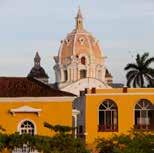
Time for some beachfront R&R on Isla Baru, part of the Rosario & San Bernando Corals National Natural Park. Swim, snorkel, sea kayak, laze in a hammock and enjoy super-fresh seafood while staying in a charming eco-lodge

Your last stop is Tayrona National Natural Park, home to more beautiful beaches, reefs and walking trails through dramatic forest-clad hill country home. Go on wildlife treks to spot myriad species and make time to visit the pretty town of Santa Marta

Jordan is a small country, but even within so diminutive a destination there are places that few – if any – visitors reach.
words by STANLEY STEWART trip by ORIGINAL TRAVEL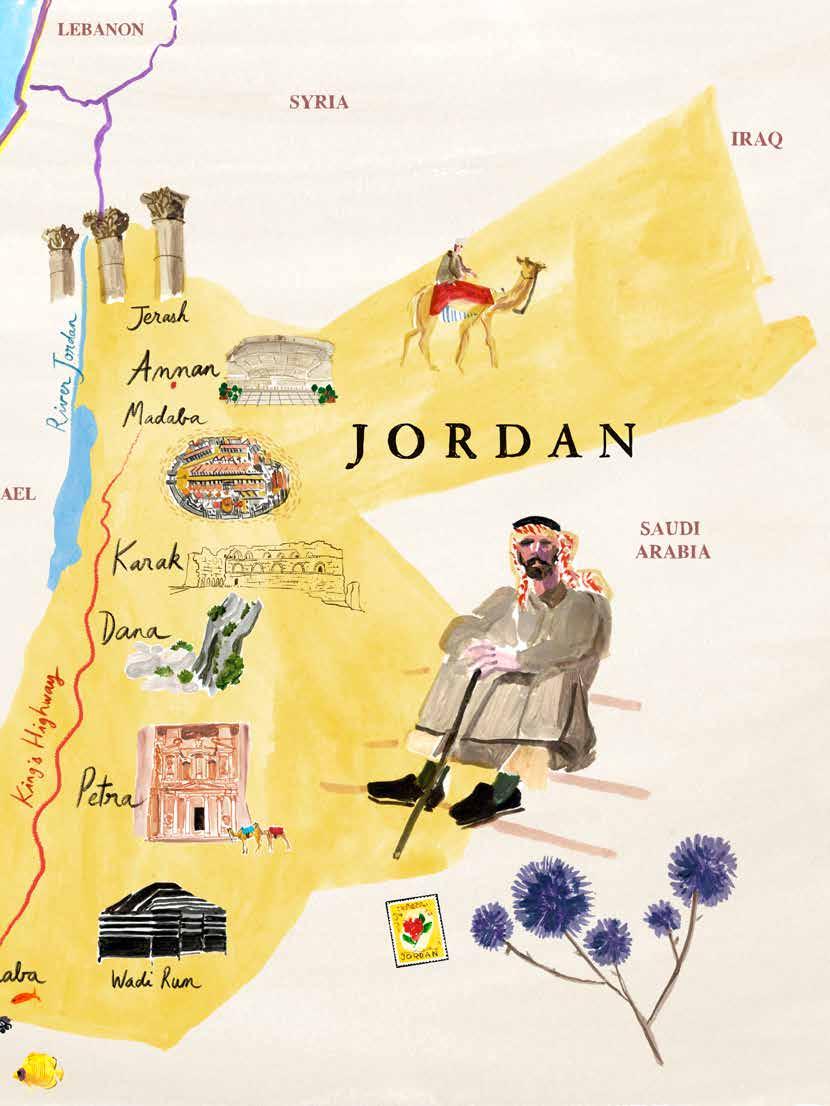
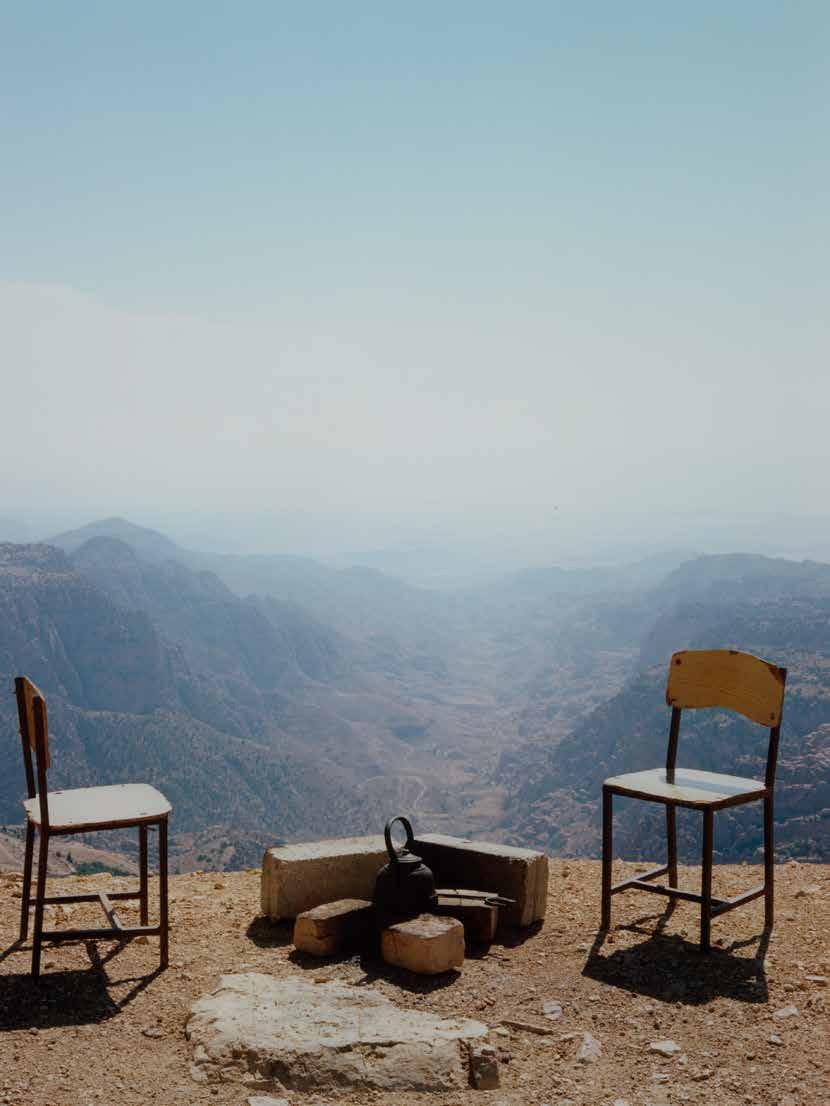
In Madaba, in northern Jordan, my daughter and I were lost in a labyrinth of empty lanes. We were looking for a restaurant but it was late, and round every corner we found the same silent alleys with their flickering streetlamps. Finally a man appeared, coming towards us, passing in and out of the pools of light. He wore an Arab robe, and the chequered keffiyeh scarf beloved of Palestinians. He was bearded and dark. I felt Sophia shrink a little towards me. ‘He looks like a terrorist, Papa’, she whispered.
I stopped to ask the terrorist the way. ‘Yes, yes,’ he smiled. ‘I will show you.’ And with that he led us out of his way to the door of the restaurant, to shake our hands, and to wish us a good dinner. As we stepped into a bustling courtyard of tables, laden with the delights of the Middle Eastern cuisine, Sophia looked a little abashed.
Travelling in Islamic countries is invariably a delight. Across the Middle East, anyone stumbling to say ‘thank you’ in Arabic – shukran, by the way – is folded into a warm metaphoric embrace. Here you are never a mere tourist, wandering around looking lost. You are a guest. And there are few better places in the world to be a guest than Jordan. In Jordan, Sophia would be able to step beyond stereotypes. The traditions of hospitality in this small, relatively poor, country are such that it plays host to two million refugees.
Since the disaster of the civil war in Syria – formerly the most charming place to visit in the Middle East –Jordan, its smaller cousin, has seen visitor numbers soar. For the traveller, its ingredients are similar – evocative ancient ruins, Byzantine churches, Roman watchtowers, spectacular landscapes, the fragrant cuisine of the Levant, the elegant manners of the Arab world. From the ancient city of Madaba in the north, barely half an hour from Amman’s international airport, Sophia and I set off with a car, a driver and a guide down the ancient King’s Highway, a route as legendary and evocative as the Silk Road, an artery of commerce and conquest, of civilisation and religion, since prehistoric times.
History in Jordan is dizzy-making. We veered from the beginning of metal working, 6,000 years ago, to the Bi-
blical kingdoms of Edom and Moab to Churchill drawing national boundaries after WWI. Characters crowded in on us along the King’s Highway – the Queen of Sheba on her way to meet Solomon, Moses on his way to the Promised Land, Lawrence of Arabia on his way to surprise the Turks at Aqaba. Familiar names came and went like party guests – Richard the Lionheart, John the Baptist, Saladin, Cleopatra, the Prophet Muhammad, the Three Wise Men, the Roman emperor Hadrian. If school lessons had made history seem a little dry, a little abstract, for Sophia, then here it all came vividly to life.
Jordan has more fault lines than a television soap opera. Geologically, the country is split by the Great Rift Valley, which pushes spectacularly into the Middle East along the line of the Dead Sea and the Jordan River, creating some of the most astonishing canyons this side of the Grand Canyon. Historically the country marked the frontier between the Roman Empire and its enemies to the east, between the Crusaders and the early Muslim sultanates, between Palestinians and the new Zionist state.
But the oldest fault line here, is that between Cain and Abel, between the farmer and the shepherd, between settled and nomadic people. There are many ancient cities in Jordan, and plenty of farmers nurturing fields of wheat and groves of olives. But this is a country with deep nomadic roots, and across its wilder spaces are pitched the tents of Bedouin who still adhere to a semi-nomadic lifestyle.
Beyond the River Jordan with its irrigated fields of fat watermelons and its greenhouses of riotous tomatoes, a turning leads to Wadi Faynan. As the road began to unravel from asphalt to a stony track, a ramshackle 4x4 waited to carry us onward the last few miles up the valley. We were crossing into a different world, a rough, boulder-strewn, bony landscape where nomads flourish. We forded a wide dry river bed, clattering with stones. We paused by an ancient site, a chaos of crumbling foundations and of broken buildings. Faynan may look like bleak emptiness but even here the weight of history is astonishing. Man first arrived here 500,000 year ago with his stone tools. Archaeologists have found evidence of substantial copper mining and smelting in Faynan, a key moment in human development,
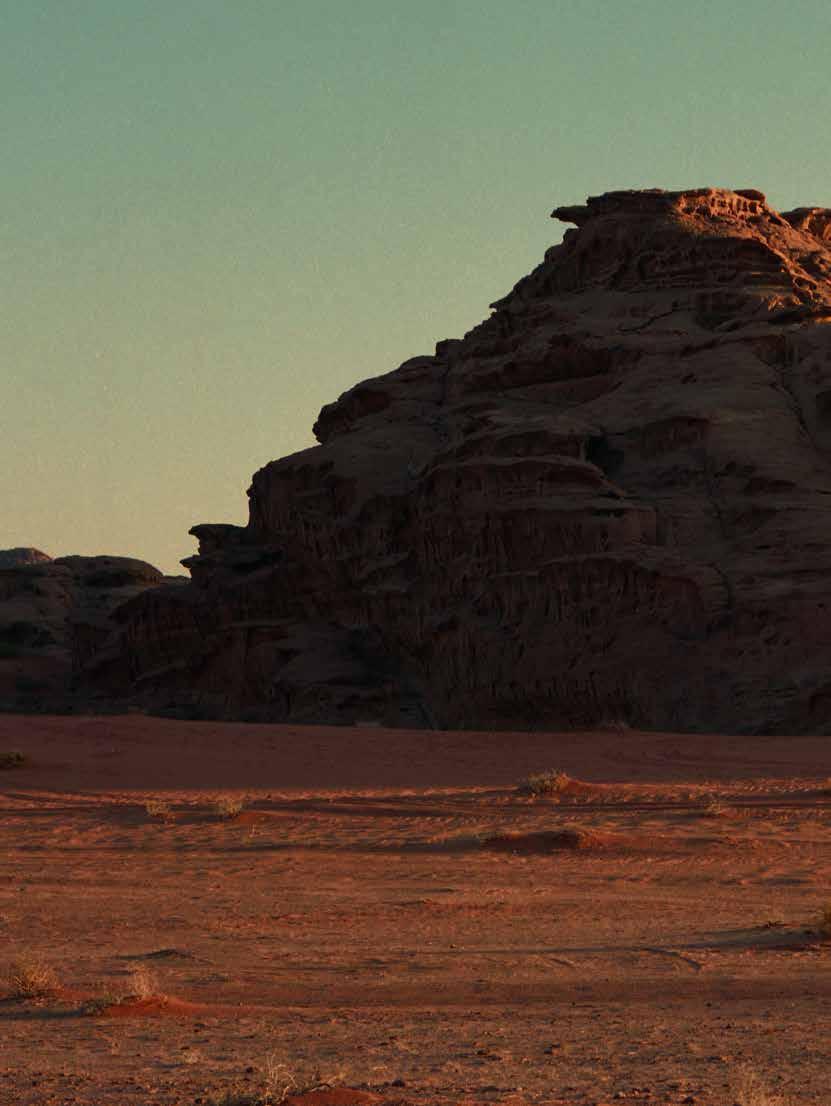
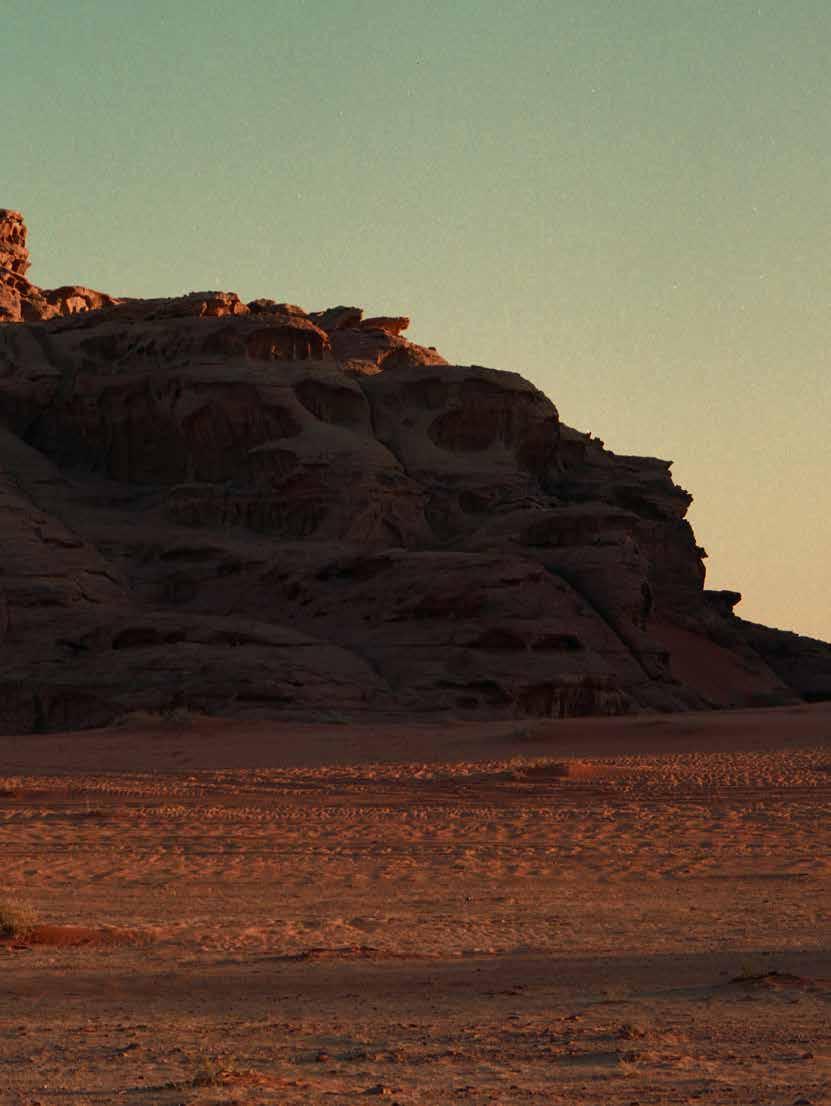
‘From beyond the tent flaps came those timeless sounds, the tinkling of bells, the sound of voices in the open air, trailing across the valley.’
from roughly 4,500 BC. Copper mining finally staggered to a halt in this region barely 30 years ago. It was the kind of continuity that shrinks time.
At the far end of Wadi Faynan, past the winter tents of nomads, past the tiny minaret-less mosque, past the government school, was our eco-lodge accommodation, its back to steep rising ground. Designed by Amar Khammash, a vernacular Jordanian architect, the lodge is reminiscent of a Moroccan riad or a Berber kasbah in the Atlas – plain adobe walls curving into one another, old wooden doors, a lounge of cushioned divans, a fireplace for chilly evenings. Our room had a view of olive trees, a spring and rose-coloured boulders. At night the lodge was lit with lanterns. It felt like the 4x4 had dropped us into one of the books of the Old Testament.
In the morning Ali, the manager, took us to meet his relations who were camped along the valley. Nomadic traditions struggle in the modern world, and the idea behind the lodge, supported by Jordan’s Royal Society for the Conservation of Nature, is that it should act as a support for the 80 or so Bedouin families who traditionally camp in this valley. 50% of the lodge’s income goes to the nomads who supply the lodge with meat and bread while over 20 local Bedouin are employed directly. Guest visits to the tents offer an opportunity to explain their lifestyle.
I have travelled among nomads in many places in the world, and I was happy here to be among them again, sitting cross-legged on a carpet with a glass of sweet tea. But Sophia came into this world for the first time, and gazed about her at this strange example of extreme camping. The wind bellowed the tents sides like sails and the ropes creaked like rigging. A cradle hung from the tent poles. An orphaned lamb lay curled in a basket while a black kettle nestled on the embers of a fire to one side. From beyond the tent flaps came those time-
less sounds, the tinkling of bells, the sound of voices in the open air, trailing across the valley.
We were in the tent of Om Hussein, in her 70’s, and her daughter Radia. The menfolk were away with the flocks, a day’s journey to the south where the grazing was good. While Radia showed Sophia how to operate the small ground loom on which the Bedouin produce carpets and textiles with their complex abstract patterns, Om Hussein made bread, laying the flattened dough directly in the coals of the fire. It took five minutes to bake and, once you had knocked off the ash, it was the most delicious bread we had ever eaten.
In the evening, we lay on the roof of the lodge star-gazing as our guide led us around the constellations. The night was warm and fragrant, and the darkness of this nomad valley made the stars burn brightly. With a turn of our heads, we travelled millions of light years through the dark windows of the universe. I told Sophia of the nomads in Africa who had the wonderful notion that stars were the fires of their ancestors, and that their transit across the night sky showed that they were still on migration.
In Jordan, it seems that all roads lead to Petra, the mysterious city that lies hidden in the deep canyons of the mountains to the east of the Arabah valley. Petra was the capital of the Nabateans. They were originally nomads, migrating with their flocks in this wild region, pitching their tents and inhabiting the caves that riddle these soft limestone hills. As a side hustle, they began raiding the caravans that made their way along the King’s Highway from Damascus to the Red Sea. Brigandage soon turned to trading, and the Nabateans grew rich and settled. By the second century BC the nomads who had known only tents had built one of the most
East.
spectacular ancient cities of the Middle
‘That night I told Sophia of the nomads in Africa who had the wonderful notion that stars were the fires of their ancestors, and that their transit across the night sky showed that they were still on migration.’
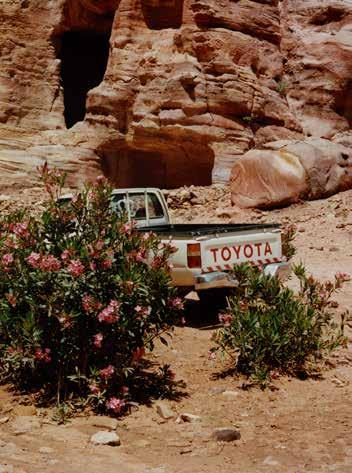
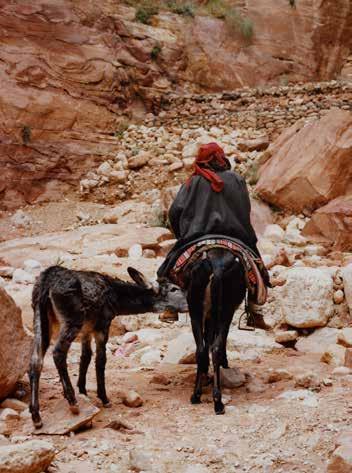
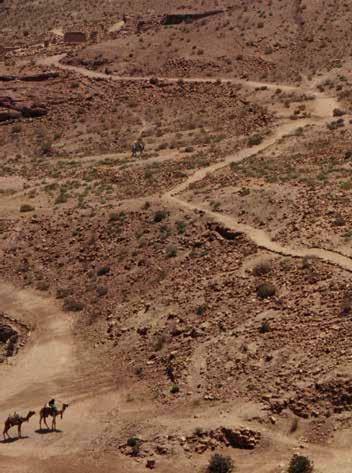

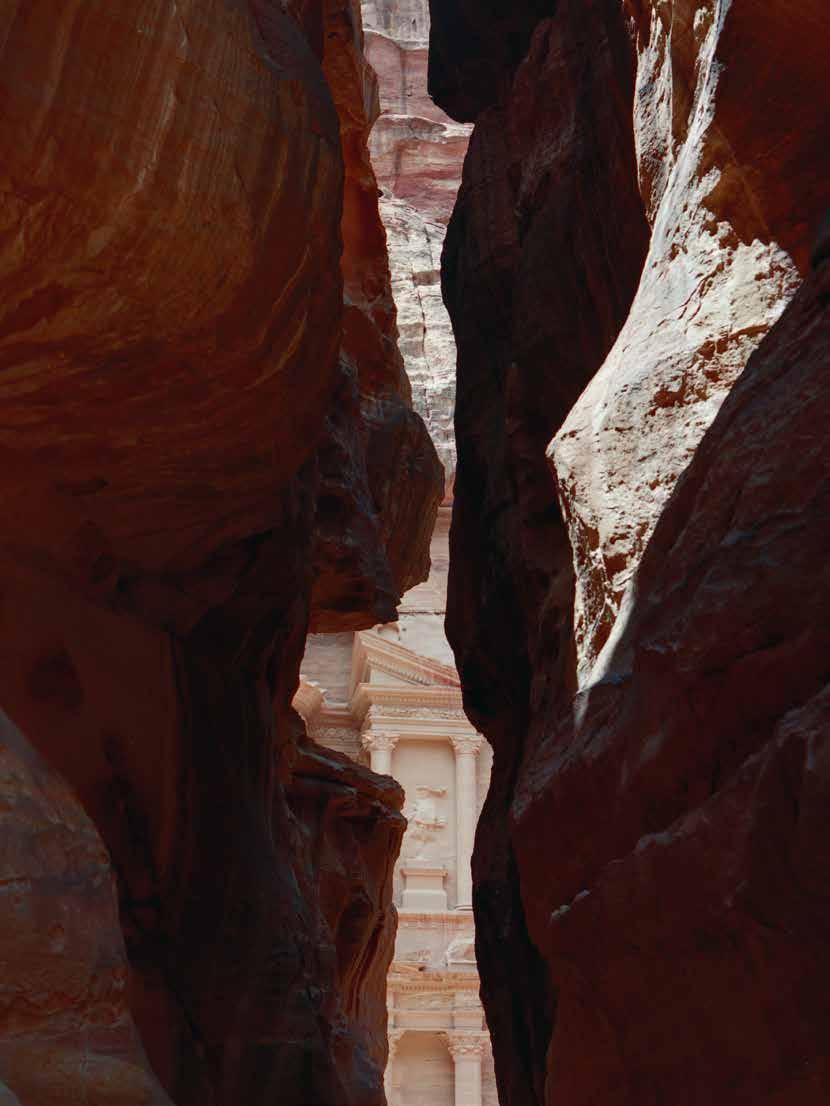
Two things are striking about Petra. The first is its secretive nature, as if the instinct of brigands, the need for a hideaway, still survived. The second is that, at least initially, the idea of buildings independent of the mountains themselves seemed too great a leap for the Nabatean imagination. Without any architectural traditions of their own, the Nabateans borrowed everything from the Hellenistic world, carving splendid facades of classical columns, pediments, and Corinthian capitals across the faces of their sandstone cliffs. But when you stepped through the grand portals, you found yourself, not in a building, but in a cave.
You reach Petra at the end of the Siq, a narrow passage, marking a dramatic geological fault. Almost a mile long and in places barely ten feet wide, this rock corridor is confined between sheer walls rising from 300 to 600ft in height. As you come round the last bend and finally see the magnificent façade of the Treasury, bathed in sun, framed by the canyon walls, it is one of the great theatrical reveals – a city hidden in mountain gorges.
But Sophia and I came to Petra another way, along the back route, a ten-mile hike across the desert. It took us through a Biblical wilderness. An uninhabited place of rock and mountain, of scrub and desert, it was an elemental landscape stripped of all fussy details. Through its gravel and sand skin you glimpse the hard ribs beneath. Rock escarpments reared around us, their flanks veined with mineral colour. A bul bul sang, and a flock of Seljuk doves rose as one from a canyon far below. Goats appeared, dancing balletically along ledges, and then high up somewhere, a shepherd silhouetted against the sky. Our voices echoed back to us off rock faces. In small gullies, vegetation appeared, banks of tulips, their purple flowers veined with yellow.
Round bends we suddenly found precipices falling dramatically away beneath the track where stunted, contorted trees clung by fingernail roots to the rock. High up in this wilderness, we found two sisters living in a small cave. Their wayward goats wandered across a stony plateau in search of grazing. They invited us for tea and cake. We sat in the sun on a bench by the cave entrance. The older of the two sisters called the goats with a wonderful trilling noise which Sophia and I tried to imitate, to assist with the round up.
‘You sound mad,’ the younger sister said, making a face of disgust.
‘She is not a nomad,’ the older sister laughed. ‘She prefers the town.’
‘It is ridiculous to be living out here in a cave,’ the younger sister said, getting up and going inside to lie down on a mattress.
The older sister shrugged. The fault line between the settled and the nomadic ran through this family.
‘She does not understand the beauty of this place,’ the older sister sighed –generously gesturing to include Sophia and I – ‘as we do. She does not appreciate the freedom to move, unconfined by walls.’
She leaned back against the rock face and stretched her legs. ‘When Allah made the world, he gave all these empty places to the Bedouin. We are lucky.’ Then she gave us each a small polished stone for luck, and we walked away into this beautiful wilderness towards the mysterious city that the nomads built. •
‘We came to Petra along the back route. A bul bul sang, and a flock of Seljuk doves rose as one from a canyon far below. Goats appeared, dancing balletically along ledges, and then high up somewhere, a shepherd silhouetted against the sky.’
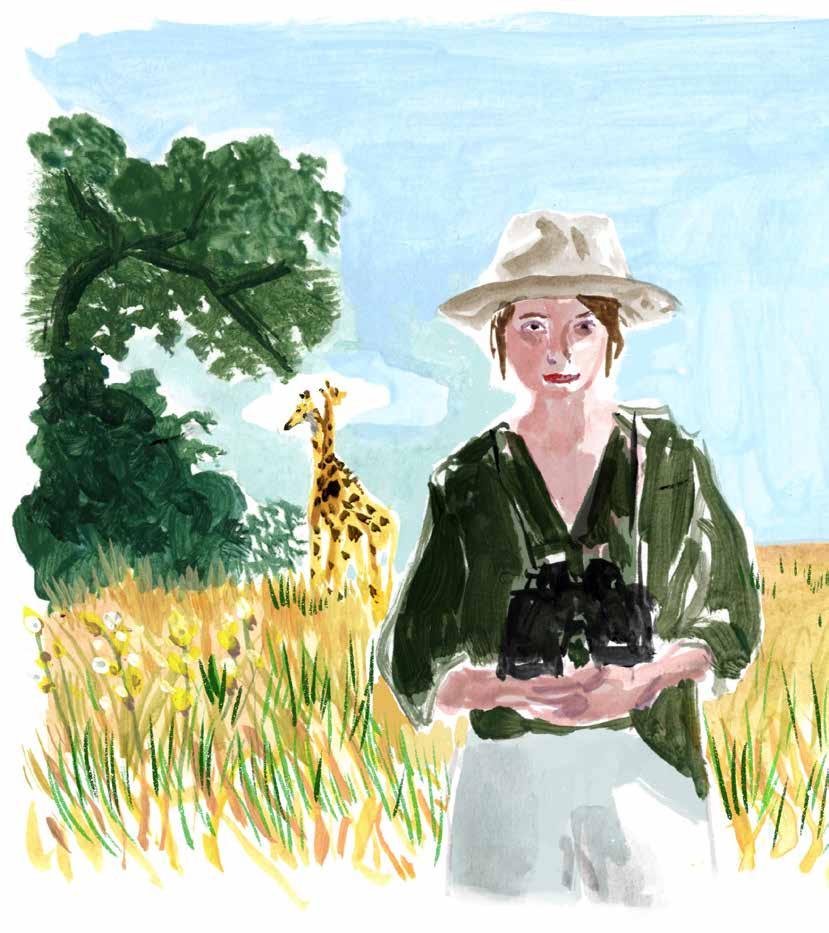
From identifying a kudu’s bark to knowing the trees that leopards love, here are ten tips to increase your animal-spotting chances.
On safari, it's a given that your guide will be able to call upon significantly-better vision, hearing and smell – all fine-tuned by years in the bush – than you, and will thus be responsible for nearly all wildlife sightings. That said, he or she can't be looking in all directions at all times, and especially not when driving. As a result it can make a real difference if you’re scanning as well. Not only will you feel a sense of pride when spotting that leopard or (more likely) giraffe, but doing so means you’ll leave with more memories to cherish forever. Here are ten hacks to help you become a more prolific ‘spotter’. Some involve technology and others are knowledge-based; then there are those more contingent on mindset or technique. Learn these and you’ll soon earn your eagle eyes.
words by RICHARD MELLOR illustrations by CASSANDRE MONTORIOL
Because of how we read and write, most westerners’ eyes are used to tracking from left to right. On safari, that tends to become our way of scouring the horizon, too. Reverse things — so survey from right to left each time — and the novelty immediately forces your brain to be more alert. This is a hack commonly deployed by guides when doing 180 or 360-degree sweeps of forests, riversides, rocks or plains. While scanning, look for unusual, out-of-place shapes or colours — and be prepared to accept that at least 50 per cent of them will, maddeningly, turn out to be termite mounds rather than prides of lions.


Prey animals from baboons to francolins emit specific warning calls, usually to alert other group members, whenever glimpsing a predator. However, these range wildly in usefulness: small birds or tree squirrels are frightened by umpteen creatures, while jittery impalas are famous for false alarms. ‘Lion!’ they might as well be yelping to one another. ‘Whoops, sorry: it’s only an ostrich.’ The safest bets — and thus the best alarm calls to learn to recognise — are those of bushbucks, nyalas and, most reliably of all, kudus. The latter’s loud bark tends to be a cast-iron guarantee that a lion, leopard or cheetah is close. Pinpoint the kudu call, and you’ve a great chance of locating the elusive predator nearby, especially if you can see the direction in which the sentinel is staring.
Other iconic animal noises are also worth listening out for. There’s the howl of a jackal, or wild dogs’ haunting ‘hooo’. Male lions’ primitive nocturnal roars (sometimes audible as much as four miles away), trumpeting elephants or hippos’ petering-out grunts make for more common, vintage bush soundtracks. African fish eagles’ screeches are another great one to identify — due to the unimpeded waterside perches that these large birds prefer, they’re usually easy to spot once you determine one is in the vicinity.

Leopards notoriously like to haul their kills up into trees, where other bigger, but non-climbing, predators can’t plunder them. The cats are also known for enjoying sylvan dozes in that classic pose where their legs hang slumberously off branches, and for patiently hunting from the foliage. Less recognised, however, is the fact that they tend to favour only certain trees. Shady jackalberry or sausage trees, marulas and weeping Boer beans are all perennial favourites. These felines additionally tend to be habitual, so it’s always worth checking trees where ones have been spotted recently.
All game have preferred habitats. Take giraffes: the lanky ruminants demonstrate a wide-ranging herbivorous diet yet relish acacia-tree leaves above all. That same genus –along with sycamore figs – proves popular among Uganda’s tree-climbing lions, too. Cheetahs, meanwhile, are most often found in open, flattish grasslands, where they’re offered some cover when hunting but can still clock dangerous hyenas or lions from afar.
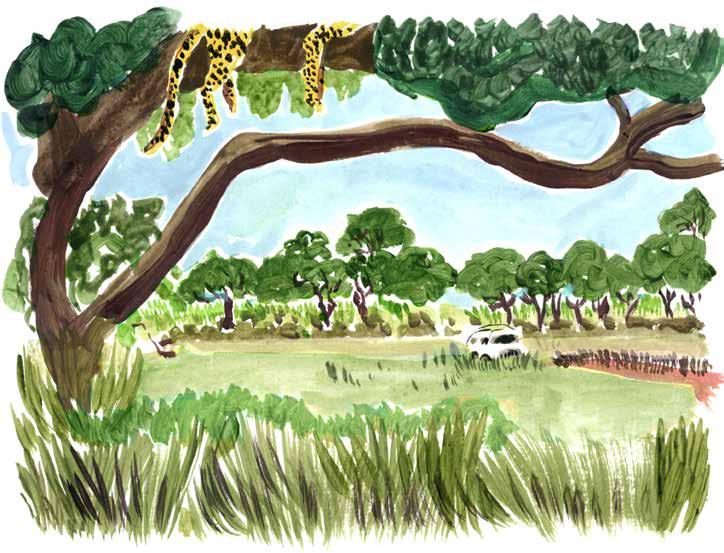
It’s a wholly unpleasant smell, but the putrid stench of an animal carcass is like a safari flare: until completely devoured, remains may be the scene of scavenging hyenas, vultures – perhaps waiting in trees or ominously circling above – and, when near water, crocodiles. If you’re very lucky, the killer or killers themselves might still be present, resting and digesting in proximity. Other useful aromas to know are the popcorn-esque pong of leopards’ scent-marking urine, elephants’ equine aroma and the cow-like whiff of buffalo herds.
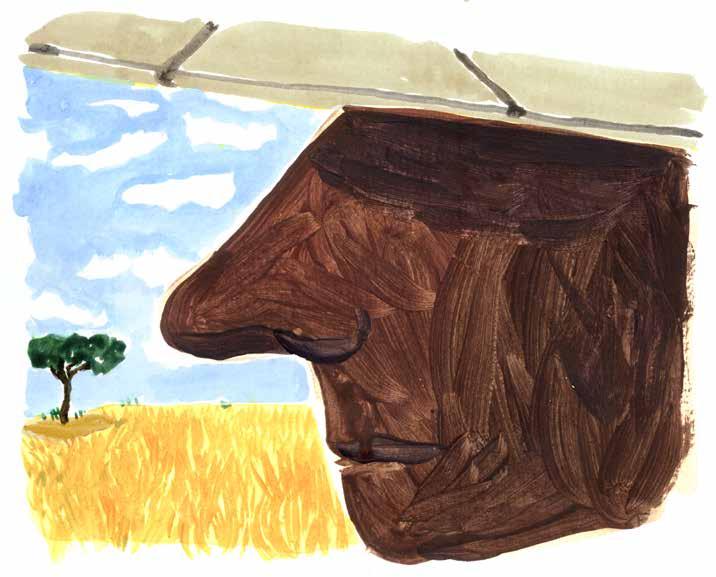
Most prey animals drink on a daily basis, normally during mornings and early evenings to avoid the heat of the day and the higher risk of attack by unseen predators — who also stalk rivers or springs at such hours in the hope of a potential feed. Consequently, lingering quietly near a water source at sunrise or sunset ought to greatly increase your chances of memorable encounters.
Elephants like to bathe or wallow once a day — sometimes the dry season precludes this — in order to cool off and cleanse themselves of parasites. They tend to ploddingly arrive at and depart from water in long, single-file lines which are magical to witness.
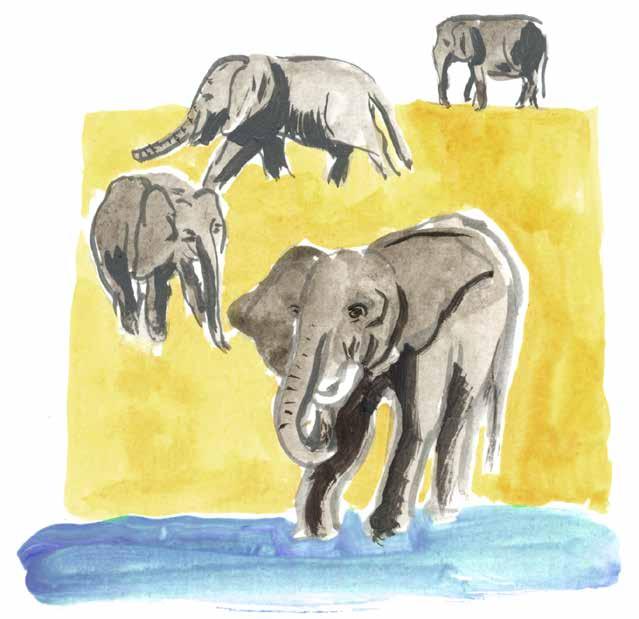
Linked to that, the cooler hours around dawn and dusk tend to be when more animals are active. Come hotter times of day, you’re better off looking under shady trees for lazing lions, for example, or seeking out reptiles using sunshine to kick-start their metabolism.
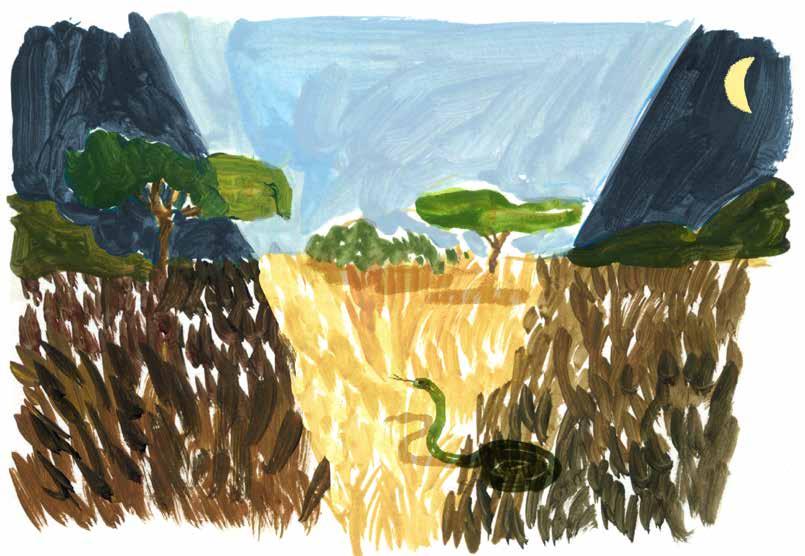
Whether sitting inside a rhino hide, monitoring a prone cheetah which hasn’t moved in 20 minutes, or staking out an inactive river crossing, it's all too easy to entertain grass-is-greener thoughts. ‘Maybe,’ your treacherous, unstimulated mind speculates, ‘it’ll be livelier elsewhere?’ Sensing your dissatisfaction, a guide might even suggest as much. In all cases, try to give it a bit longer. So often, sitting still, and quietly (this is crucial), yields wondrous rewards in the end — just as moving rarely does.
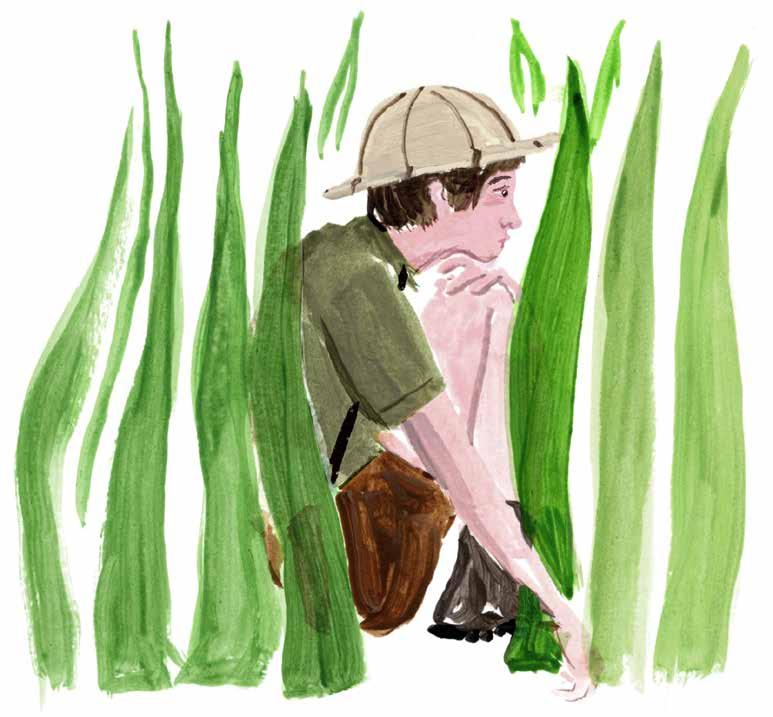
A skill often taught on walking safaris, animal-footprint identification regularly helps guides to locate beasts. In particular, as lions love to use human roads or tracks (because they’re far less effort to traverse than dense bush), they often leave telltale tracks visible at dawn. Dew levels further clarify the recency of each footprint, and thus how close said lions could be. Their direction of travel is also, obviously, apparent.
Similarly, other forms of spoor can be vital clues for the safari detective. Fresh elephant or rhino dung is helpful evidence that those animal A-Listers passed this way not long ago; ditto the calcium-white scat of hyenas. Practise distinguishing the tracks or droppings of your preferred animal to better your odds of unearthing it.

For all your own eyes’ efforts, a pair of high-quality binoculars allow you to survey a much larger expanse of ground when looking for life, and transform far-afield sightings into something more than a distant dot. Aim for a magnification of seven or eight if stability and a wide field of view are your priorities; avid birdwatchers will prefer a higher magnification (ten or 12) to give extra detail. In terms of lens, bigger is better, but also bulkier. Trying out various binos in the shop before purchasing is prudent.
Bushnell, Leica, Nikon, Swarovski and Zeiss produce some of the finest examples, with their premium models costing as much as £3,000 (this is truly an area where you get what you pay for). Should your budget be far lower, the RSPB’s Avocet binos are very decent, compact and durable for £100 to £150. Always remember to pack your binos’ bag and rainguards to ensure a longer life.
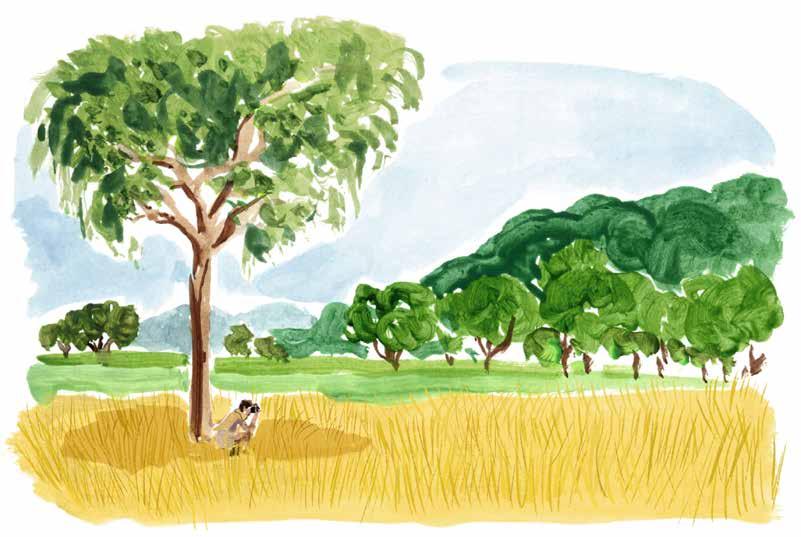
It’s tempting to overlook an area’s more ten-a-penny locals: typically impalas or gazelle, warthogs, baboons, zebras and guinea fowl. Equally, many safari-goers show little interest in birds or insects, concentrating their attention on showier beasts.
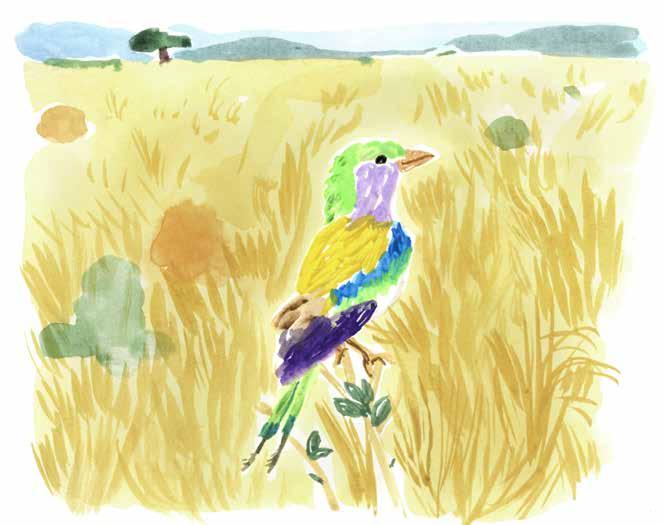
This is a flawed mentality, simply because all flora or fauna is fascinating if you let it be. Take those omnipresent impala: known as a ‘stot’, these antelopes’ run is an obstacle-jumping zig-zag performed impressively at up to 50mph. That’s one example; there’s so much amazement out there awaiting discovery, and the trick is to fully open your mind to it.
To learn more about how Original Travel help our clients safari better, visit our website: originaltravel.co.uk

The largest city in the world, Japan’s capital is the perfect distillation of a near perfect destination, and a firm Original Travel favourite.
 words by TAMARA HINSON photos by PIA RIVEROLA
words by TAMARA HINSON photos by PIA RIVEROLA
Original Travel pioneered the concept of Reconnect Travel – an approach to exploration which involves developing deeper connections with your destination, whether through more authentic interactions with locals, phone-free meanders around lesser-known neighbourhoods, or opportunities to learn about ancient crafts unique to the area. Tokyo is the perfect setting for this type of exploration – a capital city filled with opportunities to embrace all that Japan has to offer, from the very weird to the very wonderful.
First things first – Tokyo is enormous, but its sheer size means more opportunities to get off the beaten path in neighbourhoods which have been hiding in plain sight for years. Look beyond neighbourhoods such as Ginza, with its designer stores and Michelin-starred restaurants, and Harajuku, immortalised by Gwen Stefani’s Harajuku Girls back-up dancers and famous for its bubble tea cafés and independent fashion stores, and you’ll find a different city, but one equally emblematic of Japan.
There’s something wonderful about staying in the heart of a city and being woken not by car horns or screaming sirens, but by tweeting birds, the gentle hum of bicycle wheels spinning past or the ring of a bell at a nearby shrine. This is the experience in the Yanaka (which means ‘in the valley’) area. It’s part of the Shitamachi district – one which covers some of the city’s oldest neighbourhoods, despite being just a stone’s throw from the capital’s hypermodern haunts. A reminder of Yanaka’s rural roots is the century-old Himalayan cedar tree which still stands proudly at its centre. This was one of the few places to survive the bombing which obliterated large parts of Tokyo during WWII.
Until recently Yanaka was a haven of blissful tranquillity compared to the likes of neon-drenched Akihabara. Its transformation dates back to 2011, when a building used as a creative hub for artists and architects was badly damaged by the earthquake which rocked Japan. The owners decided to demolish the building, and the Japanese artists who worked there staged a series of art
exhibitions which they referred to as a funeral – a way to say sayonara to the building which had meant so much to them. The exhibits were a huge hit, and Mitsuyoshi Miyazaki, an artist and graduate of the Tokyo University of the Arts who spent much of his time in Yanaka, suggested transforming the building into a cultural hub. The owners relented and called off the sale, and before long a café, art gallery, architect’s studio and hair salon had opened inside the building. Next, a hotel arrived, but not any old hotel. The ‘hotel pool’ is a nearby sentō (public bathhouse), and the ‘gift shop’ consists of recommended local stores selling everything from rice crackers to beautifully painted Japanese ceramics, all of which hotel guests can purchase at a discount. The rooms, meanwhile, are ryokan-style (traditional Japanese inn) rooms, complete with tatami bedding and rice paper walls, dotted throughout the neighbourhood.
Tokyobike, the hip bicycle brand which now has stores all over the world (including in London, Berlin, Milan and Melbourne) was founded right here in Yanaka in 2002. As the company expanded, the founders talked about a desire to create a brand which reflected the neighbourhood in which it was founded, and which positioned its comfortable, stylish bicycles as tools for contemplation – a concept the brand referred to as ‘Tokyo slow’. Others might balk at the thought of a pedal-powered exploration of the world’s biggest metropolises, but for me, my armchair-like Tokyobike is the perfect mode of transport in Yanaka.
Next, take a turn of Tokyo’s busier neighbourhoods for another clever way to get under the skin of this city. Tokyo is filled with huge department stores, and while a visit to the city’s retail meccas might not be an obvious way to learn about a destination, Tokyo is a city which likes to throw out the rulebook. Not only do department stores such as Daimaru provide an insight into Japanese culture (arrive just before opening time to watch as staff line up by the entrance, throw open the doors and bow to the shoppers as they enter), but their basement food halls are the ideal place to learn about Japanese cuisine. Known as depachikas (a combination of depato, meaning department store, and chika, meaning basement), these subterranean food halls are filled
‘Head to the basement food hall of a department store to shop for gift-wrapped boxes of golf ball-sized grapes grown in Ishikawa; and huge honeydew melons, tied with ribbon and nestled in tissue paper.’
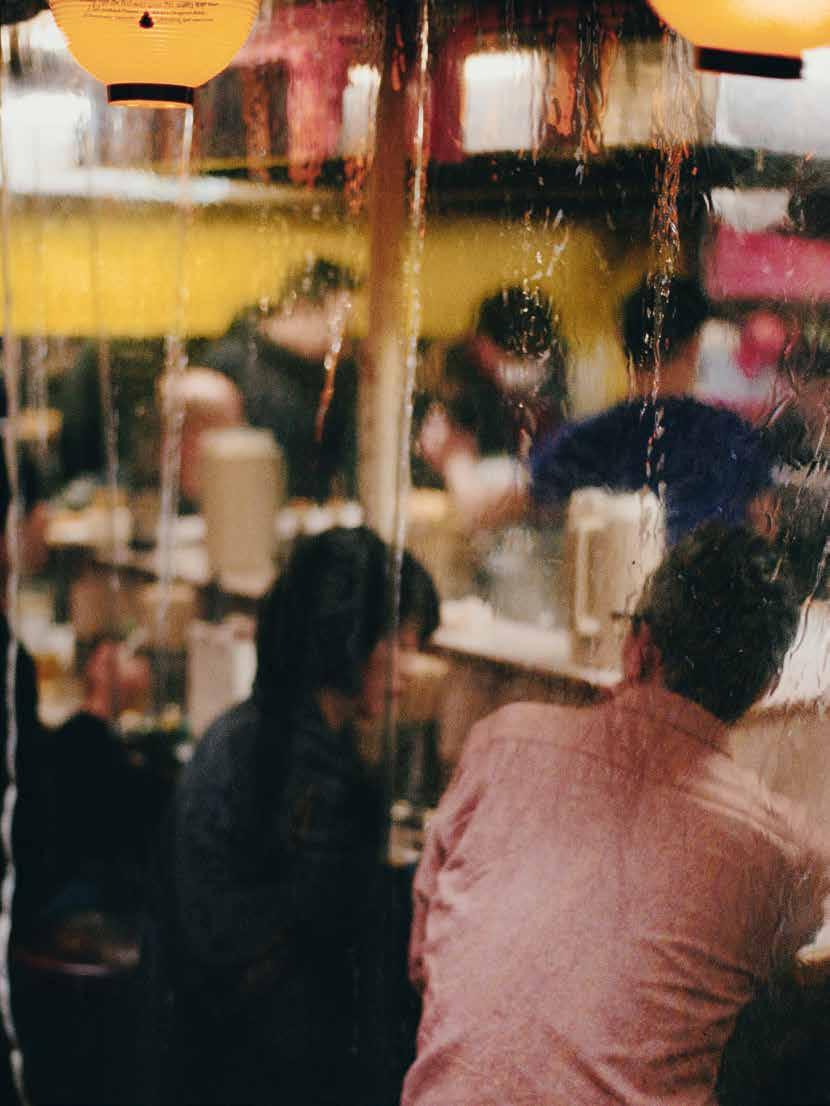

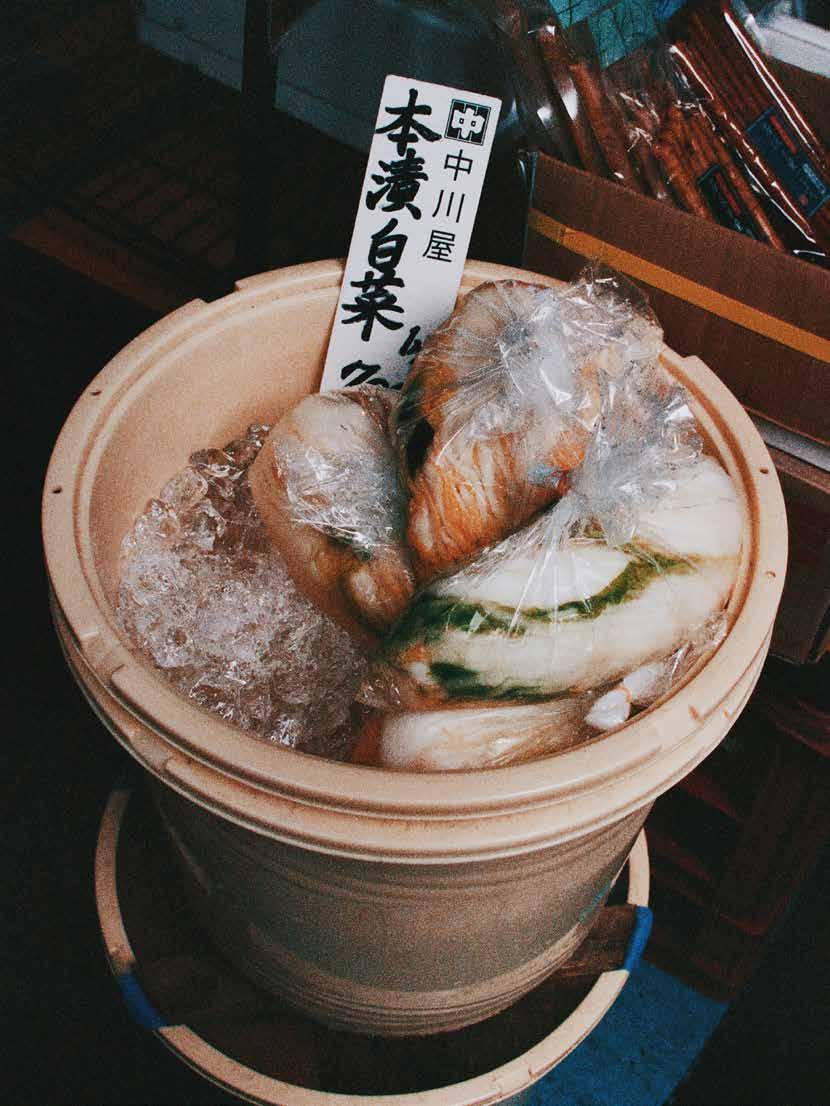
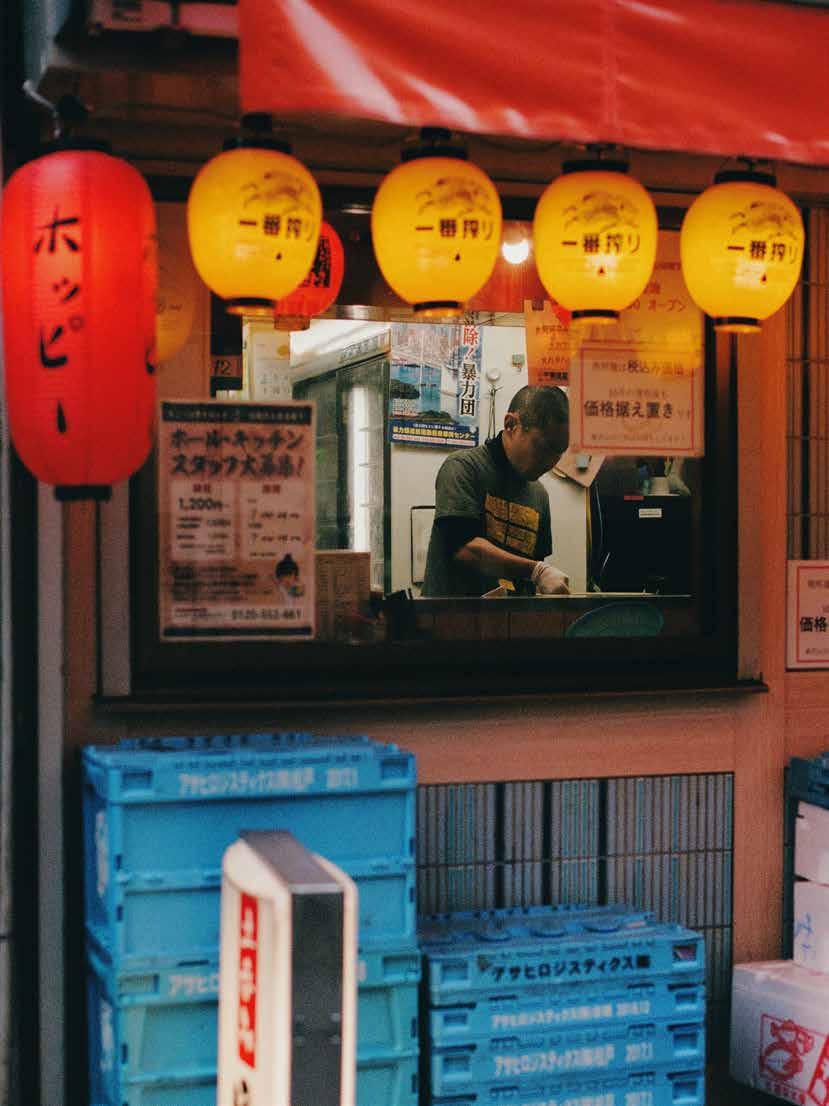

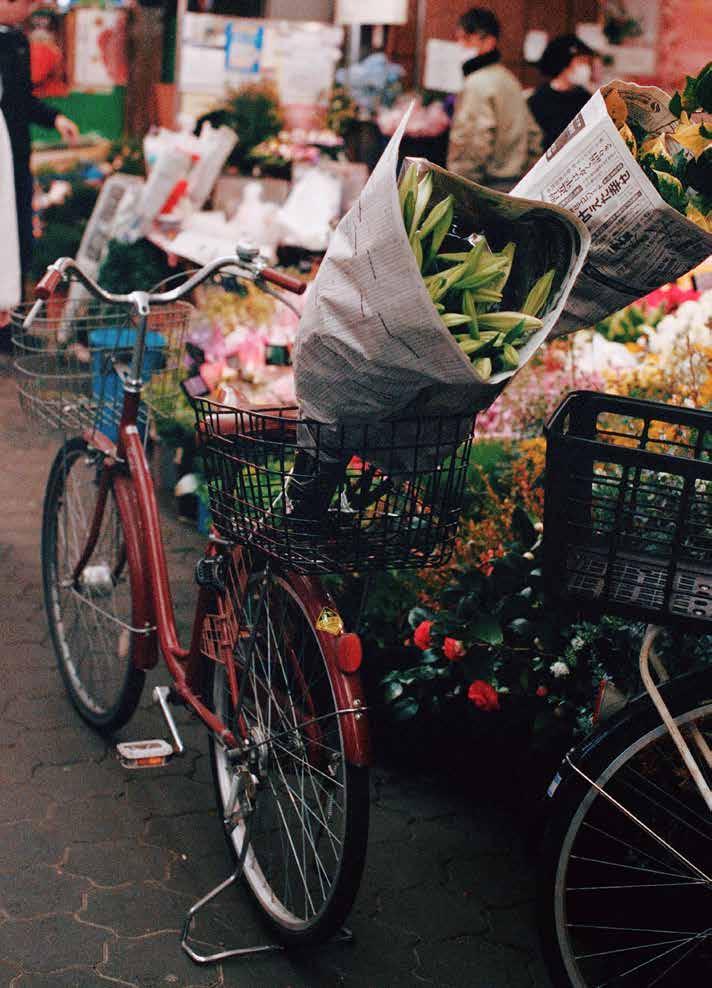
with everything from technicoloured Japanese sweets to koshu (vintage) sake from every corner of Japan. Head to the fruit and vegetable section, dominated by items designed to be presented as gifts; gift-wrapped boxes of golf ball-sized grapes grown in Ishikawa; huge honeydew melons, tied with ribbon and nestled in tissue paper. Unsurprisingly, they don’t come cheap – salarymen (and, increasingly, salarywomen) looking for a gift with which to woo a potential client should expect to pay around £40 per melon.
The patisserie sections are often the most beautiful, with elaborate displays of eye-wateringly bright yōkan (colourful cubes of bean paste adorned with intricate designs and sold in paper crackers tied with ribbon) and domes of shiny jelly flavoured with fruit juice (I recommend the ones filled with white shimizu peach juice). The depachikas are fantastic places to pick up streetfood, too. Do as the locals do and make a beeline for the areas filled with open grills laden with skewers of sizzling meat, or grab one of the bentos, the Japanese version of a packed lunch. Tokyo’s largest depachikas offer over 1,000 types of bento, so if you’re prone to indecisiveness, I suggest sticking to the skewers.
The depachikas are also an essential pit-stop for anyone planning a picnic, and luckily, there’s no shortage of picnic-worthy spots here. Tokyo’s green spaces are perfect for a spot of people watching, and one of the best is Okutama, on the outskirts but still very much within
the city limits. Hop on the Japan Rail Ome metro line in the city centre for an added dose of Tokyo like a local –nothing beats leaving one of the city’s busiest stations and watching as a wave of skyscrapers gradually recedes as you head towards one of Tokyo’s greenest areas. Get lucky and your mode of transport will be the special edition Ozashiki train, which runs just a few times every year and has traditional tatami seating.
Okutama itself is a spectacular landscape shaped by natural forces. A brilliant example of this is the 250 million-year-old Nippara limestone cave, which was discovered in 1962 and is one of the largest and oldest in Japan. A stroll through its naturally air-conditioned interior is a wonderful way to cool down during Tokyo’s hot, sticky summers – the interior of the cave rarely straying above 11°C.
When hunger strikes, wander over to Okutama’s centre, through which several rivers flow – hence its status as one of Japan’s most popular fishing spots. Don’t miss the chance to try shio-yaki, a salted local fish. Next up, some forest bathing – the latest Japanese concept to beguile hipsters in the west. Forming part of a discipline referred to as 'woodland therapy’, forest bathing is not some obscure sylvan skinny dipping tradition, rather a belief (with scientific backing) that doing anything surrounded by (ie: bathing in) trees reduces stress and improves wellbeing. The ‘anything’ in question here involves activities as diverse as soba noodle-making to exploring the woods on lovely walking trails and forest-based yoga classes.
‘Even though the Yanaka district is in the heart of the city, you’ll be woken not by car horns or screaming sirens, but tweeting birds, the gentle hum of bicycle wheels spinning past or the ring of a bell at a distant shrine.’
For a more tangible reminder of your visit to Japan, Okutama is the home of the wasabi plant, and it’s a great place to grab some of this delicious (and fiery) horseradish-like delicacy.
Back in downtown, Shimokitazawa (bonus points if you do as the locals do and refer to it as Shimokita) is just a short hop from Shibuya and Shinjuku, two of the most famous areas of the city. A former farming village swallowed up by an ever-expanding Tokyo, Shimokitazawa has, in recent years, transformed into an avant-garde neighbourhood filled with independent boutiques and second-hand vintage clothing shops. It’s also home to some of Japan’s best music stores, including Flash Disc Ranch, which specialises in 70s western music (don’t be afraid to ask handlebar moustache-sporting owner Tsubaki-san for his recommendations). I also recommend browsing the shelves at B&B (which stands for books and beer), where bookworms peruse the store with craft beer in hand.
the approach to its beautiful temple, and you’ll see a mishmash of family-run restaurants (dango – skewered rice balls – are the speciality here) and boutiques, many of which still sport their original, lovingly preserved shopfronts. But don’t be distracted, because make it to the end of the street and you’ll find Shibamata Taishakuten Temple – a 500-year-old temple filled with impossibly ornate wooden carvings, including depictions of scenes from Buddhist scripture. Wondering how they’ve stayed in such fantastic condition? Contact is kept to an absolute minimum – they’re dusted just once a year.
Shimokita
Prefer coffee? You’re in luck, because Shimokitazawa has some of Japan’s best coffee shops – tiny, beautiful cafes which are a distant cousin of the izakaya (equally tiny Japanese pubs). The quality of the coffee is generally fantastic, and baristas here love to get creative. Take Ballon d'Essai, where your caffeine fix comes with a work of art sculpted into the milk foam (the ridiculously cute teddy bear is a personal favourite).
Another area famous for its old school charm is Shibamata, to the north of Tokyo’s city centre. Wander down the neighbourhood’s main artery, which also doubles as
music.
As an almost perfect example of Tokyo as Japan in microcosm, Shibamata is also the hometown of Tora-san – the star of Otoko wa Tsurai yo (‘It’s Tough Being a Man’), a hugely popular Japanese film series which ran between 1969 and 1995. A hapless wanderer prone to romantic scrapes (picture a Japanese Benny Hill and you’re close), Toro-san would return to Shibamata after his failed dalliances and today a bronze statue of the series’ protagonist stands just a few metres away from Taishakuten Temple, attracting devotees of a different denomination. Our advice? Channel your urban adventurer and put this fantastic neighbourhood –along with the others we’ve mentioned – at the top of your hit list next time you’re in Tokyo. And if you really can’t drag yourself away from the city centre, just make sure you pick up a supersized, gift-wrapped melon.
•
Contact one of our Japan specialists: +44 (0) 20 7801 1750
‘Flash Disc Ranch record shop in
specialises in 70s western
Don’t be afraid to ask handlebar moustache-sporting owner Tsubaki-san for his recommendations.’




There’s no country on Earth where the services of a tour operator are more necessary than Japan. The language barrier and cultural differences are such that a helping hand is 100% required to unlock the complexities of what is - for us at Original Travel - the most rewarding destination on the planet. Between our dedicated Japan team, and our partners on the ground, we will ensure your trip is as memorable as any you ever take.
Your Concierge
Audrey moved to Tokyo over a decade ago and is now an expert on the culture and history of Japan, her adopted country. As an expert translator, she’s an ideal guide who uses local contacts to find you the best experiences. This includes finding a private guide, booking a table with a view, learning origami, spending a night in a Buddhist temple or visiting the best tea houses.
Fast Facts
• Size: 145,937 square miles
• Capital: Tokyo
• Population: 125,636,475 (Sep ‘22)
• Density: 861 people/square mile
• Pick a Number: 111, the number of active volcanoes in the Japanese archipelago, the third most after Indonesia and Chile.
• When to Go: March to May for the fabled cherry blossom season; September to November for spectacular autumn colours; January to April for skiing.

One point of contact Contact one of our Japan specialists on + 44 (0) 20 7801 1750
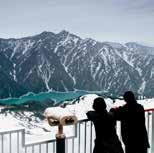
After time spent in Tokyo, head to the hills on Honshu (Japan’s main island), and Takayama in particular. This beautifully preserved old town is a wonderful place to explore, as you visit ancient merchants' homes, food stalls and sake breweries.
With its low-rise, low-key feel, the former capital is a perfect contrast to Tokyo. Take in the tree-lined Philosopher’s Walk, the famous Fushimi Inari torii gates, the golden Kinkaku temple and iconic zen gardens, and learn about geisha culture.
Pay your respects at the poignant Peace Park in Hiroshima before a short ferry ride to the lovely island of Miyajima, home to one of Japan’s most famous temples (and most photographed ‘floating’ torii gates), lovely forest walks and roaming deer

Travels with a Writing Brush, an anthology of more than 1,000 years of travel around their own country by Japanese writers.
The Seven Samurai (1954); Director Akira Kurosawa’s masterpiece, regularly (and entirely correctly) voted one of the greatest films of all time.
Listen
Solid State Survivor (1979) by Yellow Magic Orchestra ; to Japan what Kraftwerk were to Germany: proper electronic music pioneers.

Ryokans, or traditional inns, are a window into traditional Japanese home life, with intricate etiquette, bedrooms with tatame floors and futon beds, and serving extraordinarily elaborate multi-course kaiseki dinners. A must-experience on any Japan trip.
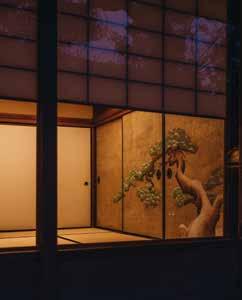
This ancient walking trail on Honshu’s Kii Peninsula is one of only two UNESCO recognised pilgrimage routes (the other being Spain’s Camino de Santiago) and a great way to get in touch with the history and spirituality of the region, with many fascinating shrines to visit.
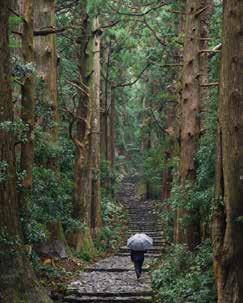
Benesse House: Part contemporary art museum, part hotel, on an island in the Seto Inland Sea off Honshu.
Hoshinoya Tokyo: The best of both worlds – ryokan-style accommodation (onsen, rice paper walls, futon beds) in a skyscraper setting with jaw-dropping views.
Sushi Dai: Tokyo’s famous Tsukiji fish market has moved, but the sushi restaurants here are still excellent, especially this one.
Hiroshima Station: Tuck into the city’s famously delicious okonomiyaki pancakes and plump oysters in the stalls under the station.

Skiing in Hokkaido: Waist-deep powder, sushi for lunch, an après-ski sake and onsen hot spring soak? Welcome to skiing Japan-style.
Days 1 - 5
From Tokyo, take the bullet train to Fukuoka, the vibrant gateway city to the island of Kyushu, then head south via onsen hot springs, Kumamoto castle (one of Japan’s finest) to the picturesque Kirishima National Park, home to hiking trails and crater lakes.

Days 6 - 7
The ‘Naples of Japan’ sits at the southern tip of Kyushu in the shadow of Sakurajima volcano. Bicycle around downtown, visit whisky distilleries, soak in an onsen or enjoy some time on the city’s beaches
Days 8 - 10
A short hydrofoil away from Kagoshima lies Yakushima Island, a UNESCO World Heritage site home to granite mountains and ancient cedar forests and criss-crossed with well-maintained walking trails. Finally, head back to Tokyo for a last blast.

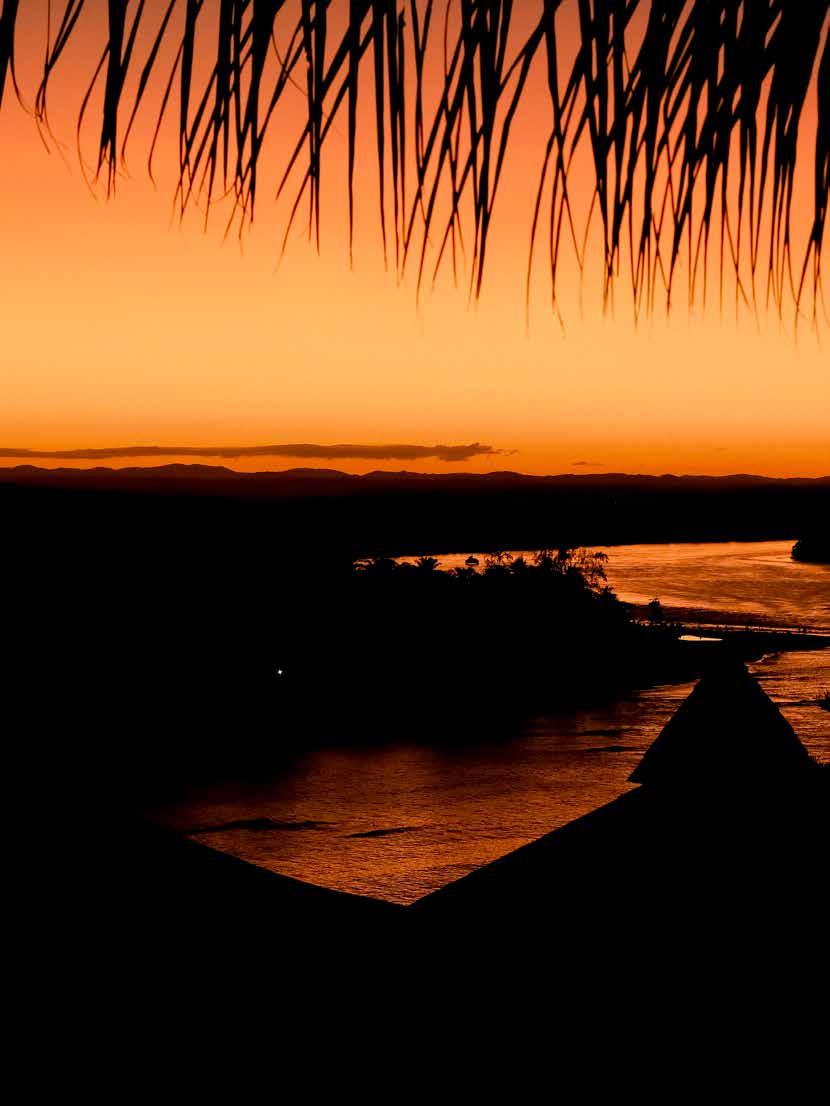
Brazil is big, bold and beautiful. From Rio’s ravishing beaches to the depths of the Amazon rainforest it’s no wonder the country’s awesome landscapes make so many bucket lists. Nowhere else can you find such a distinctive cultural melting pot, evident in the country’s Carioca (Rio dwellers) lifestyle, Portuguese colonial architecture, upscale Japanese restaurants and Afro-Brazilian synthesis. Whether it’s your first or fifth time in Brazil, the country’s sensual rhythm; artistic, architectural, musical and fashion scenes, and infectiously joyful people will leave you wanting more.
Contact one of our Brazil specialists: +44 (0) 20 7801 1750

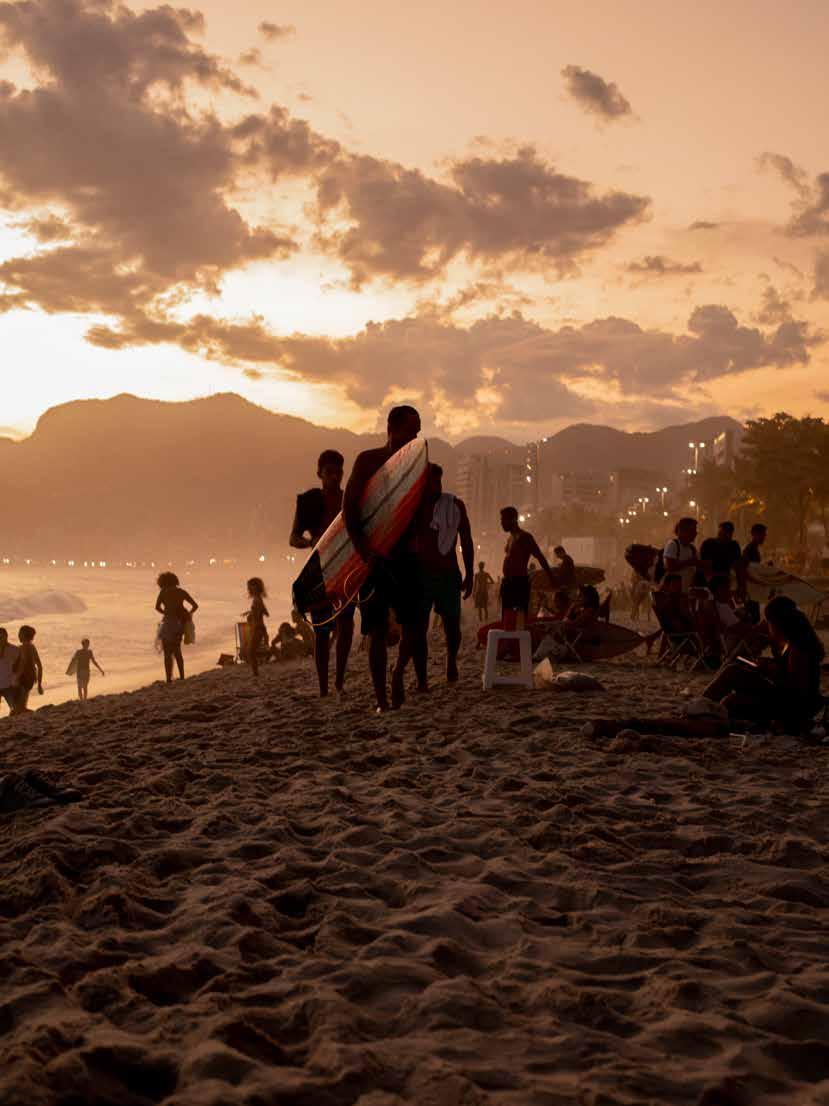
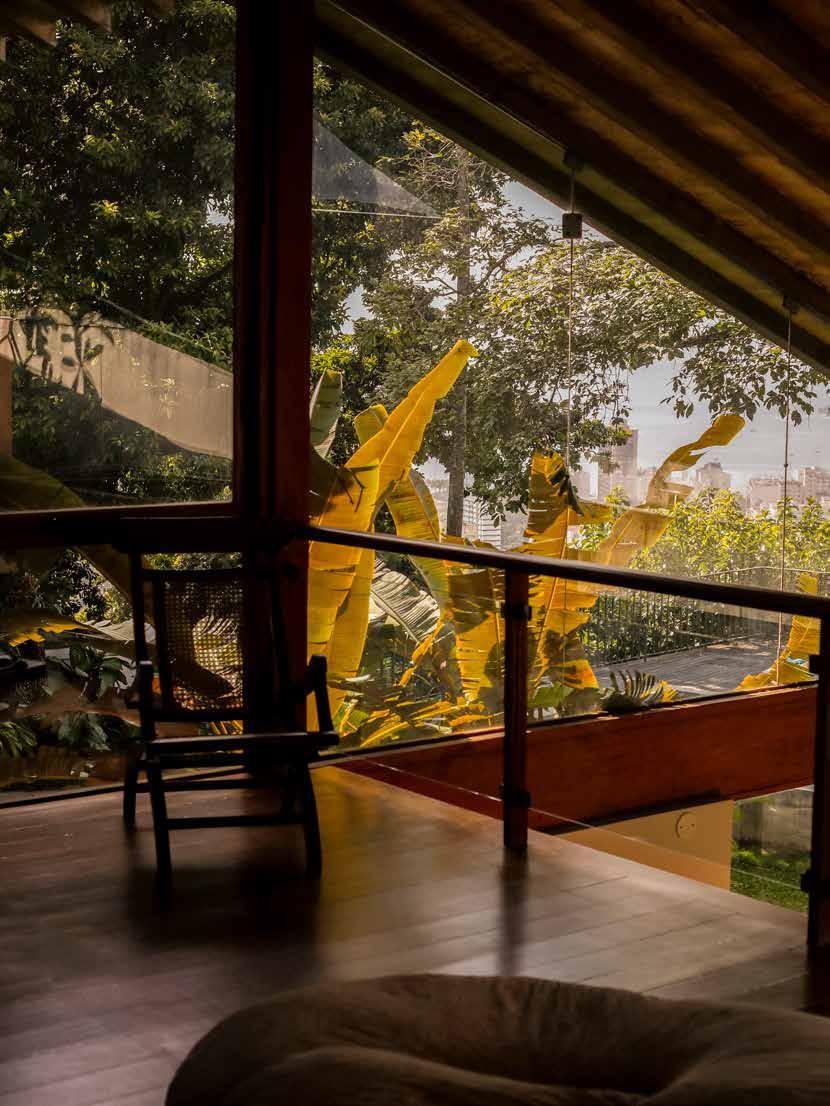
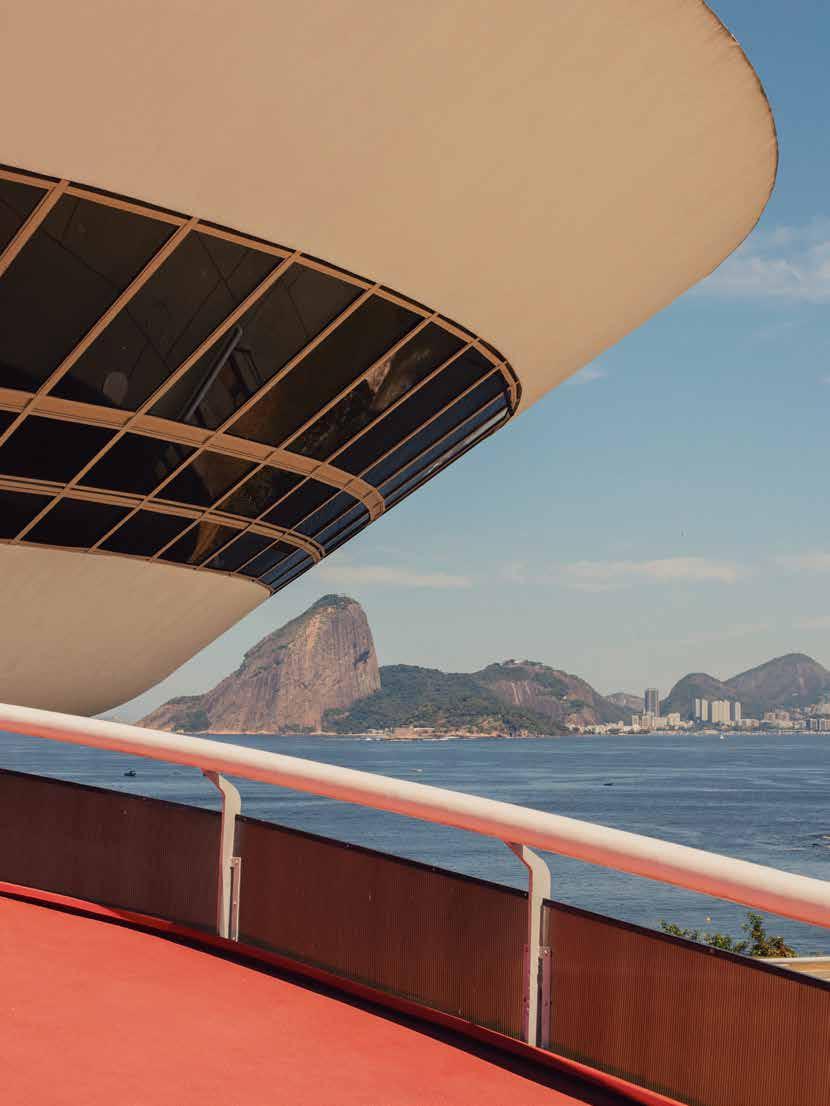

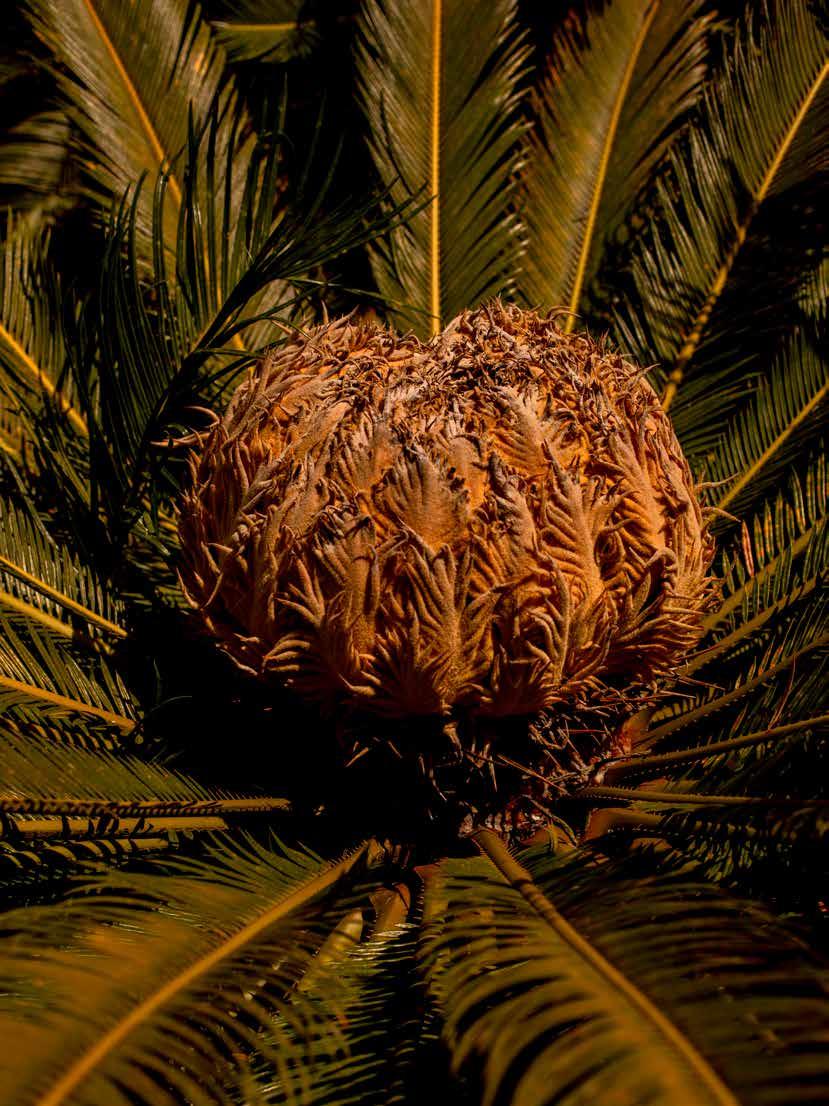
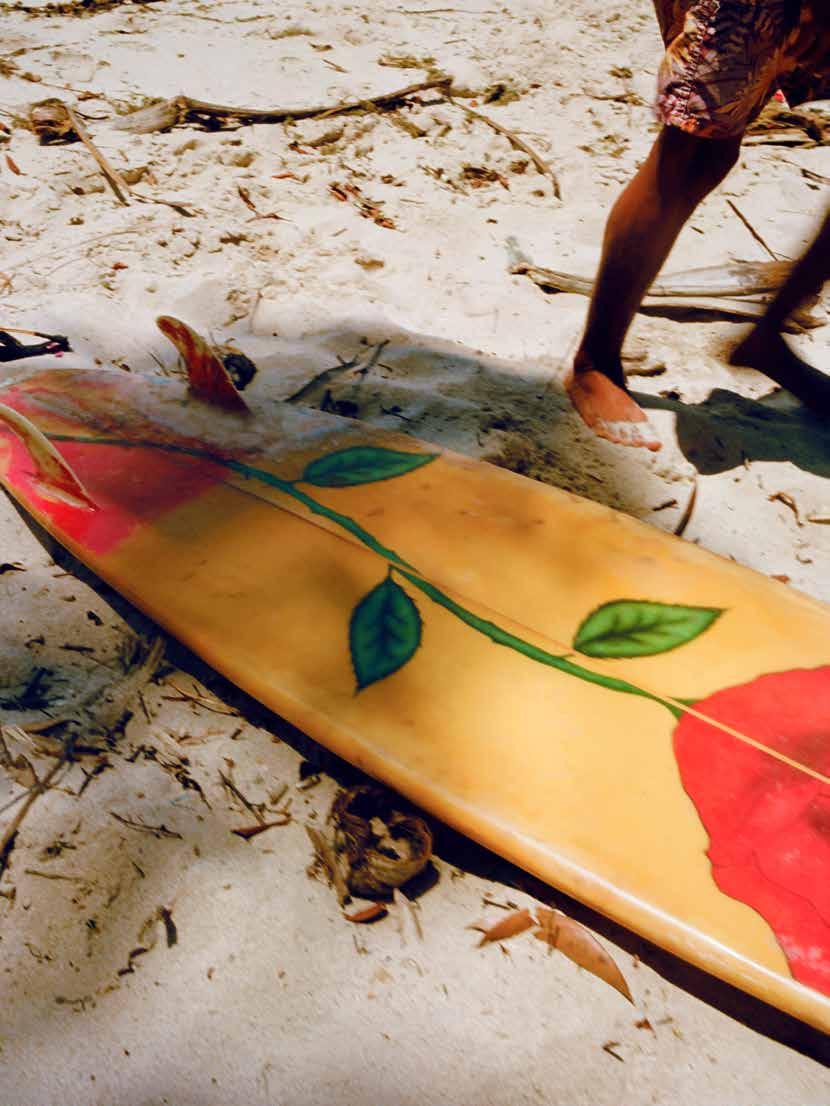
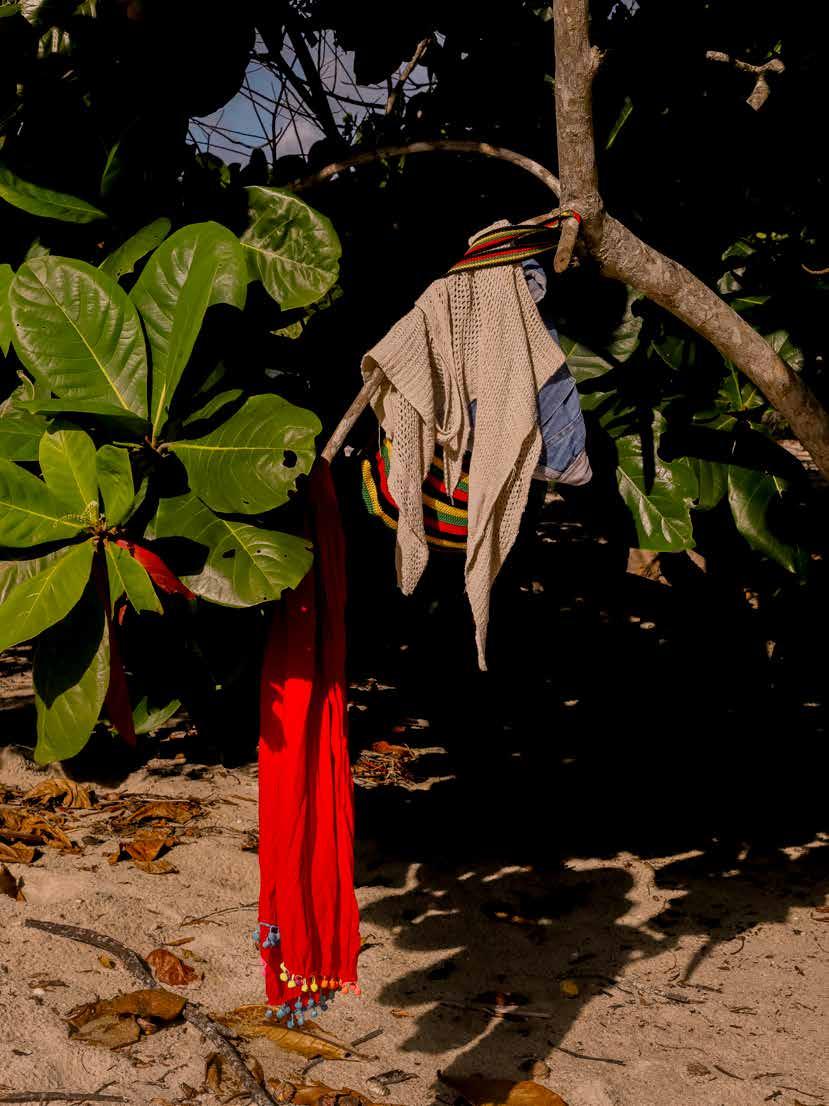
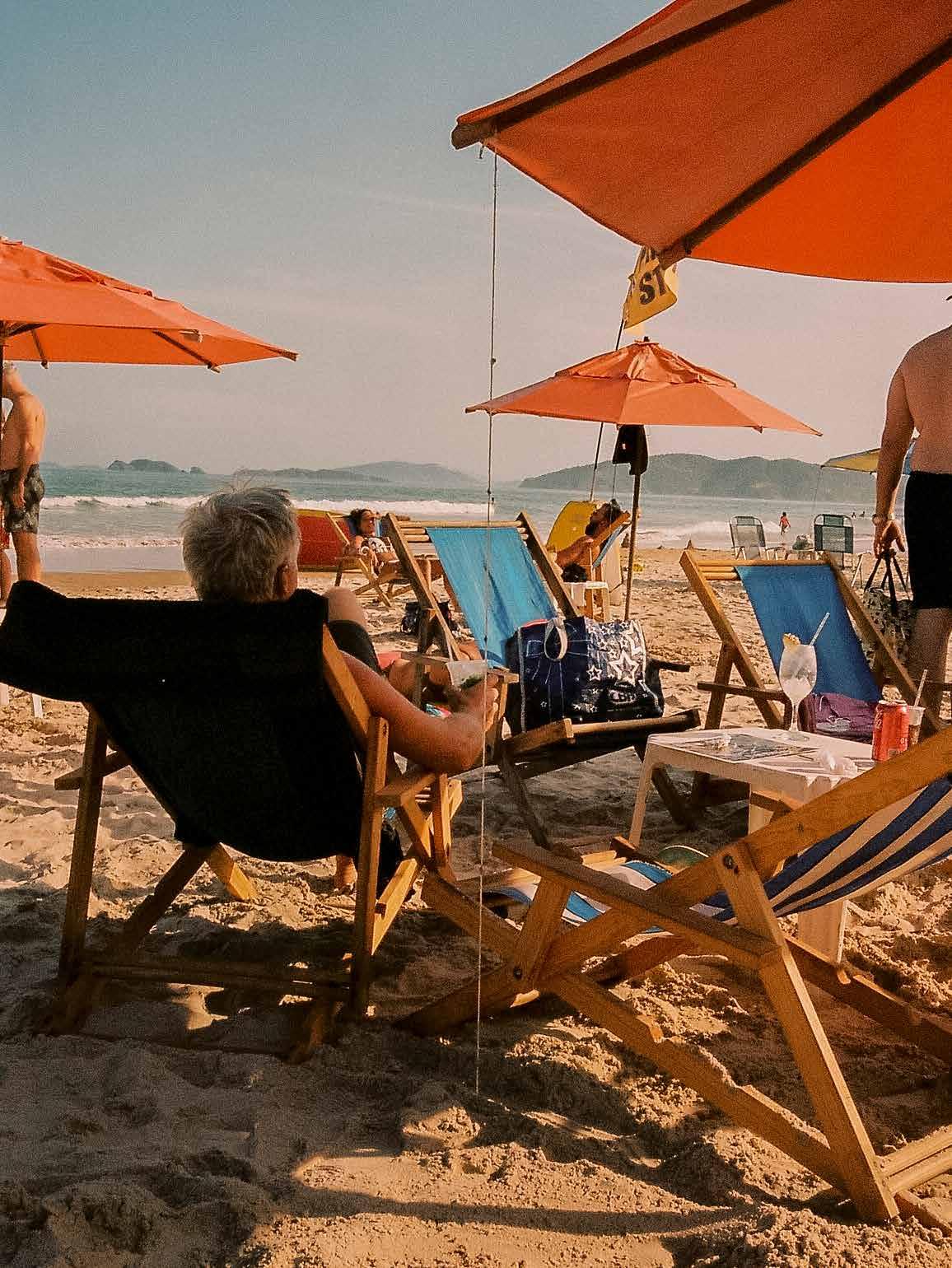

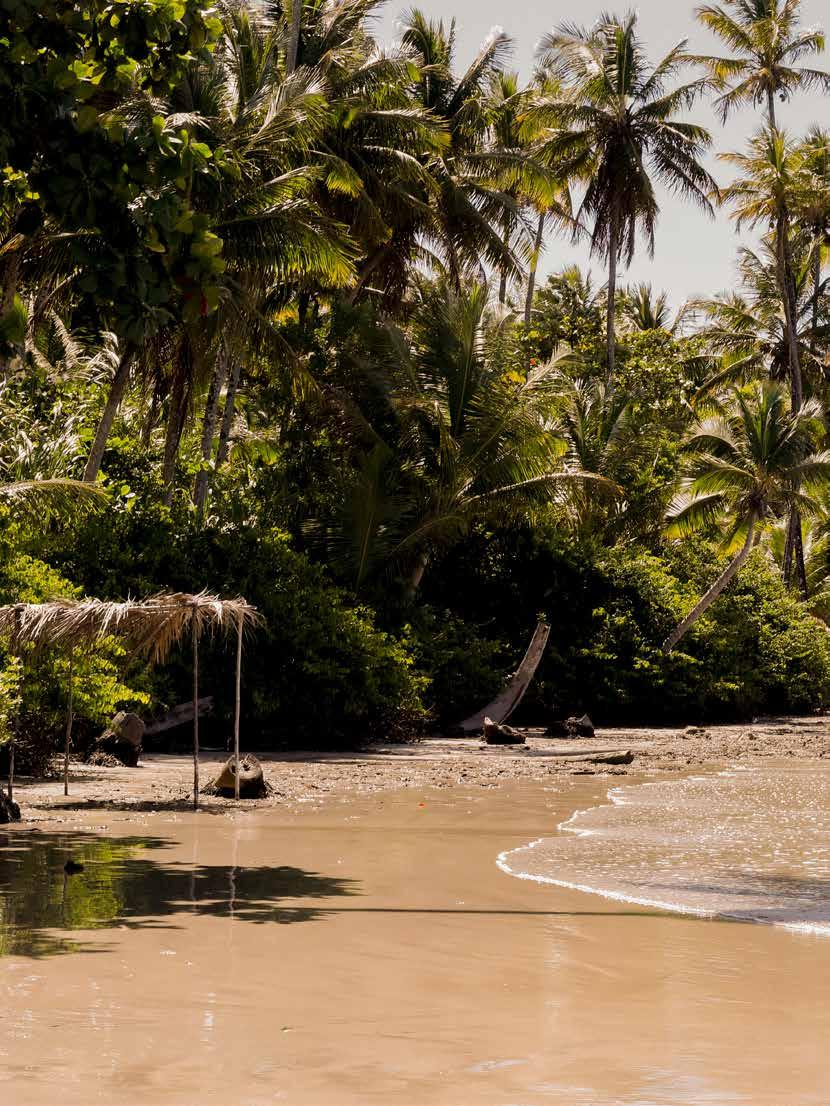




The first trip Original Travel ever booked was a dog-sledding and Northern Lights adventure in Swedish Lapland. 20 years on, the experience is every bit as magical.
words by ROSE VAN CUTSEM trip by ORIGINAL TRAVEL

Philip Pullman and David Attenborough have a lot to answer for. I thought I’d satisfied my children’s obsession with Pullman’s Northern Lights trilogy by taking them to see the theatre adaptation in London, bank balance suitably dented. But no, back home and in front of the telly they discovered David Attenborough’s Frozen Planet, his description of the Aurora Borealis as enticing as dust itself. And that is how this particular trip of a lifetime came about. As Tom Cruise in Top Gun Maverick says, ‘don’t think, just do.’
We teamed up with another family and chose February half term (my son’s 13th birthday falling auspiciously on our arrival day), picking Sweden as somewhere renowned for decent odds of a Northern Lights sighting. This being a natural phenomenon, there’s never a guarantee you’ll see the lights, or so everyone who’d been and not seen lamented. Bearing that in mind, we made sure our five days would be packed with other Nordic adventures worth selling a limb for. Snow and ice and huskies and snowmobiles were a few of the experiences that we added to the basket. Time to start rootling around in the ski clobber cupboard.
Until recently you had to fly to Swedish Lapland via Stockholm, either in one easy connection, or city prowling for a day or two and then taking an overnight train north to Swedish Lapland – an adventure in itself. Now, for the first time, there are direct flights from London to Lulea, one of two gateway cities in the Lapland along with Kiruna. We arrived into the (even more) northerly city of Kiruna with four children aged between 9 and 14. The town of Kiruna is textbook Pullman, belching black smoke billowing up from the vast steel factories smudging an otherwise snowy and sparsely populated landscape. The mining operations here are so important to the Swedish economy that the entire town’s population is in the process of being moved, houses and all. It is the largest underground iron ore mine in the world and the reason the Germans invaded a then neutral Sweden in WWII, securing the Nazis a supply of weapons-grade steel for the rest of the war. While the children scanned the ground for Iorek Byrnison, the banished bear prince from Pullman’s Northern Lights, we discussed the murky iron ore history as a perfect backstory for a Scandinavian crime novel, be-
fore being jolted from our mutual reveries by a bumpy landing on snow, followed by a wave of antifreeze, which felt like being in a massive car wash. Welcome to minus 35 degrees; even Wim Hof might shiver.
Luckily the Swedish team on the ground were ready for us – not your average meet and greet. Instead of passport control we were ushered into a changing hut and handed enormous arctic onesies to put over our existing ski gear (which suddenly felt quite flimsy), our Sorel boots were replaced by their pro snow boots and our gloves by massive snow mitts, plus three balaclavas each because once your breath makes one moist you’re in danger of getting a frostbitten mouth, which none of us fancied. Thus kitted out we were bundled outside and introduced to our first tour guides – a pack of huskies harnessed up to reindeer skin covered sledges and chomping at the bit to get going. After some extremely joyous husky hugging (children’s new sport) we jumped on – four on each sledge with a husky ‘musher’ standing behind us urging the dogs on with commands that sounded more like R2D2 breeps than any actual language.
We plunged into Narnia-esque forests as the sky darkened, our destination: the Ice Hotel, arguably Swedish Lapland’s most touristic landmark but one we had to see. Aside from the ‘breeps’ and ‘haws’ steering the dogs, the sledge’s journey through the snow was silent and soothing. As we left the forest and started racing across a frozen lake, our guides let the children take turns to ‘mush’, which involves standing on the back of the sledge, feet wide apart, and letting the dogs do their well-rehearsed speed trot, only using the slowing down brake, a kind of flat lever attached to the back, when needed – which of course we didn’t ever use, the children’s ‘faster fasters’ belting out into the night. And oh, what a feeling mushing at speed at nightfall in Swedish Lapland is – not much measures up.
We arrived at the Ice Hotel after an hour. Each year it is rebuilt using huge bricks of ice mined the year before from the neighbouring river and stored in freezing warehouses. The concept is part art gallery and part hotel, each room themed and maintained at minus ten degrees with reindeer skin covering huge blocks of ice –the bed – surrounded by ice sculptures. The rooms are open to tourists from 10am-6pm each day so it really is

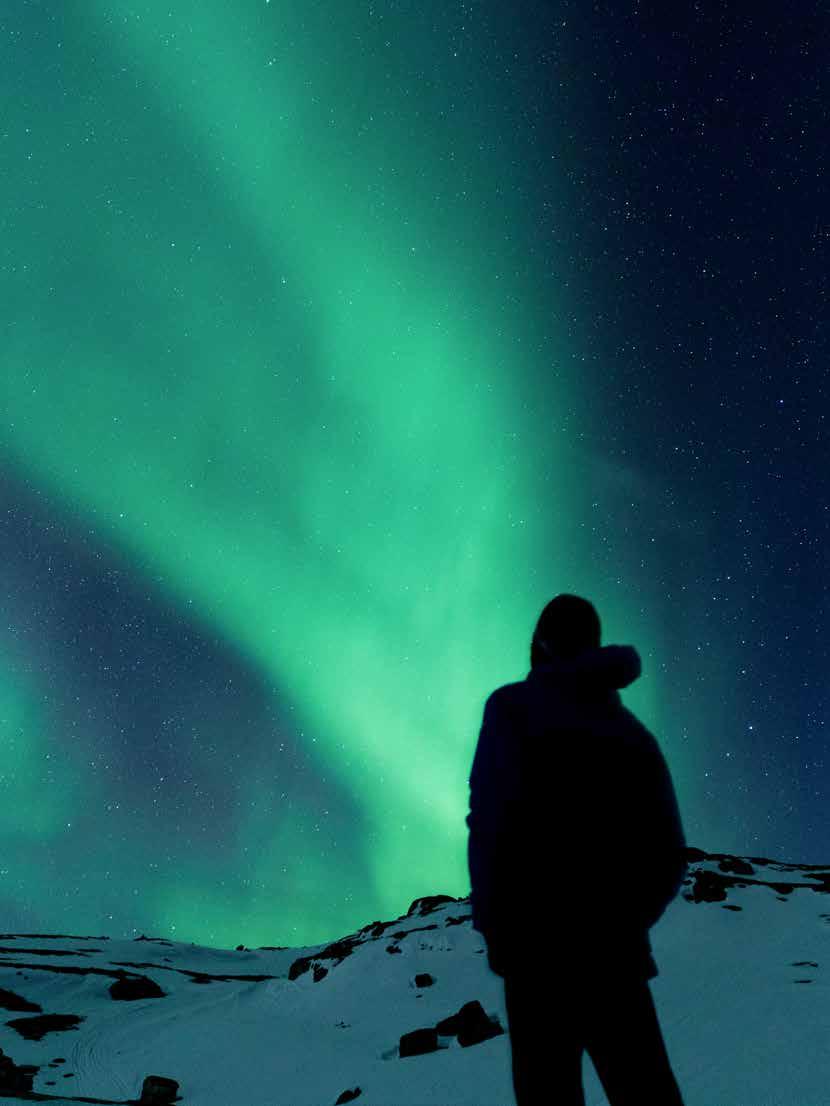
‘We skidded to a halt on a frozen lake. There – above us, around us – they were: the green glow of Aurora Borealis.’
like sleeping in a museum. Suffice to say our party displayed various degrees of hardiness – four ended up sleeping in the ice rooms, two on the heated bathroom floor on roll out mats, and two in the back up ‘warm rooms’. I won’t name names.
Back to our arrival. Usually at this point of a holiday, after a long day’s travel, one would have a drink, unpack, maybe some supper and an early night. Not this time. A bit like Vegas where there are no clocks to stop you from, well, stopping, if there’s a chance of seeing the phenomenon that is the Northern Lights you don’t waste time with fine dining and snoozing. The rumour mill was abuzz in the hotel lobby, the sky was cloudless (essential) so we had to head off immediately for the Northern Lights chase. This time our transport was on snowmobiles – adults driving with children strapped to our backs, minus 38 degrees outside at 8pm. We whizzed along forest paths ducking branches and slowing for the occasional moose, with our guides stopping regularly to check our faces for frostbite. As the children’s hungry grumbling started, we skidded to a halt on a frozen lake. And there –above us, around us, within us (hungry hallucinations are a thing, it turns out) – they were: the green glow of Aurora Borealis. A stream of particles in a solar wind blasted from the sun, 93 million miles away, hitting the outer atmosphere of Earth and colliding with charged particles, before cascading towards the planet’s magnetic field lines, then pulled towards the North Pole and into our vision. It really was extraordinary, eerily glowing drifting particles, alien green through a camera lens. We ‘ooh-ed’ and ‘aah-ed’ (sorry fireworks, you’re dumped) and then, just like that they, faded. My philosophical musings about nothing lasting forever were interrupted by the return of hungry tummies and the promise of supper around the corner.
If you’d told my son that on his 13th birthday he would be eating reindeer stew in a Nordic cabin after an almost Shackletonian journey across frozen lakes, he would
have rolled his eyes. Yet there we found ourselves, roaring fire, big pot of tjälknöl (slow-roasted reindeer) being ladled into wooden bowls, served up with warm cloudberry juice. On a normal day my children would not eat a) reindeer b) in a mushroom sauce c) served alongside cloudberry juice (which, incidentally, tasted not unlike the vitamin syrup Sambucol), but after an epic and bone-freezing journey, we all agreed that nothing had ever tasted so good.
We conked out in our various places at around midnight. The Ice Hotel ‘experience’ reminded me of Legoland - we were glad to have done it, and the children loved it, but one night was enough. We headed off the next morning thrilled to have ticked the Northern Light’s box in time for lunch with a Sámi family en route to our next destination, the Lulea archipelago, some four hours south and back below the Arctic Circle.
The Sámis are indigenous people, making up less than 1% of the population, but living nomadically in laavu tents (imagine a yurt and teepee’s love child) in Lapland, which covers 35% of Sweden. We were hosted by Anna in the Sámi capital, Jokkmokk. She sang a joik – one of the oldest of all forms of folk music and dedicated to nature; the children were completely mesmerised. We fed the reindeers and learned about the markings cut into their ears, all identical to show they belong to Anna. She explained that each herder is given their own symbol and knife from their parents when they are old enough to have their own herd. Lunch was reindeer stew again, which – to be fair – the Sámis invented, and we listened to stories of Sámi culture, how the government are pressuring them to sell their sacred lands and how they pass on their heritage verbally, through song and story. No iPads in this laavu (and, miraculously, devices were hardly mentioned all holiday). It was a mystical and integral part of our adventure, and not gimmicky at all, unlike some of these experiences. It was also good to pause for a minute and think beyond the lights and snow pursuits to learn about a whole people we’d hitherto barely heard of.
‘As we raced across a frozen lake the children took turns to ‘mush’ the huskies, cries of “faster, faster” belting out into the night.’





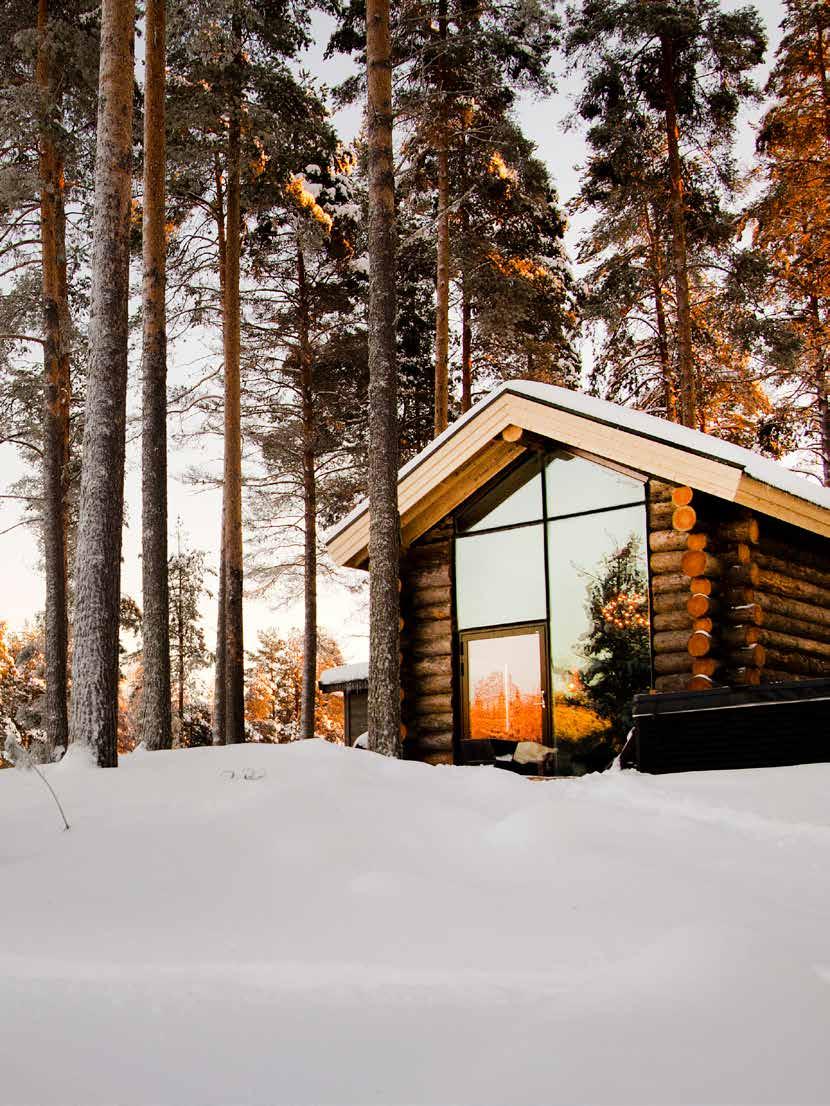
That said, our next three days were non-stop action fantasy stuff. Our base was an extremely comfortable log cabin lodge with roaring wood burners and outdoor hot tubs set on the edge of a frozen lake – the perfect setting for the children to have a bit of independence (ie: their own cabins) and for us to come back to after each day’s adventure, perhaps having dreamed up a few more lines of a crime novel.
From here we did another husky tour – where we paired off with six dogs per sledge, with one adult or child driving or mushing while, the other snuggled into the fur-lined basket used to carry people or goods. We learned how to harness the dogs, their names, what and when to feed them (frozen burger shaped chunks of raw meat), with the children squealing with delight at the notion of the dogs ‘doing their business’ as they ran, then howling in revulsion as they actually did their business. Stopping for a snowy picnic was another highlight – the hosts digging a circle, laying reindeer skins for us to sit on, getting a fire going and warming cheese toasties and soup on it in a well-practised flurry – they sometimes go for weeklong tours and are experts at camping in the wild.
The next day was all about snowmobile touring around the Lulea archipelago – I’m going to stop saying highlight because every day blew the one before out of the water. We chased each other across vast frozen lakes at speed (more squeals), snowshoed through a forest, ate burgers over a rustic grill on a mountain top and marvelled at the complete emptiness of it all, our only companions the occasional moose (huge!) and high-flying black grouse which are almost extinct elsewhere in Europe. We only ever heard, but didn’t glimpse, the elusive capercaillie bird – as big as a turkey but painfully shy. On the way home, we went ice
fishing with tiny rods. The fisherman explained how he drills holes in the ice before you plop a bright orange ‘lure’ line in and jig it about. He equipped us each with a scoop to stop the hole freezing over and explained we would have to be patient. Three minutes later, my daughter hoiked out our supper – an Arctic char. Three hours after that we were eating it, expertly filleted into melt in your mouth sashimi. Our (extremely handsome) Nordic chef was – it turns out – also one of Sweden’s most famous pike and salmon fishermen, so good that a previous lodge guest flew him to Holland shortly after we left to go pike fishing together.
The evenings were spent having massages, sitting in saunas, playing card games and setting each other quizzes before delicious three-course suppers. We did a moonlit snowshoe walk one evening and rode bicycles with big fat tyres by day. The dads and kids went back for another day’s husky mushing while my friend and I chose to do a three-hour hike across the frozen landscape, spying into locked up lakeside summer cabins and stopping with a flask of coffee to watch a lone fisherman on the ice. We saw more extraordinary Aurora Borealis one night, this time from the warmth of our cabin.
It was over all too soon. We all agreed a winter holed up in ‘our’ forest would suit us very well, despite my ten-year old declaring the week only a 9/10 because the snow was too cold to make snowballs from. There’s no pleasing some people. •
Contact one of our Sweden specialists: +44 (0) 20 7801 1750
‘Anna, our Sámi guide, sang a joik –one of the oldest of all forms of folk music and dedicated to nature; the children were completely mesmerised.’
We launched Original Travel with a handful of destinations, but Sweden was on that original list. The country remains a firm favourite thanks to its sophisticated cities, opportunities for adventure in both winter and summer, excellent cuisine and beautifully diverse landscapes. There’s no-one better to arrange your trip to this super-civilised destination.
Our Sweden Concierge is Parisian-born Eljah, who moved to Sweden with her family aged eight and who remains smitten with Sweden’s culture of tolerance and the omnipresence of nature, even in the heart of Swedish cities. She should be your first port of call to arrange everything from an impromptu kayak trip around Stockholm’s archipelago or to the best table in Gothenburg’s hippest new restaurant.
Fast Facts
• Size: 173,860 square miles
• Capital: Stockholm
• Population: 10,235,000 (Aug ‘22)
• Density: 64 people/square mile
• Pick a Number: 20,000. The number of Sami people living in Sweden, of a total population of 80,000 across Norwegian and Finnish Lapland and Russia.
• When to Go: Stockholm all year round, Gothenburg and the West Coast in summer and Swedish Lapland from January to April for Arctic adventures.

One point of contact Contact one of our Sweden specialists on + 44 (0) 20 7801 1750
Gothenburg is emerging from Stockholm’s shadow as a second city with a distinct character, great places to stay and fun nightlife Explore by bike or boat before picking up your car for a West Coast road trip.

The coast of Bohuslan, stretching up to the Norwegian border, is dotted with 8,000 islands Explore them on a guided kayak trip, sample delicious shellfish on a seafood safari and stay in a floating hotel.

Stay in the pretty clapboard port of Fjallbacka in the Koster Islands. Take a boat trip around the wild and woolly Weather Islands, go for long walks along lovely trails and top up on even more sumptuous seafood.

The Ice Princess (2010) by Camilla Läckberg, is a murder mystery set in the author’s own hometown of Fjallbacka in Bohuslan. First of the popular Patrik Hedstrom series.
The Seventh Seal (1957); Director Ingmar Bergman’s magnum opus about a Crusader knight’s game of chess with Death.
Anything by ABBA , one of the world’s greatest ever pop acts and creators of deceptively complex melodies and arrangements, all sung in a foreign language.

Treehotel: Stay in a treehouse room designed like a UFO or bird’s nest in the heart of Swedish Lapland.
Den Gyldene Freden: Venerable 18th century restaurant in Stockholm owned by the Swedish Academy, who decide Nobel prizes.
West Coast Seafood Safaris: Depending on the time of year, join local Bohuslan fishermen to haul in mussels, oysters, crayfish, langoustines or lobster, before enjoying the freshest feast imaginable.
The Stockholm Archipelago is made up of 24,000 islands, of which only 150 are inhabited year-round. Discover this incredible region from the water on a private guided kayak trip including picnic lunch in splendid isolation on a beautiful island.
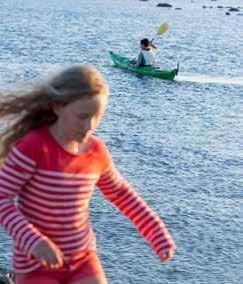
Dalarna is a region north-west of Stockholm swathed in forest and lakes and home to large numbers of majestic moose that you can spot - hopefully at close range - on a half-day guided walking tour.
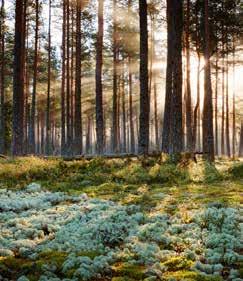

Hovercraft Adventures: The sea off Lulea, in Swedish Lapland, freezes in winter, making it the perfect place to enjoy a high-speed hovercraft trip across what is a surprisingly bumpy surface as the ice packs up.
Day 1 Day 2 Day 3
Sweden’s capital is a gem for a wintry weekend, but here we’re proposing a summer trip. Arrive and settle into the seductive pace of life in this beautiful city, exploring the cobbled streets of Gamla Stan (the Old Town) before supper in a Concierge recommended restaurant.
Explore the lovely city centre island of Djurgården on a guided bike tour through parkland and with a visit to the wondrous Vasa Museum, home of the eponymous and almost perfectly preserved 17th century warship.
Learn about the fascinating history of Sweden's royal family on a guided walking tour through the historic city centre, hearing about the rituals and traditions associated with the Swedish monarchy and visiting the royal palace.


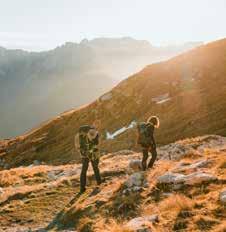



the
walk this way
Walking is the original travel; the method by which homo sapiens came to (for better or worse) colonise the planet.
Walking is as easy as, well, putting one foot in front of the other, but when you settle into a rhythm, walking can transcend mere movement from A to B. As the brain allocates just enough focus to ensure you successfully land the next step, the repetitive nature of the process can then bring on a contemplative, almost meditative, state.
Of course, every dog owner experiences this in microcosm on their daily walks, but with the mundanities of everyday life (emails to answer, to-do lists to tick off) crowding in, it’s nigh on impossible to experience true clarity. Throw in the sense of awe and adventure that walking in an unfamiliar and beautiful location allows, and the experience is of a different order entirely.
And while a destination might be thrillingly unfamiliar, walking its trails instantly connects you to a place because a path is, by definition, the constantly evolving creation of those who walk it. That means the people before you, but others too, because many trails predate the arrival of humans. When we walk, we are sometimes following trails tens of thousands of years old and perhaps created by the migration of animals long since extinct, but who once divined the safest pass through a range of mountains, or the best place to ford a river. You are literally following in their footsteps, maintaining the path as you go. It’s a profound connection.
Here we introduce eight of our favourite walking regions. They represent a rich blend of summit ascents, pilgrimage trails and migratory routes to wander along and wonder at.
words by TOM BARBER GREECE
GREECE
The siren song of the Greek islands is strong, but the country’s hinterland has treasures every bit as beguiling. A case in point is the northern region of Zagori, a wild and mountainous place home to a collection of picture-perfect villages and rivers crossed by elegantly arched 18th century stone bridges. The entire region is crisscrossed with centuries-old trails used by shepherds and their flocks, but the most famous walk by far is that through Vikos Gorge. The walk through the gorge, the world's deepest relative to its width (thank you Guinness Book of Records), is moderately challenging but one top tip is to do it from south to north, rather than the more popular reverse, because that means the most strenuous section up/down the gorge rim is at the beginning. Once in the gorge itself, you walk in the shade of beech, juniper and oak trees alongside the Voidomatis River, and the entire walk should take around five or six hours, after which you can relax and enjoy a massage in your lovely hotel nearby. This being Greece, there are plenty of fascinating cultural curiosities close at hand, including the oracle site of Dodona, second only in importance to Delphi in Ancient Greece.
 NORTHERN VIETNAM
NORTHERN VIETNAM
The mountainous region of Sapa is emerging as a popular trekking destination, but even more remote is gorgeous Ha Giang, which also borders China’s Yunnan province. One obvious draw is the Dong Van Karst Plateau Geopark, characterised by perfectly conical limestone peaks covered in dense forest and home to the vanishingly rare Tonkin snub-nosed monkey. There are several trails worth exploring here, but elsewhere in Ha Giang you’ll also find arguably the most beautiful examples of rice paddy terraces in Vietnam, and villages home to some of the region’s colourfully dressed hill tribes. Stay in an admirable new lodge co-owned with the local Dzao ethnic community and spend your days walking from village to village past rice paddies and bamboo forests with a local guide, and learning about Dzao life from farming to music-making in this remarkable and unspoilt area.
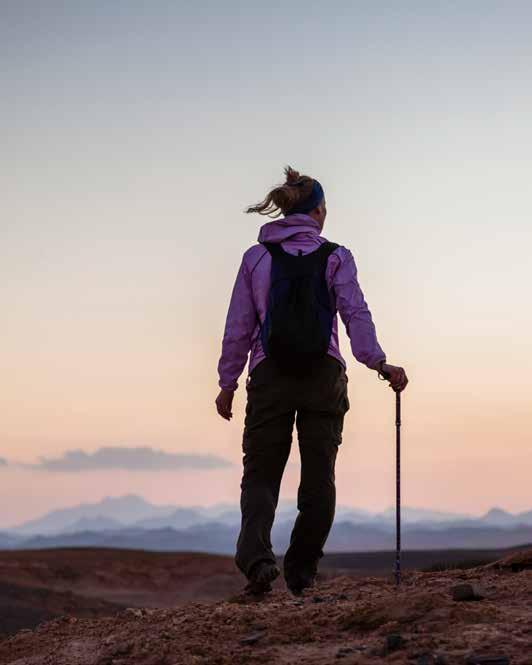 MOROCCO
MOROCCO
After the mayhem of Marrakech, the wide-open spaces and sheer emptiness of the nearby Atlas Mountains are the perfect antidote. The rocky landscape that dominates here might not have the obvious allure of other luxuriantly lush contenders in this list, but there’s a stark, lunar beauty to the steep, interlocking valleys. Walking with a local guide and accompanied by a donkey carrying your kit and provisions, you can stop to drink from a fast-flowing stream and have lunch in the shade of a stand of walnut trees, while learning about Berber culture in the traditional villages clinging to the valley sides. For a proper challenge, the ascent of 13,671ft Jebel Toubkal is a non-technical climb that requires an overnight stay in a basic but comfortable refuge on route. We can arrange for local porters for anyone wanting to turn this into a full-blown operation, and on arrival at the summit, the views of the Atlas Mountains are suitably rewarding. Then spend a few nights relaxing at one of the excellent lodges in the foothills, regaling anyone who will listen as to how you just bagged North Africa's highest peak.
The Inca Trail to Machu Picchu might be the most famous trekking route in the Americas, but as a result it can be crowded. It’s also not for everyone as the lack of hotels along the route means it’s a case of camping. The good news for walkers who like their creature comforts is that there is an alternative route into Machu – the Salkantay Trek. Taking seven days in total (including acclimatisation walks), and staying in very comfortable lodges and hotels en route, this is a special – if occasionally challenging – way to experience the Sacred Valley and Andean culture. Highlights include the walk up through cloud forests to the Llactapata Pass, rewarded with a view of Machu Picchu in the distance that few ever get to see, and experiencing a traditional Pachamanca lunch, a Peruvian meal cooked over hot stones in an underground oven. And then there’s Machu Picchu itself, which is well worth the walk. If you’re feeling up to it, we can also arrange a further walk to Huayna Picchu, the peak that so often acts as the backdrop to photos, and which offers yet another perspective on the site. Then retire to another lovely lodge for a well-earned jacuzzi and dinner before bed under a goose-down duvet. And sleep.


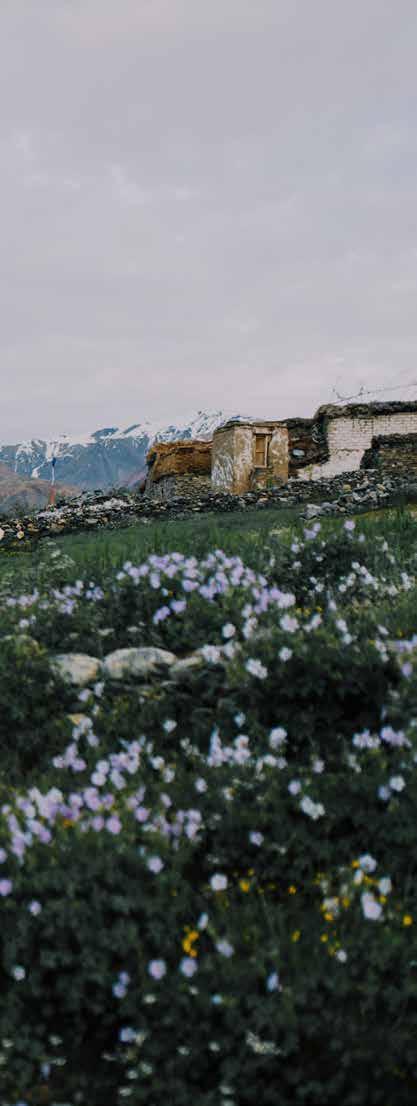 BHUTAN
BHUTAN
From the time that the state of Bhutan coalesced in the 17th century until the 1960s, message-carrying trail runners (or garps) and pilgrims would process along the Trans Bhutan Trail from dzong (fortress) to dzong. Then, the construction of a national highway saw the trail fall into disrepair before a true covid good news story. During lockdown, the King of Bhutan gave his consent for the trail to be restored to its former glory. Three years, 18 bridges, 1,000 workers and 10,000 new steps later, the trail has finally reopened, spanning 250 miles from east to west across the country. The full trail might be a step too far (it takes 36 days), but there are several bite-sized chunks that traverse Bhutan’s staggeringly beautiful landscapes and take in classic cultural destinations such as Paro, Thimpu, Punakha and Gangtey, each of which also has wonderful accommodations. En route, you’ll learn about the country’s fascinating history, reverence for the monarchy and strict adherence to Tibetan Buddhism, and be able to try your hand at the national sport – archery. Above all, though, in this kingdom above the clouds, you will come to love one of the friendliest peoples on Earth.
An island off an island off an (admittedly continent-sized) island, Maria Island is home to one of the designated Great Walks of Australia, and with very good reason. The entire island has been a national park since 1972, and to this day the only two permanent inhabitants are a pair of park rangers responsible for monitoring Maria Island’s non-human natives; these include wombats and Tasmanian devils, wallabies and kangaroos, and 125 bird species including the wonderfully named forty-spotted pardalote. The walk takes four days and covers 26 miles in total across a wide range of habitats from beautiful beaches (keep an eye out for breaching dolphins) and ancient blue gum and cloud forests to 2,200ft peaks and along fossil-filled cliffs. Each night you stay in hi-spec safari-style wilderness camps before a final night in the elegantly restored Bernacchi House, dating back to 1880. As for sustenance, Tasmania’s culinary excellence is on show throughout, with walkers treated to three-course dinners each evening using local produce and accompanied by award-winning Tasmanian wines. Whatever the hiking equivalent of glamping is, this is it.

 ZAMBIA
ZAMBIA
Seeing Africa’s animals in their natural habitat remains one of the great travel experiences, and a walking safari remains its truest form. You will almost certainly see less game than on a 4x4 vehicle safari, but you will hear, smell and notice much more. Even better, there is really only one place to choose: the South Luangwa in Zambia, home of the walking safari and still the best place to experience it. Whether on guided day walks from characterful camps, or extended trips where you set up fly camps en route each evening, exploring the forested floodplains surrounding the Luangwa River - one of the most intact major river systems in Africa - on foot allows you to truly connect with this beautiful landscape. Your expert guide will be reading the landscape at all times for clues, and it becomes a genuinely sensory experience as you learn to spot spoor (evidence of animal activity, such as a fresh dung), listen out for alarm calls that signal the presence of a predator (and which would be drowned out by a 4x4 engine), and smell everything from wild herbs to the unmistakable popcorn odour of a leopard's scent marking.
Due to a historic lack (until recently) of direct flights from the UK, the Mediterranean island of Corsica has been under the radar. We think this should change, and urgently, because the island’s alluring blend of French and Italian cultures (what’s not to like?) and gorgeous landscapes is spectacular. To get technical for a second, the island’s unusual granitic geology also makes for dramatic soaring peaks and picturesque coastal settings that are made for walking. Only the brave and very fit should consider tackling the most famous walking route in Europe – the legendary (and extremely challenging) GR20, which spans the entire length of the island and takes a fortnight – but there are plenty of other well-marked trails that take in genuinely gobsmacking scenery. Two of our favourites are the trail to Lac du Melu and Lac du Capitello, two glacial lakes above the citadel of Corte in Corsica’s mountainous hinterland; and the coast-hugging Sentier des Douaniers trail around the northern tip of Cap Corse, known locally as ‘the real Corsica’. Best of all, a day’s walking means you’ve earned the island’s famously hearty and calorie-filled fare. Win-win.
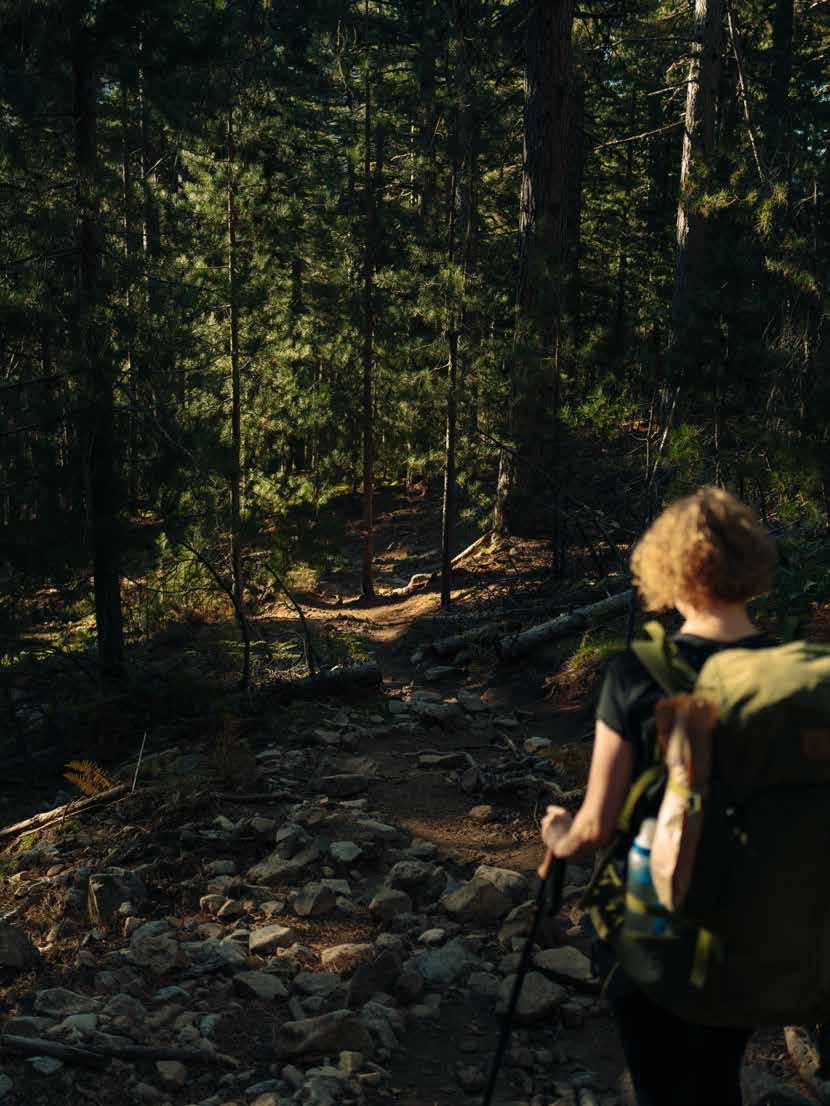 Corsica FRANCE
Corsica FRANCE
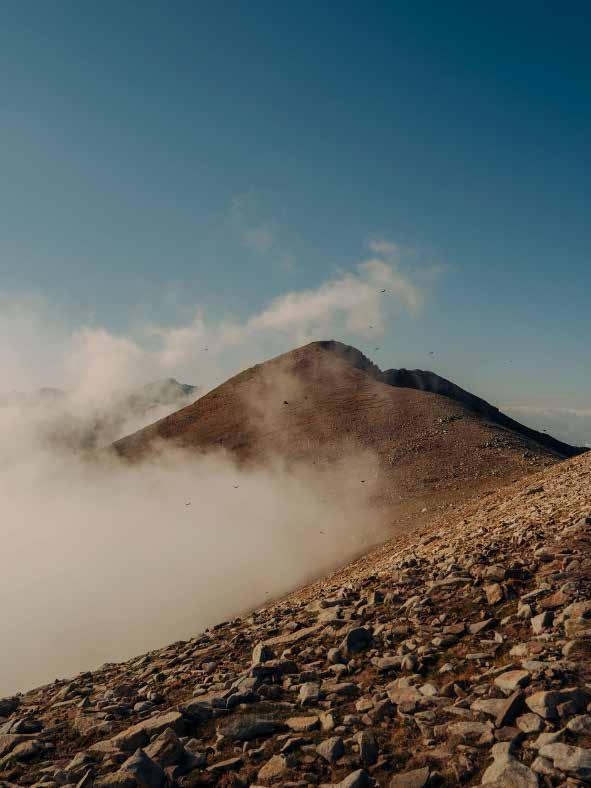

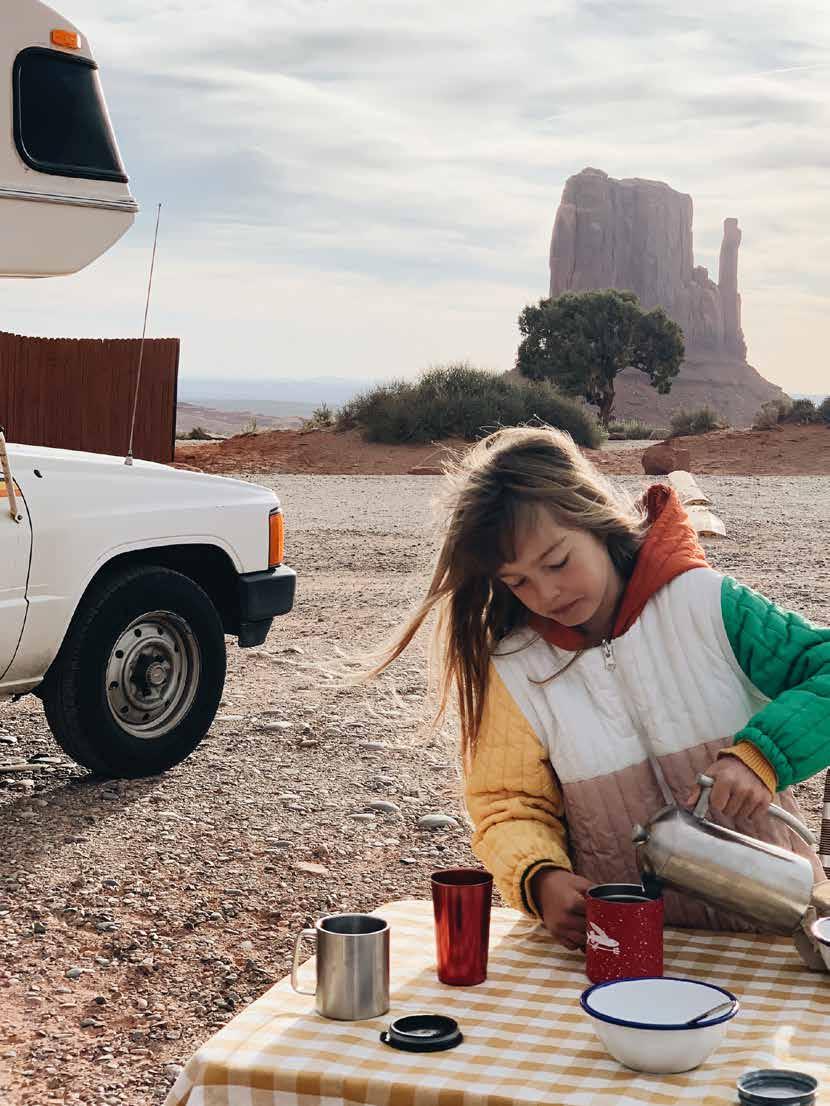
an American road trip
Francisca Kellett and family experienced life on the open road on a recent RV (Recreational Vehicle) trip from Los Angeles to the national parks of the American Southwest.
words by FRANCISCA KELLETT photos (from an entirely separate trip) by BIRGIT SFAT trip by ORIGINAL TRAVEL
Like all the silliest stories, this one begins in Hollywood. Actually, it begins about two miles to the west, in a dusty parking lot near LAX airport. We’re here to collect our RV –or Recreational Vehicle – to hit the road and head out across the American Southwest.
My husband is anxiously circling the RV, peering at the plugs and pipes we’ll be using to empty the ‘black water’ (read: sewage). Our 13-year-old daughter has already wrenched open the door and scrambled inside with her little sister. I’m signing documents from the nice rental guy and wondering how the hell I’m going to manoeuvre this massive beast out of the car park, let alone across LA. But that’s all part of the adventure, right?
Adventure is what we’re here for. Our trip to the States to visit family and friends was long overdue, but the logistics of getting from A (California) to B (New Mexico) got us thinking. Why opt for a boring, carbon-intensive internal flight when we could hit the road, see some national parks, take in America’s famous Southwest landscapes? The kids love camping, I hate unpacking, so an RV seemed the perfect answer: we could take it all wherever we went, kitchen sink and all. A road trip in the truest sense, where the road will become our home and we’ll go where the mood takes us. Freedom and spontaneity, as a family.
What a silly idea.
Because, as all parents know, spontaneity and children aren’t happy bedfellows. Family travel is all about planning, and so we spent the month leading up to our trip was spent online, researching national parks and campsites, sending endless emails to Original Travel, speaking to their excellent team of US-based Concierges, Googling entrance fees and exit points, and finding that ‘hook ups’ had nothing to do with flirtatious encounters and everything to do with crucial RV plumbing.
And there it is, the gleaming kitchen sink, as soon as I climb aboard. This RV, a C25 model, has got everything: a kitchen with a fridge larger than ours at home;
two beds, plus a third that folds up from the table for smaller kids; a little shower room with loo; loads of cupboards for storing everything. It’s super-practical, in that very American way, and super-sized (also very American) – about the size of a removals lorry. No rearview mirror, though. After half an hour of nervously sitting in the driver’s seat, checking how everything works, moving the side mirrors, checking everything again, I pull out of the parking lot to the whoops of the kids, and then it’s a white-knuckle ride on LA’s seven-lane highways, trying to get used to the steering (slow), the heft (considerable), the height (pleasing).
But the roads soon slim down and the traffic calms, as do I, as we trundle through dusty commuter towns and past endless windfarms stretching into the Mojave Desert. And then we’re there, in the wilderness proper, the road empty, just us and the desert stretching to the horizon. We keep stopping that first day, to take in the shimmery white salt pans, the cavernous canyons opening up in the middle of nowhere, to gaze out over Death Valley, a vast, gloomy expanse of dark rock and dust. The sun is lowering in the sky when the road dips down to 282ft below sea level and our first stop: Stovepipe Wells.
Stovepipe is a bizarre collection of Western-movie-style wooden cabins sitting in the midst of all that grey sand and scorched black rock – this is officially the hottest place on earth, and it looks it – with a general store, restaurant and even a swimming pool. The kids go off to explore while my husband gets to grips with the various plugs and pipes in our spot, a neat, gravelly patch between the store and the misty wilderness, and then we head to the restaurant for vast steaks and charming chat from the waiter who seems thrilled by our British accents.
A fierce, dusty wind kicks up at nightfall so we head to bed, making up the big double at the back for the girls and the even bigger double above the driving cabin for us. It's cosy but cold, and we sleep in layers, not quite daring to turn on the heating in case we mess up our electrics. But it’s comfortable enough, even if I hit my head on the RV’s ceiling roughly 32 times that night.

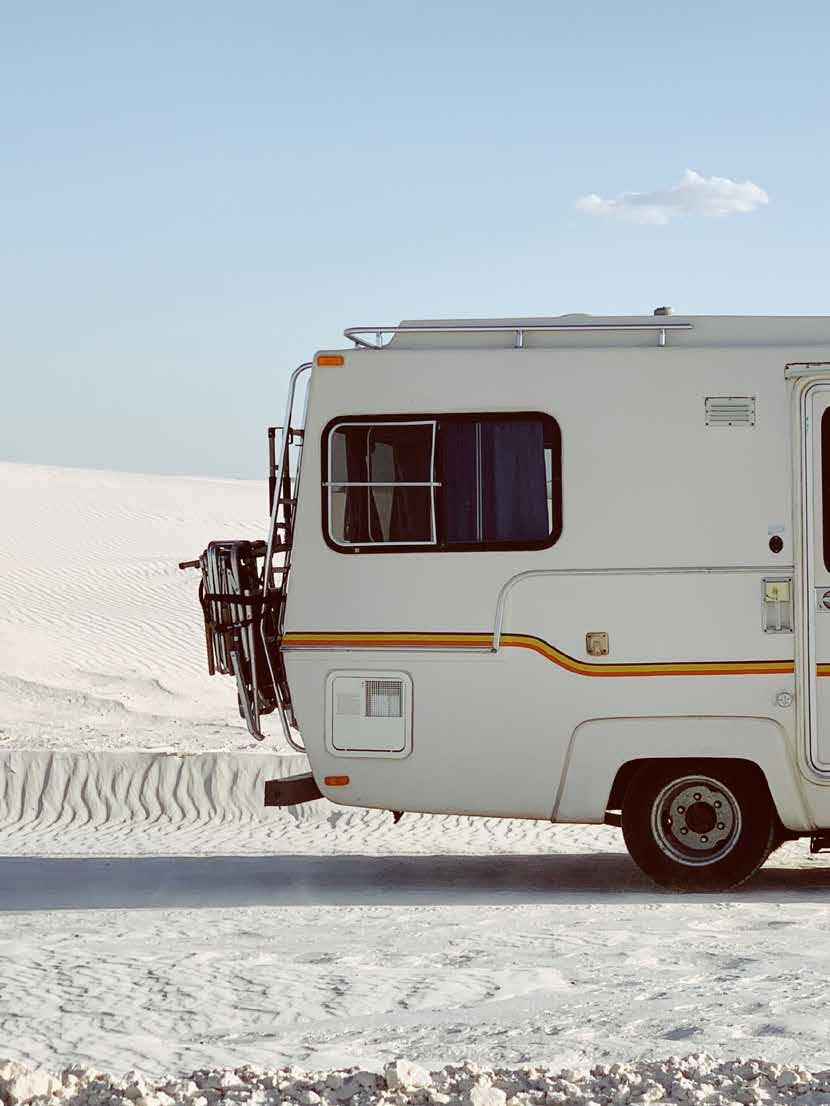

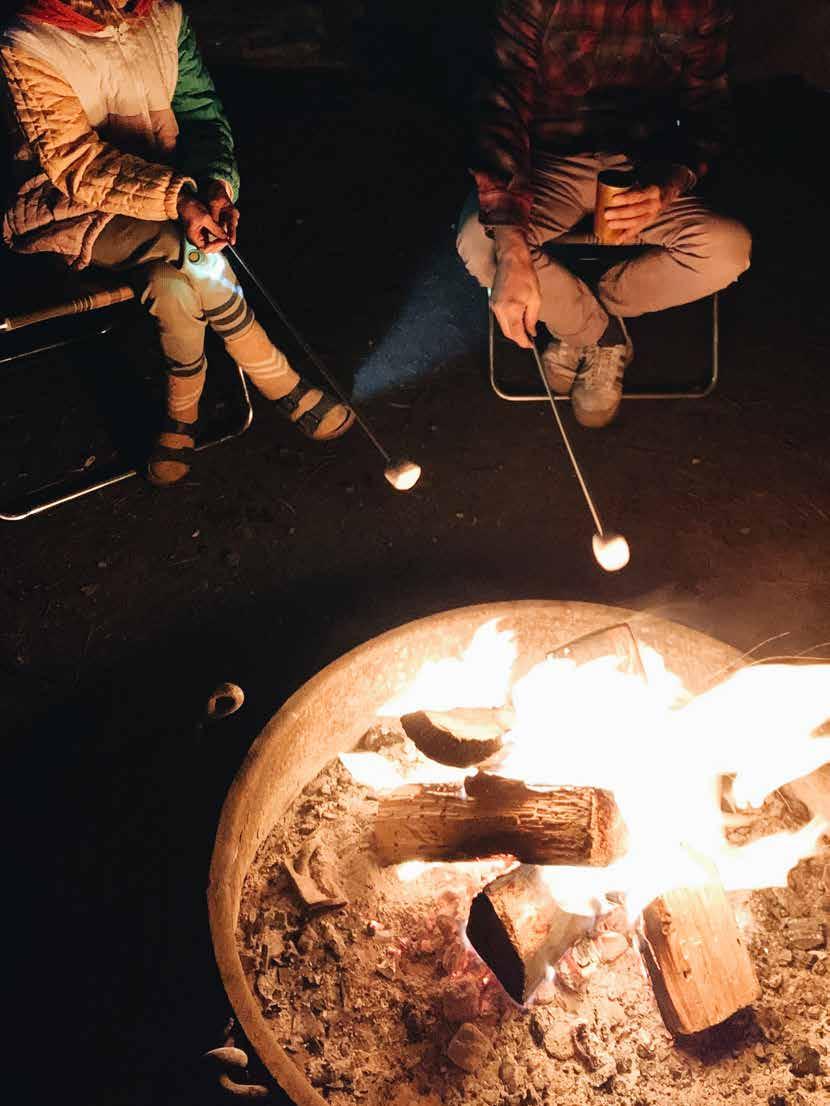
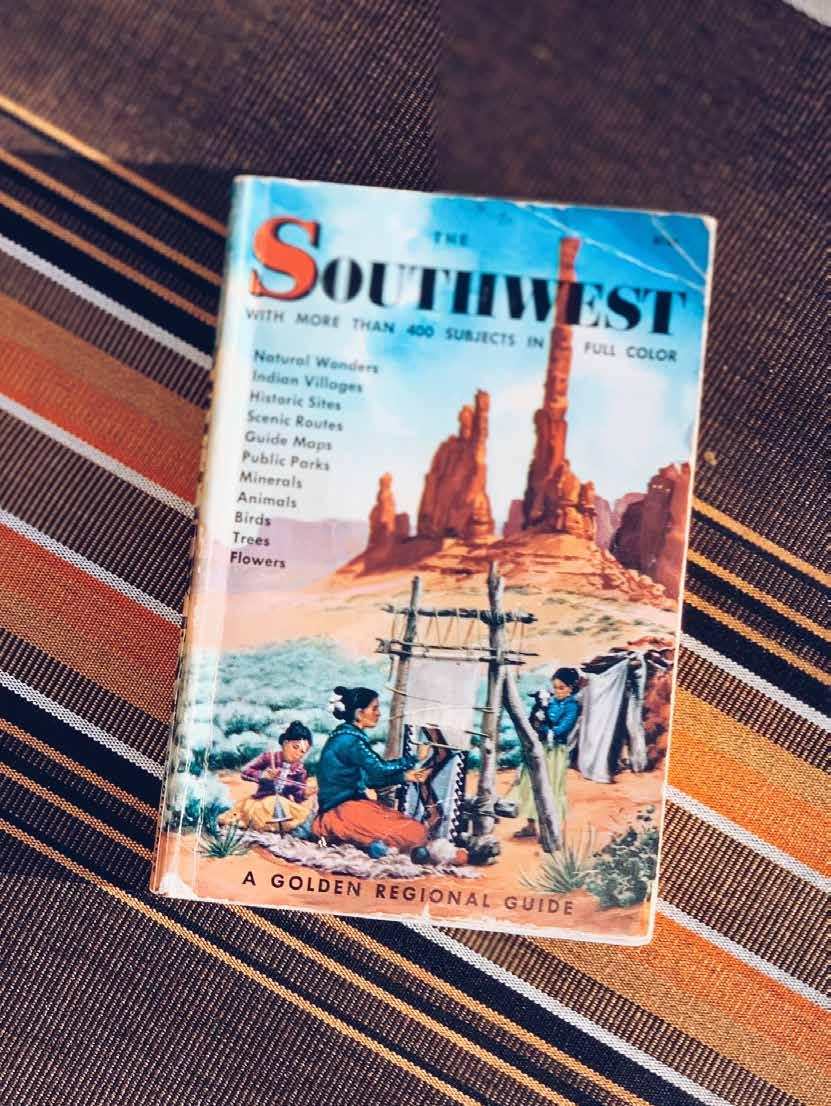


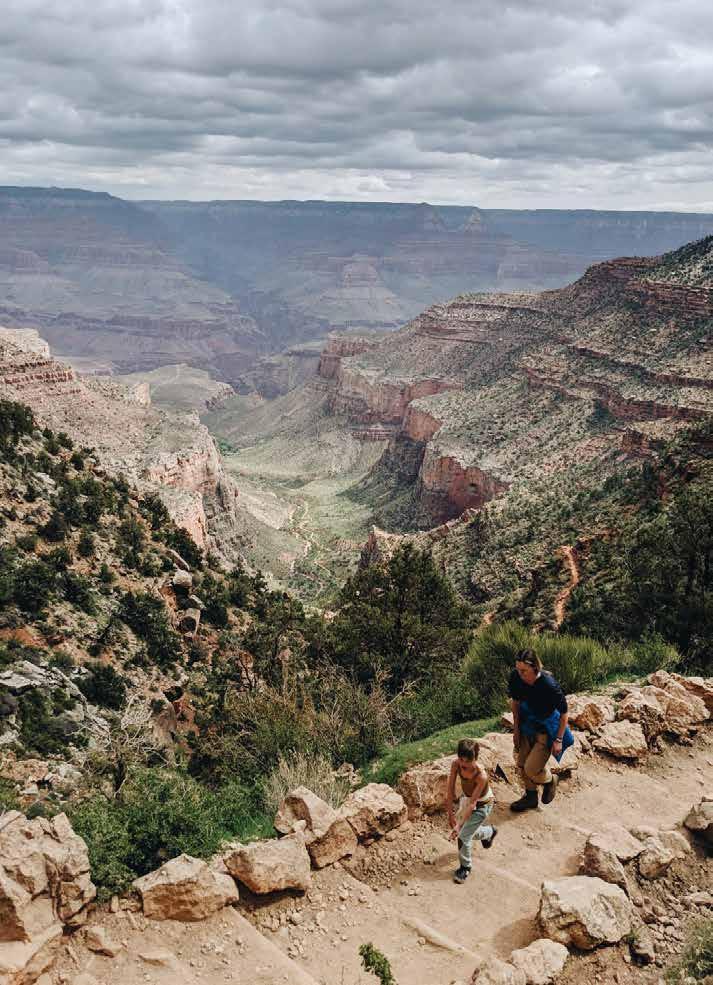
Next morning we’re up at dawn, to watch the sky turn pink with the sun, and after a quick breakfast we’re off, plotting our route, spotting that Las Vegas isn’t much of a diversion. Why not swing by the Strip and show the girls, we decide – it will be a laugh. So that’s what we do, because driving around with your home on your back means you can actually be spontaneous.
The morning is spent carving through the colourless desert, which on closer inspection isn’t colourless at all. There’s the sage-green of the bushes, the buttercup-yellow burst of desert flowers, the pink prickles of perfectly round cacti. And then the blue – that David Hockney blue of the desert sky that makes every photo look like an Athena poster from the 1990s.
But then we’re across the Nevada state line and back on busy highways, plunging towards Vegas, before being spat out on the Strip. And it is a laugh, pointing out the mini Eiffel Tower, the fake Venetian canals, the hordes of tourists sucking on giant multicoloured cocktails. Less funny is trying to navigate this monster through the fast-moving Vegas traffic. Because an RV is good for many things –the sense of freedom, the joy of camping without actually having to camp, that sort of thing. What it’s not so good at is darting through traffic, making quick moves, navigating around angry bellhops outside posh hotels.
From then on, we stick to our rural route, crossing into Utah – three states in one day! – where the dry earth folds in on itself and the road climbs up and up, until we reach Zion National Park. Here, the camp is postcard-pretty, with large RV plots set beside the babbling Virgin River, all overlooked by a huge hunk of rust-red mountain. We’re just outside the park proper, and trundle in on the tourist bus the next morning, liste-
ning to the Disneyfied Tannoy telling us about the park. And then it’s onto the trails themselves – busy with tourists, but easy enough to take a fork away from the crowd.
It’s the perfect introduction to America’s canyons: not as big or packed as the Grand Canyon, but with all the towering cliffs, surreally-shaped rocks and plunging drops you’d hope for. We spend the day hiking along the river, up to rocky lookout points, and for a picnic beside the Emerald Pools. That evening, we stroll along the pretty high street of Springdale, five minutes from our campsite, where the shops tout gems and minerals and the Camp Outpost restaurant does a mean burger. Then it’s marshmallows over the fire, beneath a clear sky filled with stars.
We soon adapt to the RV way of doing things. I even stop banging my head on the ceiling while I sleep. The pace of travel is slow, but that’s the point: travelling by RV is all about taking your time, seeing as much as you can, changing your route if you fancy. And each day is extraordinary, offering otherworldly views you don’t often find in Europe: soaring red mountains; layers of rock striped orange, yellow and green; vast, empty plains cut through with just one arrow-straight road. Tumbleweed begins to appear, throwing itself across the road in groups (don’t break, by the way; you can drive straight over them).
The girls settle into the hours on the road, spending their time listening to music, reading, or playing games on their tablets. Sometimes we all sing along to a strange mix of John Denver and One Direction. The mornings are the best, sitting outside in the early chill with a steaming cup of coffee, always with some incredible view to drink in, thinking I could do this forever, pack up our London lives and live the #vanlife.
‘Each day is extraordinary, offering otherworldly views you don’t often find in Europe: soaring red mountains; layers of rock striped orange, yellow and green; vast, empty plains cut through with just one arrowstraight road.’
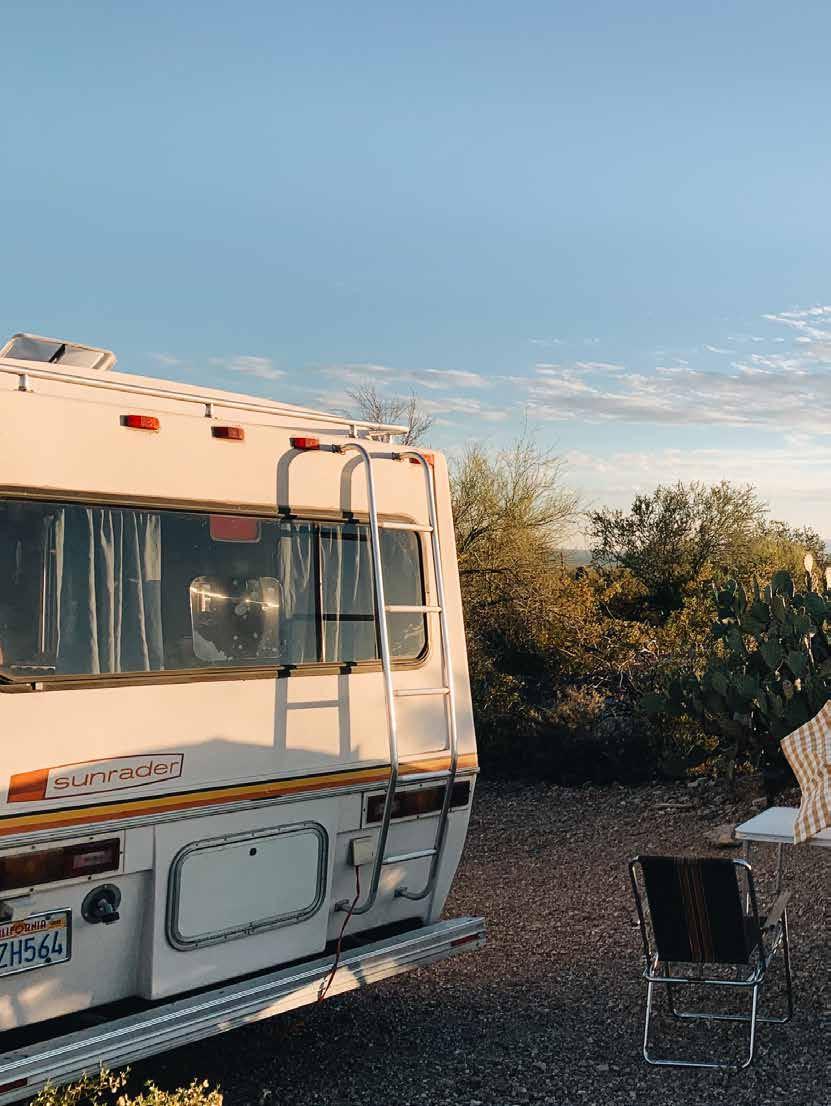

Lake Powell, on day four, is a strange, Mars-like landscape of barren mountains dropping down to the manmade lake – the sort of environment, it feels, that humans shouldn’t really be in. We spend a day on the Colorado River below the US’s second largest dam, being zipped along the freezing cold water, through 3,000ft-deep canyons to famous Horseshoe Bend.
The main town here is Page, a nice enough grid of shops and restaurants, ringed by depressing-looking hotel blocks – the Days Inns and Comfort Suites that seem to characterise the hotel scene along our route – and we’re glad of our cosy RV. And on we drive, through the breathtaking landscapes of Arizona to Monument Valley Tribal Park, where the awe levels shoot up another notch. This is Navajo land and Original Travel has arranged a community-run tour for us, our guide showing us the flap-topped mountains and weird rock formations immortalised by John Wayne’s movies – not that they’ve done the locals much good. Poverty
is rife among the Navajo, and the 18 families that still live within the park have neither running water nor electricity.
Our last night is spent in Gallup, New Mexico, a windswept town set beside a railway track with little to do other than dinner in a Cracker Barrel restaurant beside the highway. We don’t linger the next day, and we’re in Albuquerque by mid-morning. Time to leave our RV before heading north to Sante Fe to visit family. It’s a wrench, packing up and saying goodbye, knowing we’ll soon be back to the more predictable Airbnbs and hotels of conventional travel. Pre-planning aside, RV travel is a rollicking adventure, as wild and spontaneous as you can be with children in tow. There’s nothing silly about that. •
Contact one of our USA specialists: +44 (0) 20 7801 1750
The mornings are the best, sitting outside in the early chill with a steaming cup of coffee, always with some incredible view to drink in, thinking I could do this forever, pack up our London lives and live the #vanlife.
1. Enforce a strict on-board toilet rule
Number ones only, unless in an emergency.
2. Buy a pair of rubber gloves
Dumping your ‘black’ and ‘grey’ water is actually very straightforward (and not messy, or smelly, especially if you follow point 1), but donning a pair of sturdy Marigolds will make the process more palatable.
The best RV sites book up many months in advance, so you need to be organised. Original Travel will be able to make suggestions, but you’ll need to book your own spots. Government-run sites often don’t release availability until a fortnight before; be sure to log on the minute they are released to have the slightest chance of success.
Useful websites: www.recreation.gov, www.koa.com, www.hipcamp.com, www.thedyrt.com.
4.
It might be more eco than flying, but RVs are big beasts and take a lot of fuel. We found ourselves filling up every two days, at around $150 a pop.

Most RV sites come with ‘hook ups’ –water, electricity and sewage dumps. Your water tank will last you several days, but it’s not recommended for drinking, so best to carry several three-litre water bottles with you and fill up en route.
6. Buy a toaster
And a cafetiere. You can find both in most supermarkets for little more than $10.
7. Don’t expect it to be hugely sociable
RV-ing is a way of life in the US, quite literally, so many parks seem deserted at night – because the inhabitants are in their vehicles, watching their widescreen TVs. And Americans go to bed early, so if you’re hoping for campfire s’mores and singalongs, get it done before 9pm.
 By FRANCISCA KELLETT
By FRANCISCA KELLETT
Portugal is having a moment. From the fabulous capital city of Lisbon to the Atlantic archipelagos of Madeira and the Azores, the country has rediscovered its mojo.
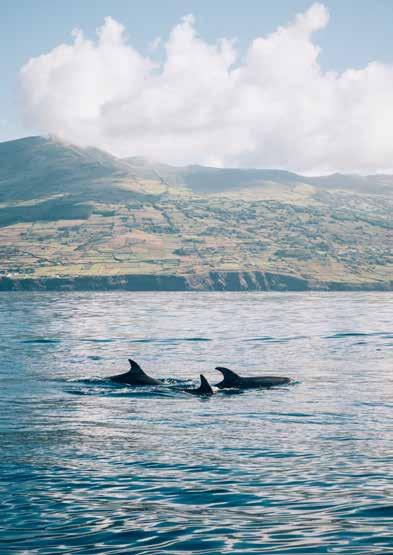

The lights in the bar went out. Complete darkness. So dark we couldn’t see our wine or our cheese or the barrel-vaulted ceiling decorated with thousands of repurposed wine bottles. The other diners were reduced to shadowy shapes, conversations cut short mid-sentence as everyone waited for the lights to come back on.
It was the end of August 2020. My boyfriend and I were sipping €3 copos of rosé in Bairro Alto, a buzzing, bar-filled neighbourhood in Lisbon which comes alive at night. The occasion: our final night in the city after a memorable month-long stay. We’d spent the past four weeks enjoying life as Lisbonites in Europe’s coolest city and weren’t even remotely ready to go home.
The trip was perfectly timed between two national lockdowns. We’d left London as soon as the first lockdown rumours started to swirl and made for the coast where we hunkered down with family in Devon and waited for our lives to resume. We even kept our London rental, convincing ourselves that we’d be back in a few weeks. Months passed, and like everyone, we did our best to adjust to the new normal, but then we received an email from our property managers; the landlords were selling the flat. The news sent us into a spin.
We’d spent the lockdown feeling quietly smug, grateful for the sea views, beach walks and garden space. Now we were faced with the prospect of returning to London to move out and search for a new place to live.
Then we had an idea. What if we could carve out a month or so between moving out of our current flat and into a new one? Relieved of rent-paying responsibilities, we’d be free to live somewhere else for a while. We dreamed of somewhere sunny; a place that had the beaches of Devon and the culture of London. Lisbon was the obvious choice. Portugal was one of the few countries open to British tourists at the time and we knew that the coastal capital would be the perfect base for our first foreign holiday since the pandemic had begun.
It's no secret that Lisbon is one of the cool kids in travel. You only have to scroll through Instagram to spot shots of the iconic yellow trams and buildings clad in azulejos (the country’s beautiful blue and white tiles). In recent years, the Portuguese capital has flown to the top of many traveller’s holiday hit lists, and with good reason. Maybe it’s because of the beautiful architecture, or the 300 days of sunshine per year, or the affordable prices. Or maybe, like that popular kid in school who also happens to be really nice and smart and a grade eight pianist, Lisbon’s appeal runs deeper than surface-level attractions.
Take the history of the city. Lisbon is the second oldest capital in Europe (after Athens) with a long and rich history stretching back more than 3,000 years to when the Phoenicians first arrived and established a port town they named Alis Ubbo (meaning ‘safe harbour’). The city was later inhabited by the Romans (who hung around for 600 years); the Muslim Moors, who claimed the city in the eighth century AD and promptly renamed it Lissabona; and the Christian Crusaders (who took the city in 1147 after a siege lasting several months).
Each group left their mark on the capital and its culture and even after the huge earthquake and subsequent tsunami in 1755 that destroyed much of the city, you can still track down traces of Lisbon’s past lives. We learned about the Muslim influences in the surviving Alfama Quarter, visited the impressive Jerónimos Monastery and Belem Tower - built during the country’s Age of Discovery - and toured the wealth of beautiful buildings that sprang up during the city’s rebuild, including the elegant harbour-facing plaza, Praça do Comércio, where kings and heads of state would disembark when visiting Portugal.
It’s not just the ancient history that has earned Lisbon a seat alongside Europe’s cultural capitals. The capital is home to Gothic architecture, impressive street art and
curiosity-filled museums for design lovers. And for the foodies, there’s a bounty of coffee shops, cocktail bars and international restaurants which are cementing Lisbon as one of Europe’s top foodie destinations.

Of course, you will have heard about pastel de natas , the famous custard-filled Portuguese pastries, but the country’s culinary scene goes well beyond these sweet treats. Portuguese food is known for being diverse; there’s fiery curries and flavourful chamuça (samosas) from India and peppery Piri-Piri sauce (a firm favourite in Portugal) from southern Africa. To understand why, you have to step back in time to the Age of Discovery. This era of intensive maritime exploration during the 15th and 16th centuries saw a production line of intrepid Portuguese explorers set sail for distant corners of the world and return with exotic new ingredients – from sugar cane and
saffron to black pepper and paprika - revolutionising the country’s cuisine and making Lisbon one of the most cosmopolitan spots on the planet. Jump forward to the present day, and you’ll find a generation of innovative young chefs who are drawing inspiration from these former colonies and finding creative new ways to shake up traditional recipes.
Our favourite place to experience the country’s spectrum of flavours was at the hugely popular Time Out Market. Built within the historic Mercado da Ribeira, the food hall boasts a saliva-inducing assortment of food stalls (some of which are headed up by the country’s best-known chefs) and a fantastic fresh food market where we bought as many plump purple figs as we could eat and watermelons so big we practically had to roll them home. We became regulars, taking a seat at one of the communal tables and dining tapas-
style, hopping from stalls serving traditional Portuguese fare to stalls serving sushi, before ending our meal – naturally – with a pastel de nata, the famous custard tarts so beloved of the locals.
After dinner, we roamed around the city. We sipped wine on sea-facing sun loungers, watched the sun sink into the sea from rooftop bars, and got very pleasantly lost in the web of cobblestone streets in Bairro Alto as the 250 or so bars began to come alive.
Nightlife in Lisbon is animated but understated. It’s less about strobe-lit clubs (although you’ll find those too) and more about lively bars serving craft beers and busy streets filled with night-time revellers. The wonderful thing about the city at night is that it feels so safe, with Portugal in general one of the safest countries in the world. The benefits of

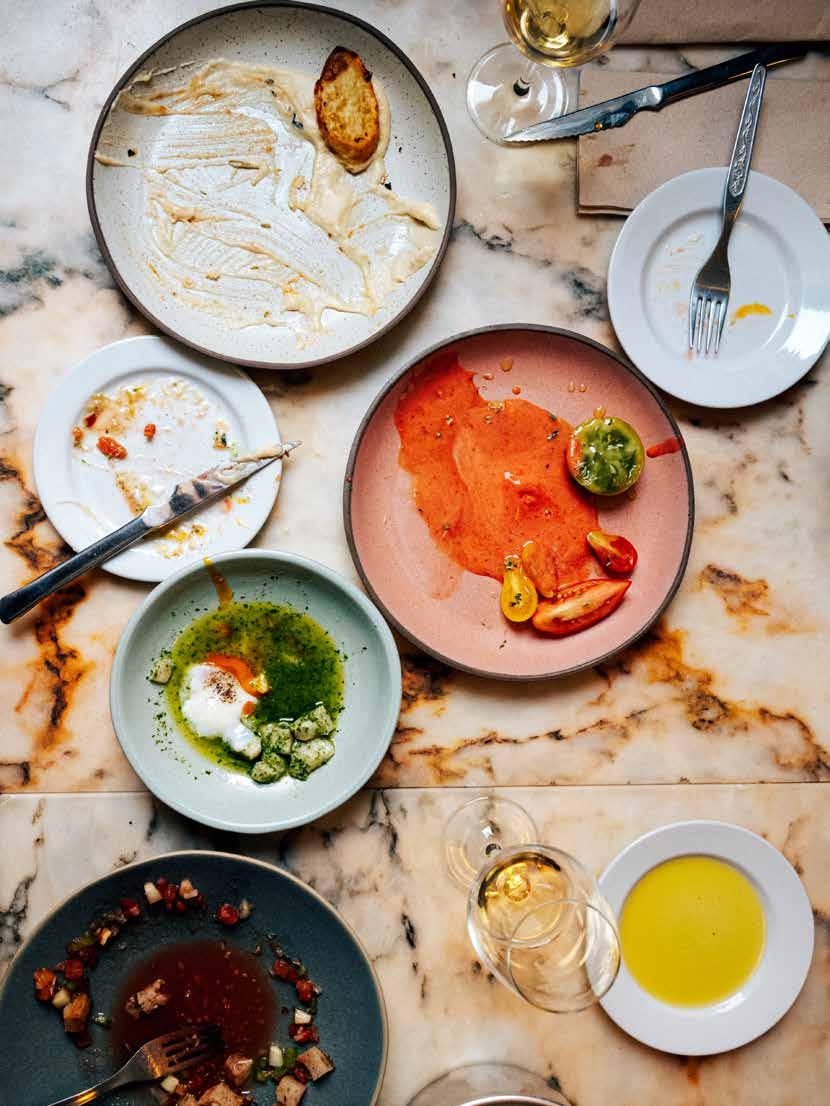
this are abundantly obvious. Not only are the local Lisbonites some of the most laid-back people imaginable, but tourists feel welcome and at ease in the city and can stroll around late at night without a second thought.
There's no getting bored rambling around Lisbon. For one thing, the city is outrageously beautiful, from the snaking streets of Alfama (the city’s centre under the Arabic occupation of the Iberian peninsula), to the elegant avenues of Principe Real (one of the city’s most upmarket districts). Throw in the cheerful yellow trams which have trundled along the city’s narrow roads since the 1930s, and the spaghetti tangle of streets adorned with intricately patterned cobblestones, and you’re left with a scene straight out of a story book.
The best thing about exploring Lisbon on foot is the views. The Portuguese capital is nicknamed The City of Seven Hills, so it’s no wonder the Romans felt so at home. Trek up any of them, and you’re gifted with glorious views over the River Tagus, 25 de Abril suspension bridge (the sibling to San Francisco’s Golden Gate Bridge) and an ocean of terracotta roofs painted gold by the sun. Few other European cities offer views like this. In Paris you could climb the Eiffel Tower (if you don’t mind joining the conga line of tourists) or in London you could scale a skyscraper (albeit for an office worker’s view of the city rather than a bird’s) but it’s not the same. In Lisbon you’re in the view; part of the picture.
Camera in hand, we huffed our way up to one of the many viewing points (known as miradouro) and savoured the scenic feast laid out below. Our favourite was Miradouro de Santa Luzia. With its flower-draped pergola and azulejo-tiled walls, this terrace sees its fair share of snap-happy tourists and Instagram influencers, but at sunset it’s truly spectacular. And if you’re lucky enough to be there when a fado band pitches up to serenade the crowd with the country’s melancholic folk music (which has earned UNESCO World Heritage status) the atmosphere is utterly magical.
Just west of the city centre sits Belem, one of the capital’s most popular neighbourhoods and the place where ancient explorers such
as Vasco da Gama and Prince Henry the Navigator set off on their 15th and 16th century seafaring adventures - a history that is celebrated by the iconic Padrão dos Descobrimentos (Monument to the Discoveries).
Along the coast, we caught the train to beautiful surf beaches (Lisbon boasts some of the best beaches and breaks in Europe) and spent our weekends kicking back in the bustling resort town of Cascais where we sipped mint-infused lemonades in a glorious little rooftop cafe and cooled down with bracing sea swims (the northerly winds stir up deep water making the sea temperature surprisingly cold even in the summer).
A little further away, just an hour’s drive from Lisbon, we fell in love with the secluded sandy beaches and scenic surf spots of Comporta - the fishing village surrounded by lush rice paddies and pine forests now beloved of celebs - and the ancient walled town of Obidos, with its labyrinth of cobblestone streets, whitewashed houses trimmed with bright yellow and blue (the colours of the royal coat of arms) and fairy-tale hilltop castle which had been converted into one of the country’s most luxurious pousadas – hotels in historic buildings.
Venture further still, and you’ll discover a whole lot more to love about Portugal. There’s the surf beaches of the Algarve; the vineyards of the Douro Valley; the historic hilltop towns; the exciting culture-filled cities; the reliable weather; the affordable prices; the excellent food; the excellent wine; the friendly people. Portugal is quickly becoming one of the most visited countries in Europe and it’s easy to see why. After only a month staying in Lisbon, we were utterly smitten and fully prepared to cast London aside and continue our love affair with Portugal. But our lives back home were waiting for us, and far too soon, it was our final night in the city.
We were in the wine bar in Bairro Alto, waiting for the lights to come back on. Minutes ticked by, and it was clear that this wasn’t going to happen any time soon. A waitress swept past, lighting the way with her phone and explaining that there had been a power cut. The whole street was down, apparently. From our seat by the bar, we watched as the
chefs put down their knives and spatulas and started chatting among themselves. The waiters moved around calmly, lighting extra candles. The room flickered and glowed. Conversations resumed.
That night in the bar summed up our trip perfectly. When we left the UK, it felt like we’d just lived through the longest power cut imaginable. The whole world had been thrown into darkness and life had been put on pause by the pandemic. Then we arrived in Lisbon, and it was like the lights had come on again. The month we spent in this vibrant, exciting, culture-filled city left us feeling re-energised and hopeful that the months ahead of us would be better than the months behind.
That power cut in the bar should have caused chaos. The kitchen was inoperable. The booking system was down. Staff were having to hotspot off a phone to get the card readers to work. Yet somehow that final night became one of the highlights of our trip. The staff in that restaurant were like other locals we’d met in Lisbon: cool, calm, seemingly unfazed by life’s little hiccups.
We left the bar and began the uphill hike back to our flat. As we huffed our way up the cobblestone street, my phone rang. It was the removals company. Somehow, they’d been double-booked and now they weren’t sure they could deliver our things in time for our move-in date. I imagined spending the first night in our new London flat on the floor - no mattress, no duvet - and felt my mood slump. Then I took a deep breath of Portuguese air, offered to pay more if they were willing to work overtime, and agreed on a price. Crisis averted, I ended the call, and we continued our trek: two cool, calm Lisbonites heading home for the night.
•
Contact one of our Portugal specialists: +44 (0) 20 7801 1750
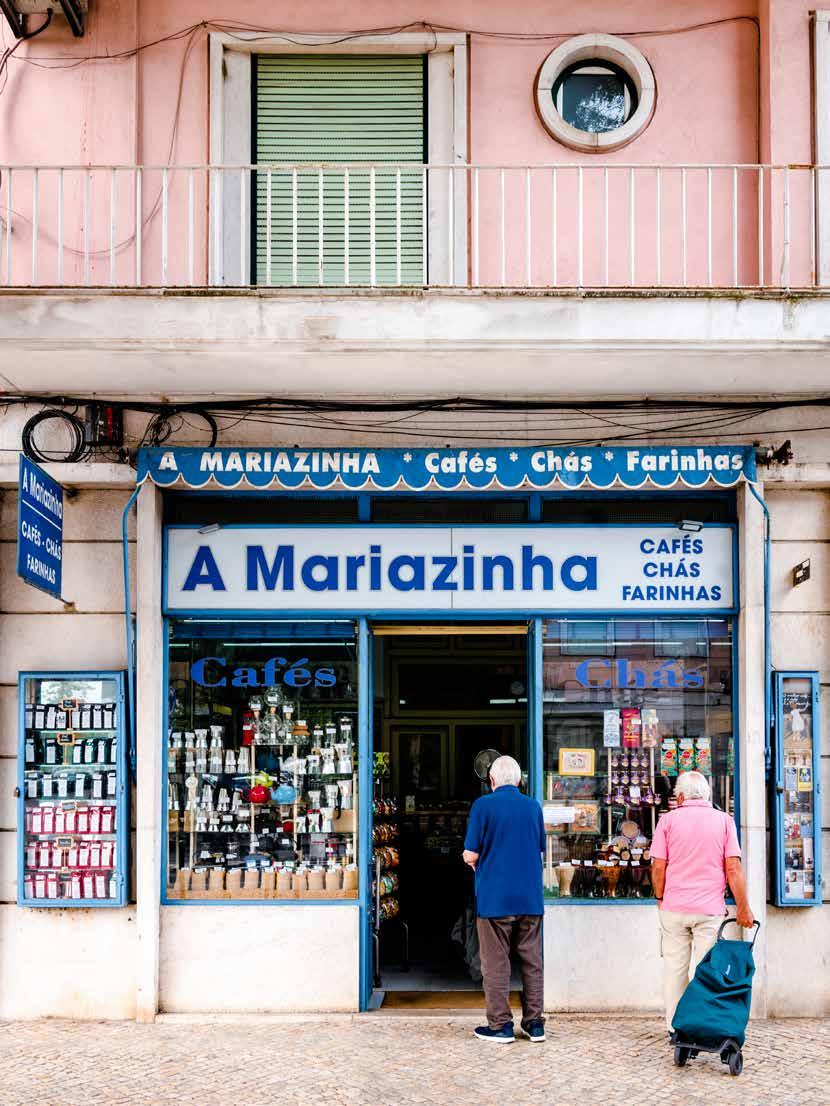
Portuguese navigators were in the vanguard of European exploration of the world’s oceans. Here's a potted history of the Portuguese voyages of discovery.
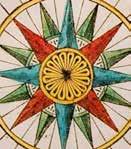

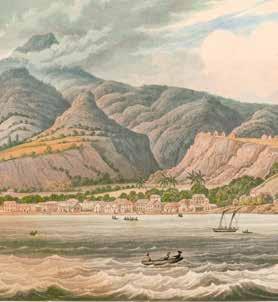
Portugal’s King John (married to Henry IV of England’s sister, incidentally) seizes the fortified port of Ceuta (in northern Morocco) in order to control sea trade through the Straits of Gibraltar. Portuguese fleets, many dispatched by John’s son Henry the Navigator, explore further along the African coast, hoping to bypass the Muslim-held territory in North Africa and the Middle East and find a sea route to India. The Atlantic islands of Madeira (1419) and the Azores (1427) are claimed, and Senegal (1445) and Cape Verde (1456) reached.
Under King Afonso IV, Portugal –until now a bit part player in Europe – turns its gaze to the seas and begins to send out trading missions on exploratory voyages.
Bartolomeu Dias rounds the ‘Cape of Storms’ (latter-day Cape of Good Hope), in the process proving that the Indian Ocean was accessible from the Atlantic. On his return to Lisbon, Genoese Christopher Columbus (married to a Portuguese woman), hears of Dias's exploits and tries to persuade the Portuguese King John that he can reach the Indies by sailing west. John rejects the idea, so Columbus seeks the support of Isabella and Ferdinand of Spain. Four years later he ‘discovers’ the Americas. 1415
The shallow-bottomed caraval boat is developed, its triangular lateen sails allowing upwind sailing and greater speed. By 1471 the Portuguese have reached the Southern Hemisphere and the islands of Sao Tome and Principe, and identify a new constellation – the Southern Cross – to navigate by.
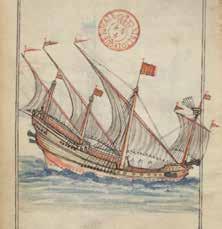

Castile (proto-Spain) and Portugal sign the Treaty of Tordesillas, dividing the world into two areas of influence split by a meridian line in the Atlantic; non-Christian areas west of the line are exclusive to Spain, and those east to Portugal. Some believe that the Portuguese had already discovered Brazil, hence their insistence on moving the line further west.
1494

Vasco da Gama leads four ships round the Cape of Good Hope and up the East African coast to Malindi (Kenya) where he engages the services of an Indian merchant who helps them cross the Indian Ocean, reaching Calicut in India in May 1498. 75 years later, Da Gama's voyage inspires Luis de Camoes, a fellow seafarer, to write the epic poem The Lusiads , considered Portugal's greatest literary work. De Gama and many other militantly Christian Portuguese explorers also pursue a brutal campaign of violence against those they encounter, especially Muslims.
A larger fleet is assembled to reach India but makes landfall in Brazil, which the Portuguese (this time) claim. An expedition reaches present-day Rio de Janeiro in 1502. Meanwhile, Portuguese navigators visit Madagascar (1500), Sri Lanka (1505) and Oman (1507). The Eastern expansion gathers pace as Albuquerque and Alaves reach Malacca (Malaysia) and Siam (Thailand) in 1511, and China in 1513.


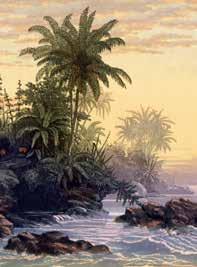
Portuguese traders become the first Westerners to reach Japan, entirely by accident. Their trading station in Nagasaki proves to be the most easterly of a series of bases across the Orient. In the western hemisphere, Portugal is the chief architect of the slave trade from Africa to the Americas, which the British would later embrace, but then abolish.
Portuguese navigator Ferdinand Magellan sets sail on another Spanish-sponsored voyage to find the western route to the Indies. Three years later a lone ship limps into the port of Sanlucar de Barrameda in Spain, the crew of 22 on board in the process becoming the first people to circumnavigate the globe. They were the only survivors from five ships and 270 men. Magellan himself was slain in the Philippines, while the others succumbed to a combination of disease, storms and skirmishes with locals.

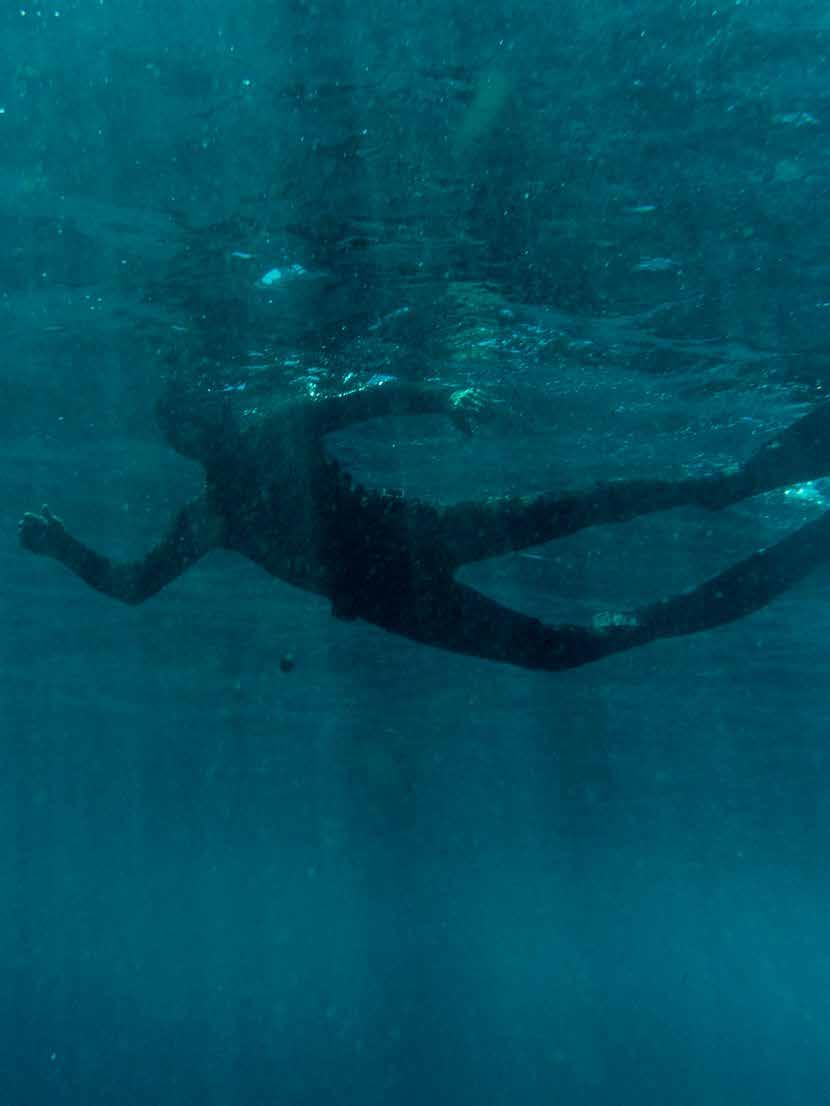 words by LUCY DUNN trip by ORIGINAL TRAVEL
words by LUCY DUNN trip by ORIGINAL TRAVEL
dive into a perfect family destination
As a mother of two teenage boys (plus one husband who is 54 going on 16) holidays are never low-key, relaxing affairs. There was the ‘quiet week’ in Cornwall where I was made to fling myself off a cliff while coasteering. The ‘laidback sailing holiday’ in Corfu where I clung on for dear life in what felt like a force nine while the boys took the helm and whooped into the wind. And not to mention all the ‘chilled’ camping trips where tents have leaked, beds have deflated and the only chill was temperatures approaching Siberian levels.
But a holiday that is both relaxing and adventurous? Did such a thing exist?
A diving trip to the Azores ends up the frontrunner. We’d done our basic PADI diving qualifications the summer before so the obvious next step – according to the boys –was ‘diving with sharks’. Employing the diversionary tactics only mums of teenagers know how, I point out the islands’ canyoning, hiking, surfing and 4x4 safari potential while eyeing up a range of boutique hotels and eco-resorts. Who knows, maybe this would be the holiday I’d finally get some sunlounger time.
The Azores is an archipelago of nine islands spread over 370 miles in the middle of the Atlantic. It is an autonomous region of Portugal, about 900 miles west of Lisbon and a three-and-a-half-hour flight from London. It’s curiously untouched by mass tourism. A clue might be the weather: come prepared for four seasons in one day. But while the islands are at the mercy of transatlantic elements, a quirk of the Gulf Stream means that the Azores rarely gets cold – even September and October can reach a balmy 24C (75F).
Flying into the largest, São Miguel, the first thing you are struck by is how remote the islands are – from 30,000ft up, these rocky outcrops look tiny in the vastness of the Atlantic.
The second thing you notice is how green everything is. Sitting where the Eurasian, North American and African tectonic plates meet, the Azores are a geological hotspot and
as a consequence, a lush eco-paradise. The islands have not been dubbed the ‘European Hawaii’ for nothing: there are over 26 active volcanoes on the Azores, eight of which are underwater, but there hasn’t been a major eruption since 1957. The result is undulating hills wrapped in dense forests, punctuated by hot springs, geysers and majestic calderas (crater lakes) rising over dramatic black beaches.
Each island has its own distinct feel so definitely do some island hopping if you can. Begin on São Miguel, which features most of the Azores’ big tourist ‘headline acts’. At 40 miles long and nine miles wide, the island is easy to get around, although hiring a car is still advisable.
First on your list should be Sete Cidades or ‘lagoon of the seven cities’, which is actually two different-coloured lakes – one a brilliant jade, the other a translucent azure bluenestling in a huge volcanic crater. The best viewpoint is from Visto de Rei, next to the Hotel Monte Palace, a crumbling concrete blot on the landscape. The five star hotel was built in the 80s with big package crowds in mind but they never materialised (the Azores remains resolutely untouristy to this day) and it shut up shop within a few months. The site is now free to explore (with caution) and commands some of the best views of the caldera below.
We take a long hike round the perimeter of the crater – stunning 360° views all round. The sheer beauty of the Azores takes your breath away and commands so much of your attention that real life is put on hold. It forces you to switch off – and when we sit around at dinner even the boys want to chat rather than sink into their phones. This I’m grateful for as there’s added poignance to this holiday –it’s my eldest’s last before he heads off to university, so every day together counts.
The second sight to tick off is Vila Franca do Campo. A small island off the coast and accessible by a ten-minute ferry ride, its iconic crater lagoon adorns nearly every Azores postcard. Blue hydrangeas are famous emblems here too and clouds of them line the country lanes – next to fields of cows, so
many cows. As Portugal’s biggest dairy producer, The Azores boasts more livestock than people, and they climb like mountain goats, clinging to the impossibly steep hillsides.
Every road trip uncovers hidden gems. Like Caldeira Velha. Located near the town of Ribeira Grande, this secluded thermal pool beneath a cascading waterfall is reached by a winding path through tall trees and Jurassic ferns. A short drive away is the Gorreana Tea Factory, on the north coast, which has operated as a family-run plantation since 1883. Stroll through the clipped shrubs looking out onto the sea and take a tour of the factory before sampling the green or black chá in the tea room.
We are keen to explore more. The next island on our itinerary is Pico, a 40-minute flight via propeller plane from São Miguel. The second largest island is rocky, dominated by a brooding (but dormant) volcano of the same name. Vineyards criss-cross the foothills, the bright green vines punctuated by the darkness of the basalt. Each vine is grown in small plots penned in by lava rock walls to protect them from the elements, its viticulture so unusual that the vineyards were designated by UNESCO as a World Heritage Site in 2004. The wine’s not bad either.
At 8,000ft tall, Pico is the tallest peak in Portugal. With fumaroles releasing steam and heat at the top, it takes three hours to climb to the summit, and getting there to catch sunrise or sunset is an experience not to be missed. (A guide is advised).
But we aren’t here for the mountain – we are here for the diving. And thanks to its incredible underwater volcanic rock formations, there is plenty to see. This is what makes the Azores the best diving locations in the Atlantic – that and the fact that visibility reaches nearly 30 metres between May and October.
I am a nervous diver at the best of times and tend to catastrophise for no good reason. After a sleepless night fretting, I wake up to a day set for perpetual drizzle. No ducking out with a ‘headache’ for me.

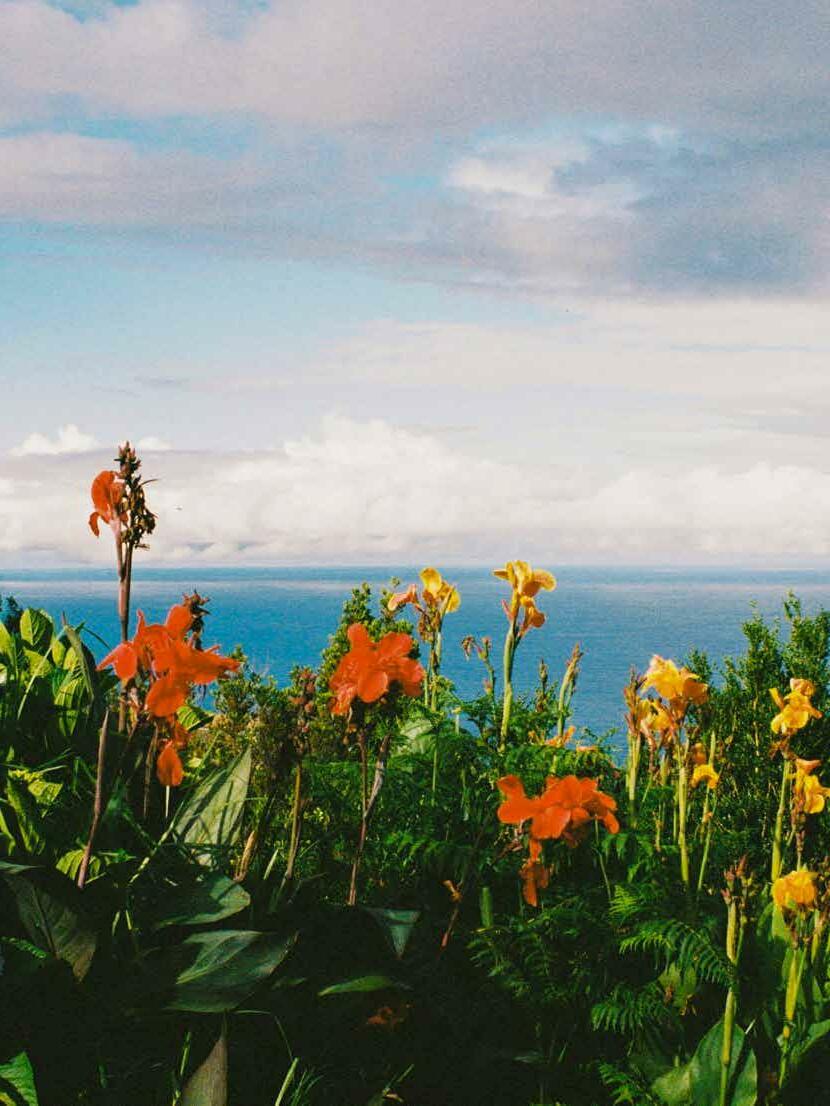
Sharks live at least four miles out to sea, the instructors tell the boys when we arrive at the dive centre. Since we’re still rookies who haven’t quite got our buoyancy mastered, it’s suggested that we stick to shallower waters –lest we bob up to the surface and are mistaken for seals (i.e. lunch).
Thank goodness for that. And, as soon as we kit up, do a refresher, then submerge and glide down, slowly sinking deeper and following the line of the lava trails, all other worries are forgotten. Nothing gives you more of a euphoric feeling of freedom than gliding along weightlessly, taking in the sights of a colourful underwater world. The waters are warmed to between 17°C and 24°C so they teem with wildlife – from Mediterranean parrotfish to territorial grouper, elegant manta rays and bug-eyed moray eels.
Then there are Pico’s most famous residents: whales. While sperm whales are a common sight, many other species including blue whales (the world’s largest mammal) also pass through on migration routes. Well-organised tours run from Lajes Do Pico and go to great lengths to whale or dolphin watch responsibly. The only irony is that the vigia (watch towers) dotted around the coast – and now manned by spotters who direct the tourist boats – were once used for whale hunting. Whaling – introduced by the Americans in the 18th century – played a part in the Azorean economy until as recently as 1987.
We swim with dolphins – or at least try to. They chase the boat playfully but the minute we stop and lower ourselves into the water they disappear with a silvery flash. The wind drops. A stillness descends. The sea is an intense cobalt blue. Suddenly, out of the silence, a shout from the driver: ‘Portuguese Man O’ War, portside!’ We climb back in the boat sharpish and beat a retreat.
The boys want to explore some caves, but I subscribe to the seen-one-cave-seen-‘em-all camp so leave them to it and steal some hours by the pool. Gruta das Torres, near the town of Madalena, on the western end of Pico, is not the place to go if you have claustrophobia like me. Gruta is actually a lava tube and at over 3.2 miles long, it’s the longest in the Azores. Once upon a time it would have been filled with molten lava and its walls bear the scars of previous eruptions. Lava stalagmites decorate the dank caverns.
Why do two-week holidays speed up the minute you turn into the second week? We fly back to São Miguel and spend a morning exploring the capital Ponta Delgada. A former fishing village, it flourished in the 17th and 18th centuries and is now the perfect place to sample the island’s delicacies: petiscos (Portuguese tapas), creamy Sao Jorge cheese and bolo levedo, a sweet and very moreish muffin bread. Fresh fish is plentiful here – and unlike some places in the world, you know it’s fresh by the sheer variety you are offered on every menu. Lapas (dollar-sized grilled limpets) swimming in garlic butter are a local speciality here but weren’t a hit with the family, unlike the queijadas de vila franca, deliciously creamy custard cakes unique to the islands.
Our final stay is in Furnas, on the eastern side of São Miguel. Sitting on top of the crater of a dormant volcano, the town boasts geothermal springs and geysers rich in sulphur, hence the faint whiff of rotten eggs that lingers in the air and a steamy cloud that hugs the valley. In the 18th century the town became famous when the water was thought to have medicinal properties to help heal various ailments. It was then that the elegant Terra Nostra house was first built. Now a hotel and restaurant, its star attractions are the thermal pools and 30 acres of botanical
gardens. Take old swimwear – Original Travel advised me that the sulphur-rich waters can stain.
Don’t leave Furnas without a trip around the lake just outside the town – a six-mile circular trail makes for a fairly easy morning stroll. Finish at the beach where you can watch Azoreans use the thermal heat of the ground to slow-cook local specialty, cozido das Furnas, a hearty stew of meat and vegetables. Every morning Furnas restaurants bury a pot and leave it to simmer for a few hours, after which they’re dug up and transported back into the town. It’s a touristy thing, not cheap and you have to book in advance, but fun nonetheless. After all, it’s not every day you get to eat something cooked by a volcano.
It’s not every day you go somewhere as original as the Azores, either. But all good things have to come to an end. And it’s not the only sad goodbye that summer – a few weeks later we wave our eldest off to uni.
I’m going through my photos for this article. My sons hover around the laptop as I sort. ‘Mum, that was the best holiday,’ they recall. ‘Top-notch.’ I have to agree. No collapsed tents, no death defying jumps, definitely no soggy sleeping bags – just me, my husband and two sons making memories of a lifetime together. Just what a holiday should be. It took a while, but I think we might have finally got this holiday thing cracked. •
Contact one of our Portugal specialists: +44 (0) 20 7801 1750
‘On the island of São Miguel, clouds of blue hydrangeas line the country lanes next to fields of cows – so many cows –climbing like mountain goats, clinging to the impossibly-steep hillsides.’
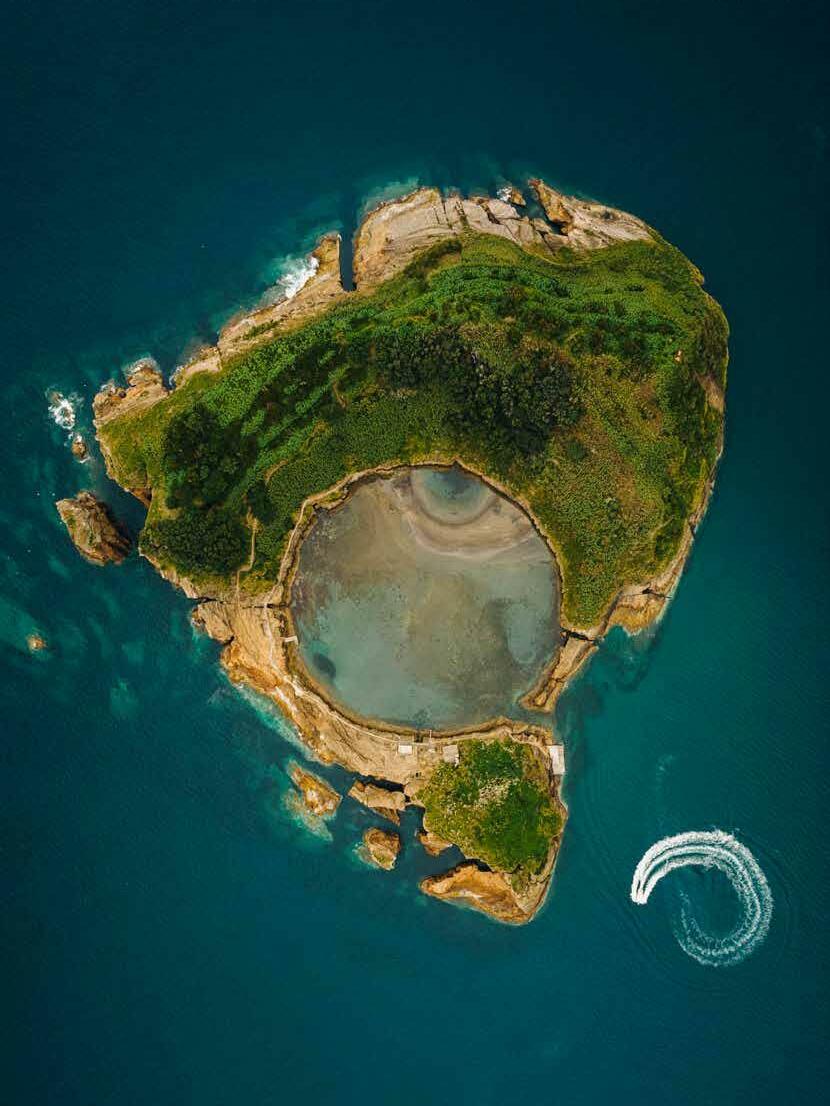
Days 1 - 2
Portugal’s capital is a foodie’s dream, cultural dynamo, historical gem, architectural marvel, nightlife hotbed and all-round winner made even better with top tips from our Concierge.


Portugal is a country riding the crest of a wave. Lisbon is arguably Europe’s current coolest capital, the Alentejo winemaking region is finally on the radar and on the subject of waves, the country’s Atlantic coast, with its boho surfer vibe, feels more like Brazil than Europe. We regularly brush up on the classic destinations, as well as exploring further from Portugal’s beaten path.
Your Concierge
Ricardo is Portuguese but lived in UK for many years so knows what Brits tend to like and dislike. He frequently travels around Portugal scouting out new experiences and will be able to recommend where to shop in Porto, book surf lessons in Alentejo or reserve a table in Madeira’s finest restaurants.
• Size: 35,560 square miles
• Capital: Lisbon
• Population: 10,135,000 (Aug ‘22)
• Density: 288 people/square mile
• Pick a Number: 9 – the number of main islands in the Portuguese island archipelagos of Madeira (two) and the Azores (seven).

• When to Go: Lisbon and Porto all year round except high summer; the coast, Madeira and the Azores (especially for diving) in summer

One point of contact
Contact one of our Portugal specialists on + 44 (0) 20 7801 1750
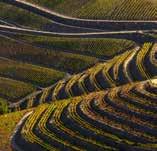
Just an hour or so inland from Porto is the luxurious Six Senses Douro Valley spa hotel, your home in this beautiful wine region. Settle in for some serious R&R, expert wellbeing treatments and high-class local cuisine.

Take the local train up the valley before a visit to one of the best local wine producers for a private guided tour of the vineyards, tastings of Portugal’s under-rated local wines and lunch. Return ‘home’ by private boat charter along the Douro.
Night Train to Lisbon (2004) by Pascal Mercier, a novel set in mid-20th century Portugal during the dictatorship of Antonio Salazar.
Gloria (2021); a Netflix spy thriller set in 60s Portugal where a small village becomes a proxy Cold War battle zone between Western and Soviet agents.
To anything by Amália Rodrigues, the unrivalled queen of fado , the melancholic and moody Portuguese folk music you’ll hear throughout a stay in Lisbon.



Areias do Seixo: Stylish ecolodge on the Costa do Prata an hour north of Lisbon and adjacent to lovely surf beaches.
Taberna Da Rua Das Flores: tiny tavern serving equally tiny tapas-style dishes in Lisbon. Don’t miss the mackerel tartare. Armazem do Sal: Traditional service and cuisine (and Michelin recognition) in the Madeiran capital, Funchal.
Portugal’s global culinary heritage: On a guided tour of Lisbon’s food markets to see – and taste – Brazilian, Angolan, Goan and Indonesian influences.

Portugal’s Atlantic coastline is perfect for surfers of all standards. Stay in lovely hotels hidden deep in national parks and learn to surf (or improve your technique) with expert instructors on all but guaranteed sets.
The vertiginous island of Madeira is crisscrossed with levadas (irrigation channels) with walking trails alongside. Hike along cliff edges with dramatic Atlantic views and past waterfalls on some of Europe’s most spectacular trails.
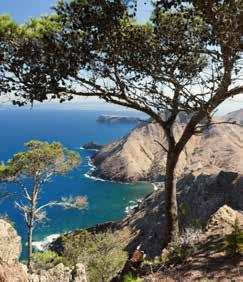
Days 1 - 2
Portugal’s capital is a foodie’s dream, cultural dynamo, historical gem, architectural marvel, nightlife hotbed and all-round winner made even better with top tips from our Concierge.
Days 3 - 4
Head inland for a stay in a chic boutique hotel surrounded by cork forests on a working wine estate in the lovely Alentejo region. Go on a riding safari or visit neolithic standing stone circles and the pretty city of Evora
Coimbra: A cultural hub with a glorious medieval city centre, thrumming to the haunting notes of the guitarra (Portuguese guitar) and home to the country’s oldest and most prestigious university.
Days 5 - 7
Head back to the coast for a final stint on the beach in the boho hangout par excellence of Comporta. Lounge on the beach, shop in chic boutiques and enjoy long, long lunches in fine seafood restaurants.

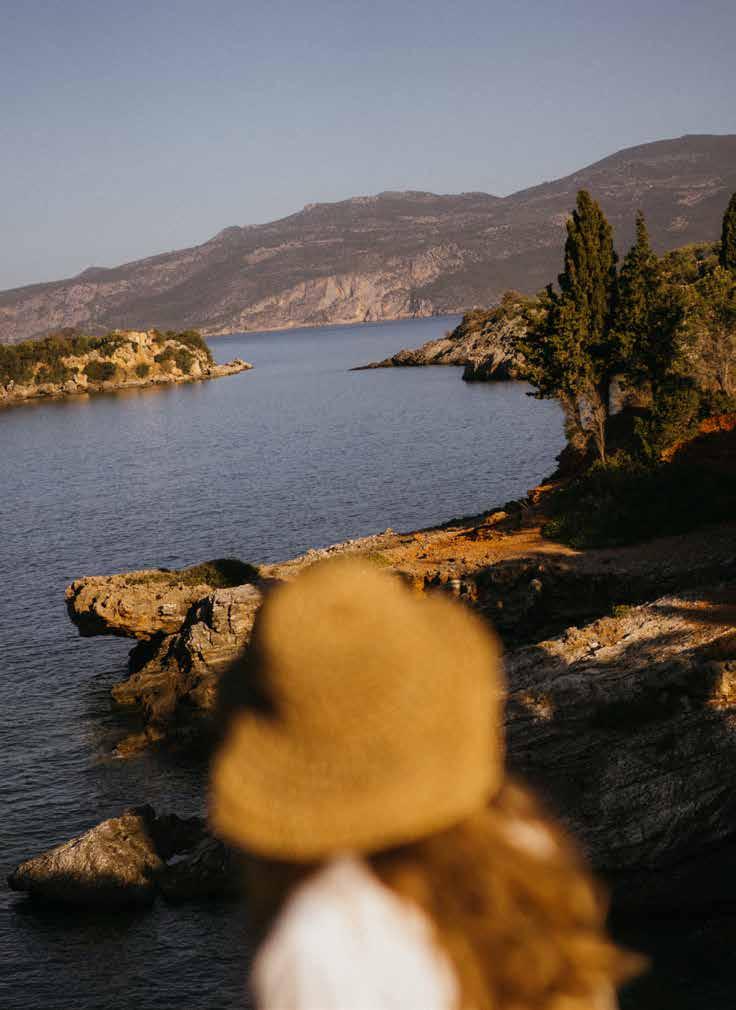
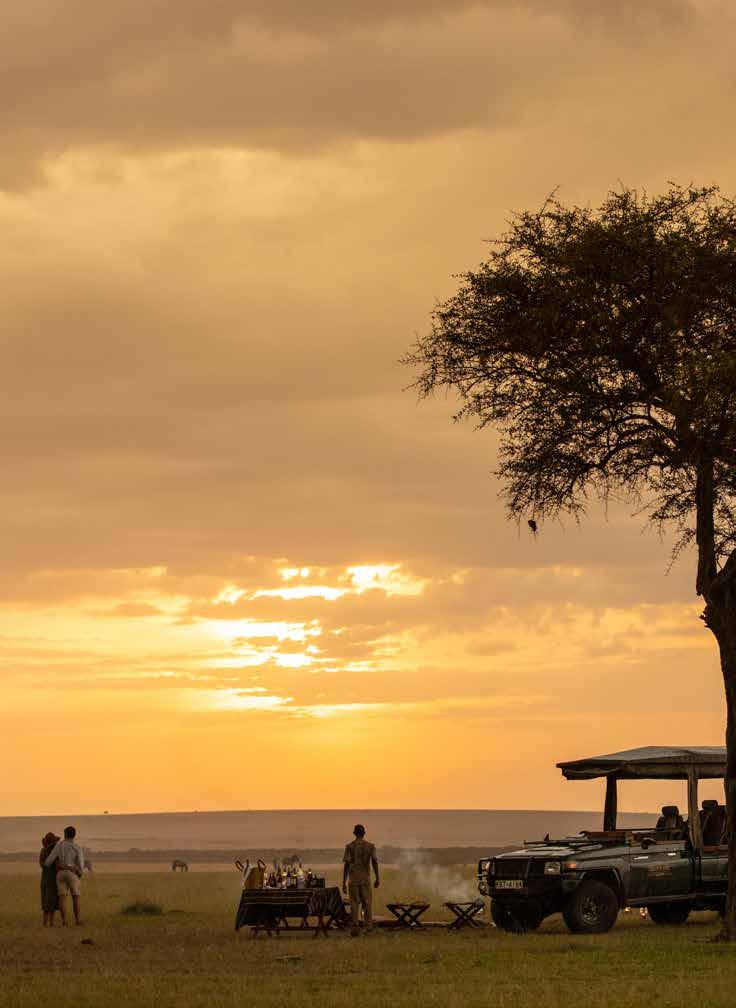
By using Carbon Balanced Paper for this magazine Original Travel has balanced the equivalent of 2,624 kgs of carbon dioxide. This support will enable World Land Trust to protect 501 square meters of critically threatened tropical forest. Certificate number CBP009535.
; Blue Collectors/Stocksy, Tinker Street/Cubby Graham/Gallery Stock, Finn Beales/Gallery Stock, Brian lackey/Gallery Stock (p.118) ; Rita Puig-Serra Costa (p.120) ; Bisual Studio/Stocksy (p.121) ; Daniel Hundven-Clements/Gallery Stock (p.122) ; Pia Riverola (p.123) ; Julia Volk/ Stocksy (p.124-125) ; Rhiannon Taylor (p.126) ; Faustine Poidevin (p.127) ; Julia Nimke (p.128-129) ; Birgit Sfat (p.130-145) ; Jérôme Galland (p.146-149) ; Lucy Laucht (p.150-153) ; Nikada/Getty Images/iStockphoto, Francesco Abrignani/stock.adobe.com, BnF/Manuel de pilotage à l'usage des pilotes bretons, G. Brouscon, Keith Lance/Getty Images, Library of Congress (p.154) ; Digital Vision Vectors/Getty Images, BnF, Duncan Walker/Digital Vision Vectors/Getty Images, BnF/Atlas nautique du Monde, dit atlas Miller, Digital Vision Vectors/Getty Images (p.155) ; Daniel Espirito Santo (p.156-158) ; Mara Bolumar (p.159) ; Daniel Espirito Santo (p.161) rh2010/stock.adobe.com, Bruno Ismael Alves/stock.adobe.com, Luis Viegas/ stock.adobe.com (p.162) ; Jérôme Galland, Nuria Val, Avieta Claessens/stock.adobe.com, Daniel Espirito Santo, Georg Knoll/LAIF-REA (p.163) ; Marco Arguello (p.164)

